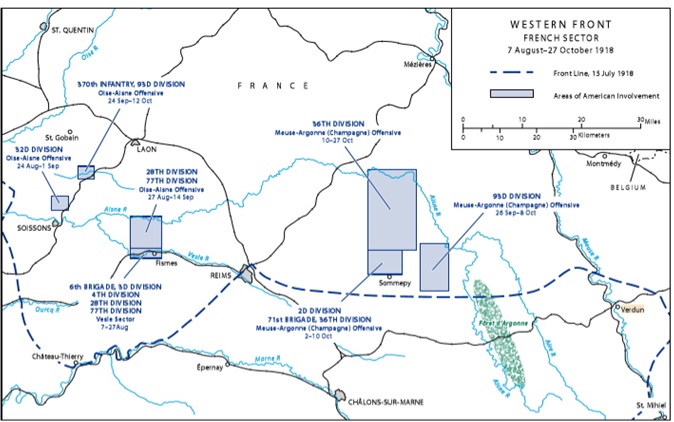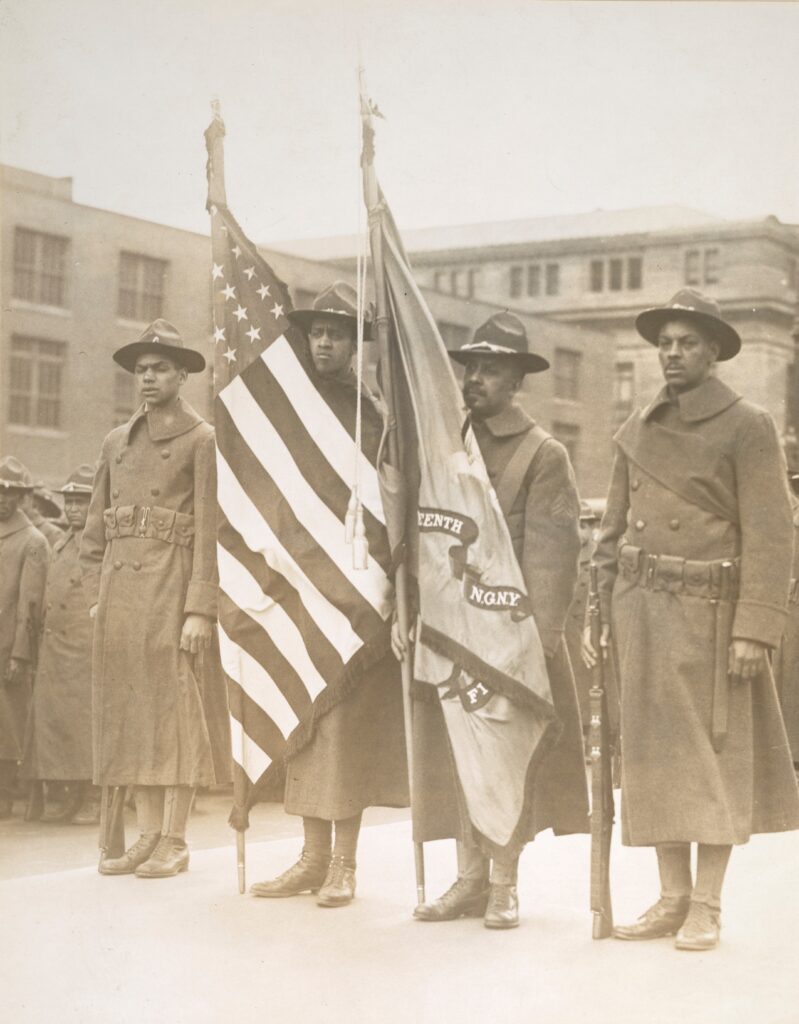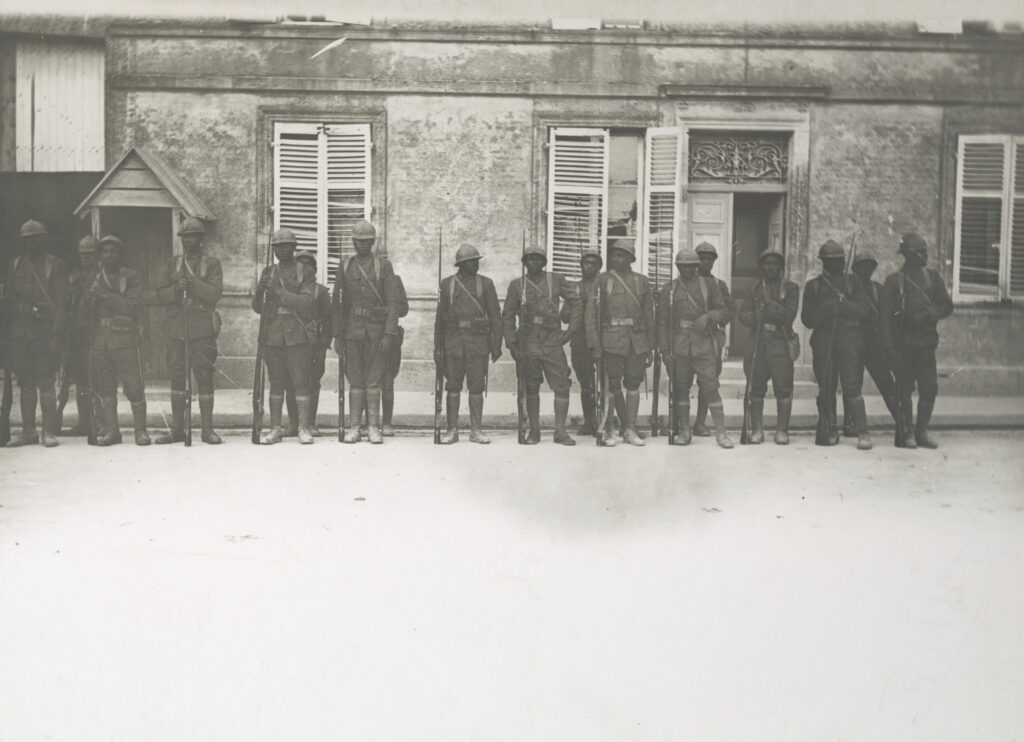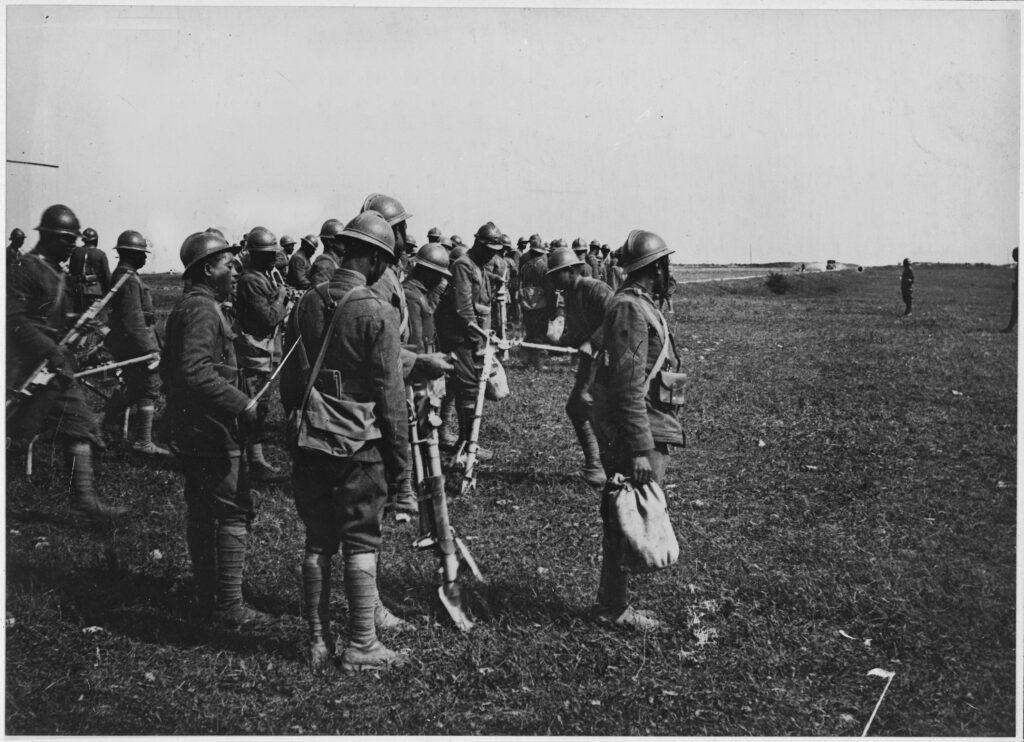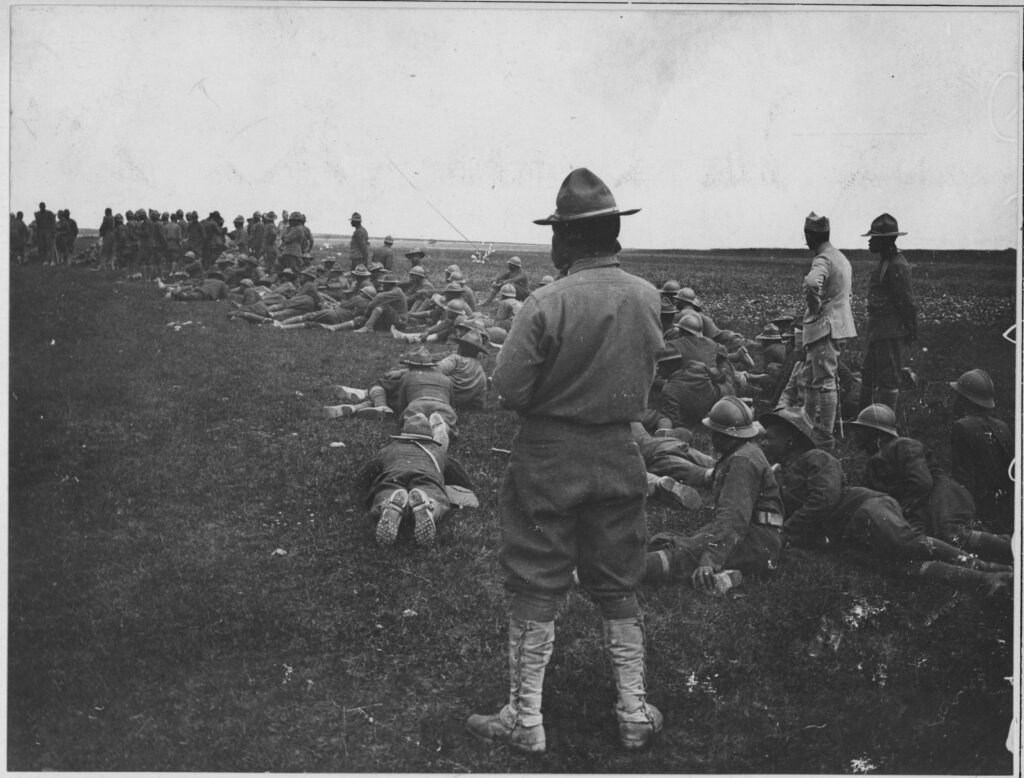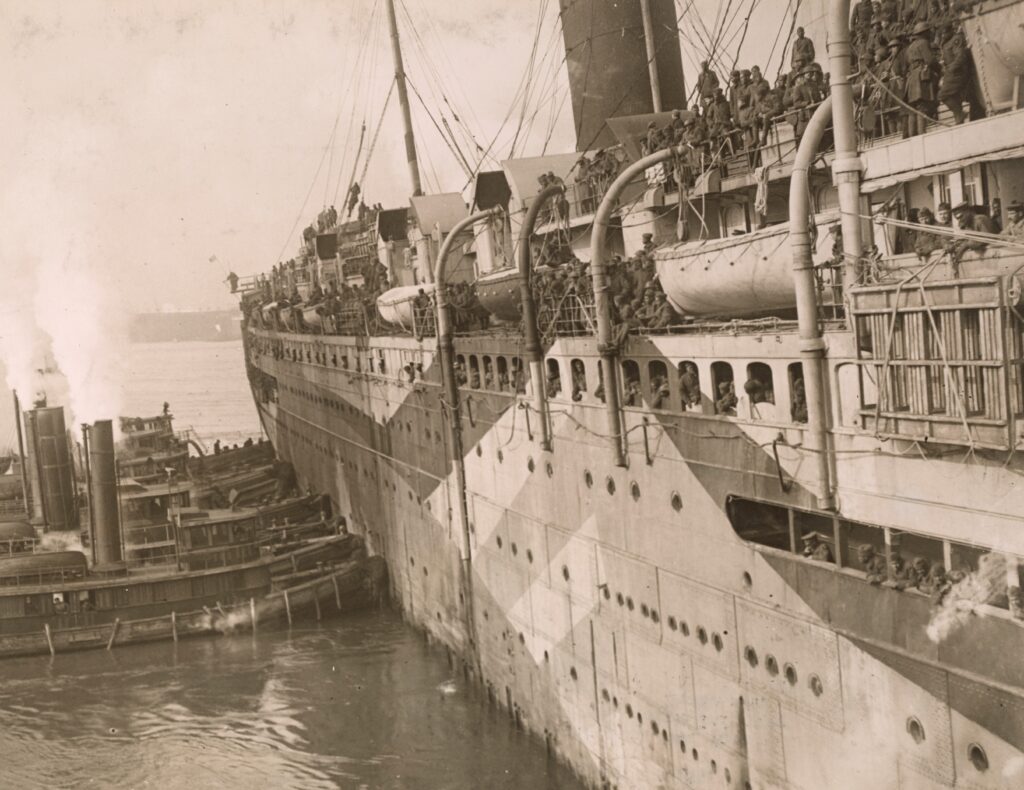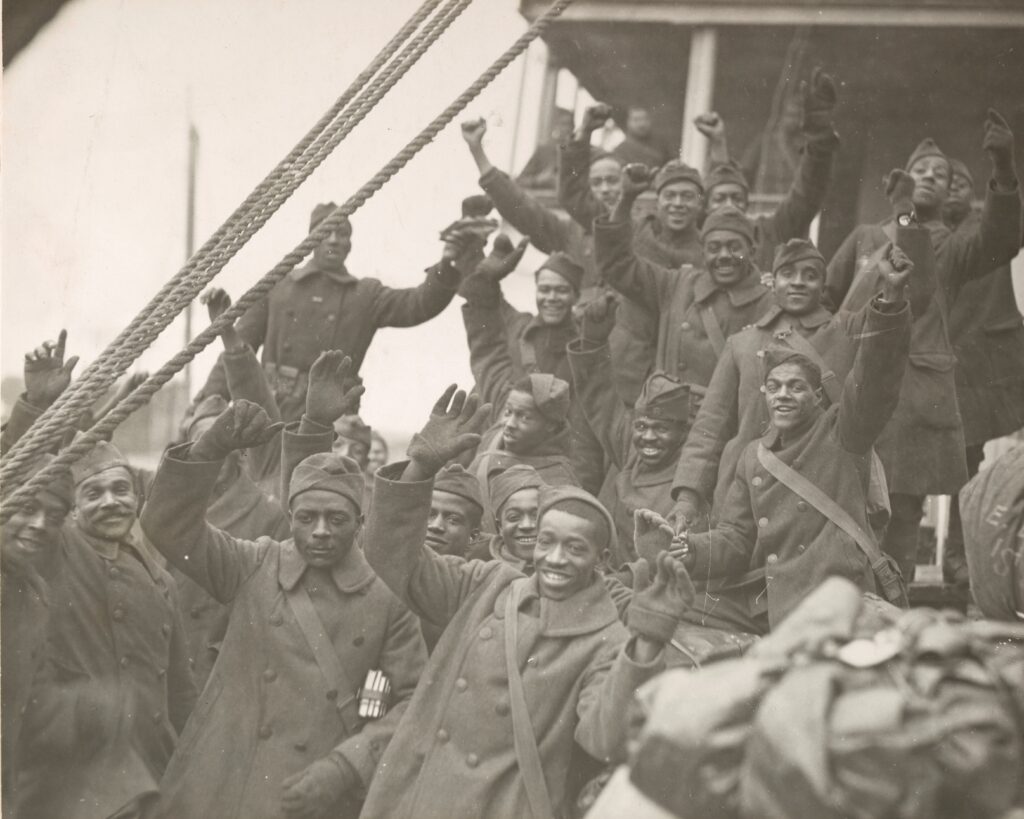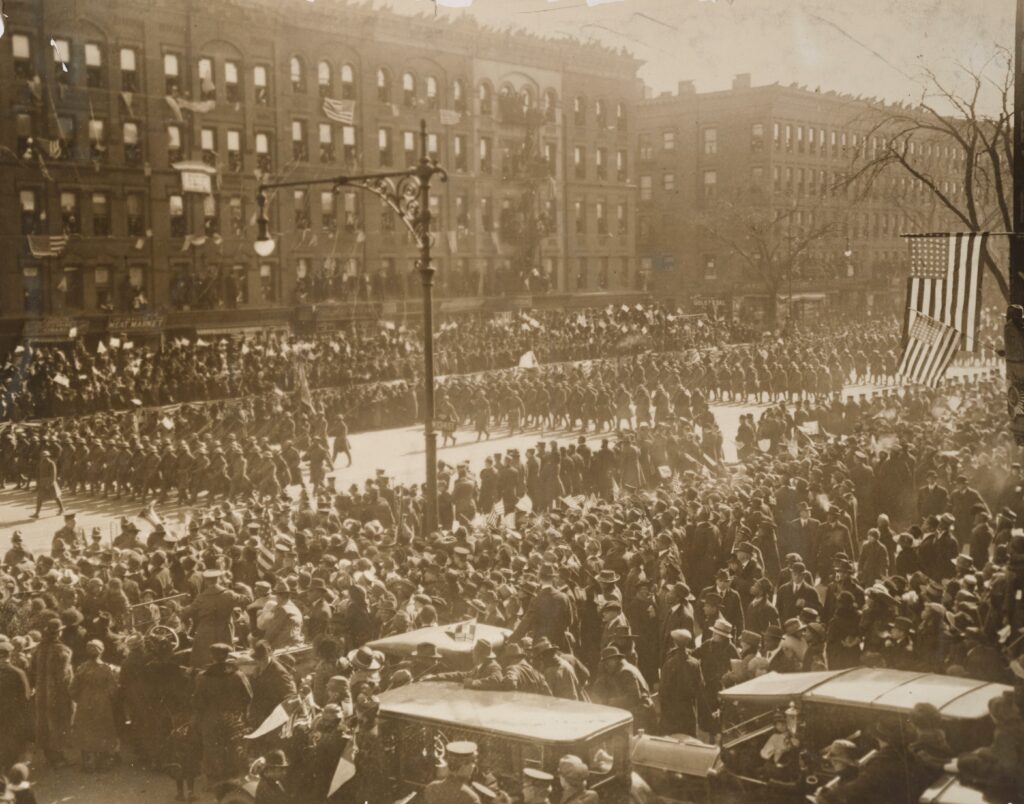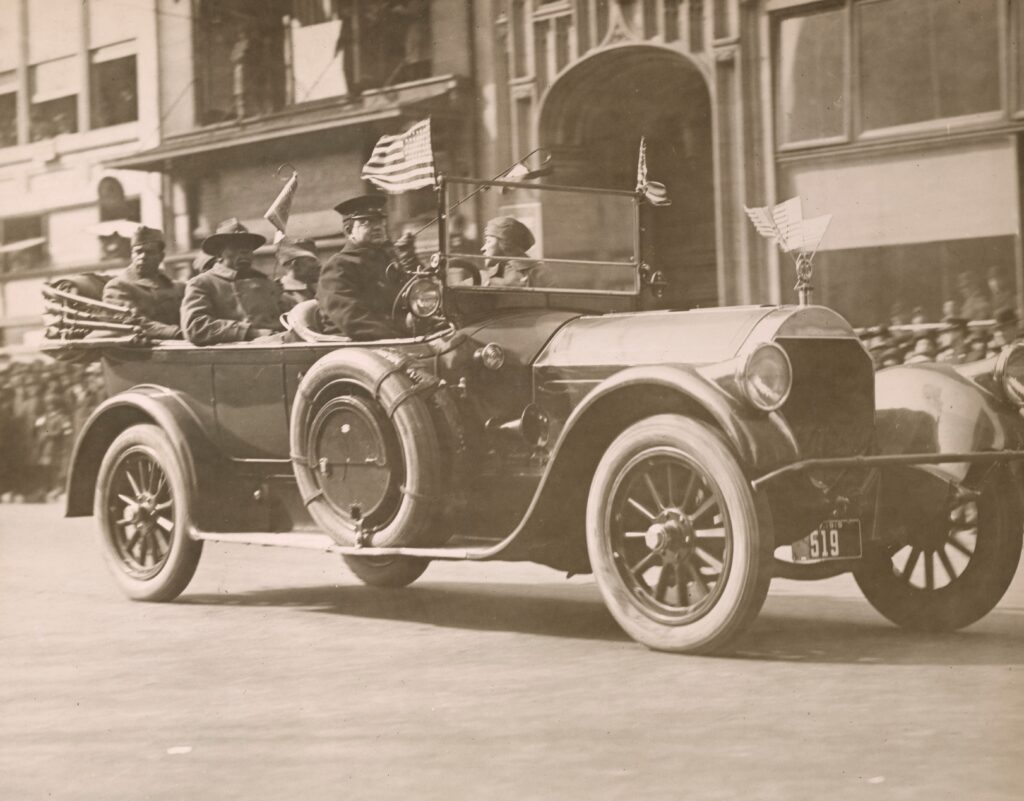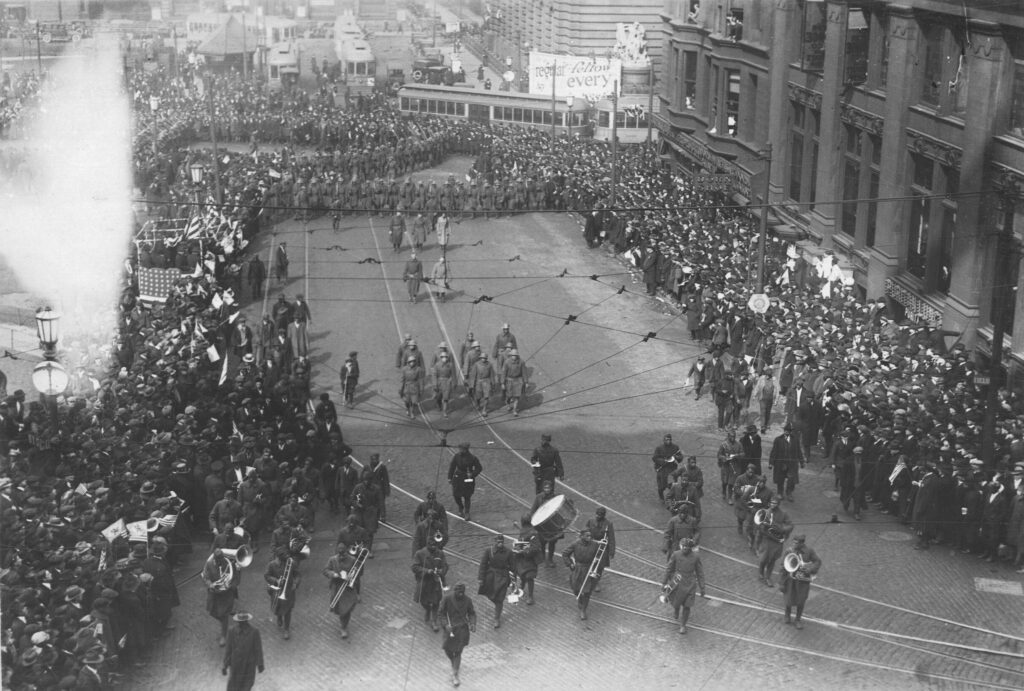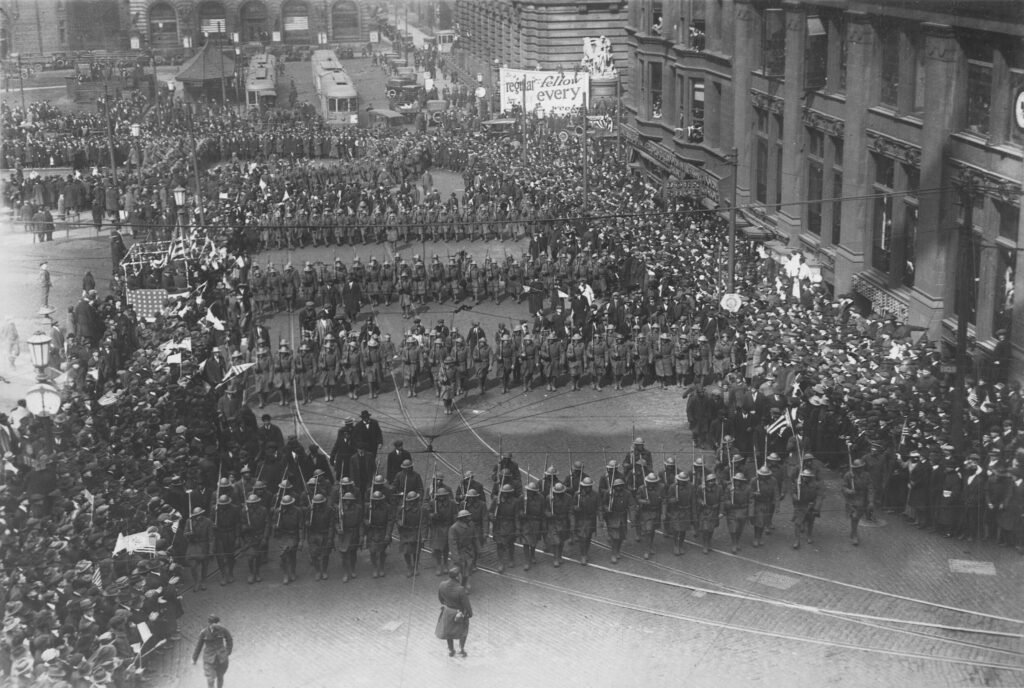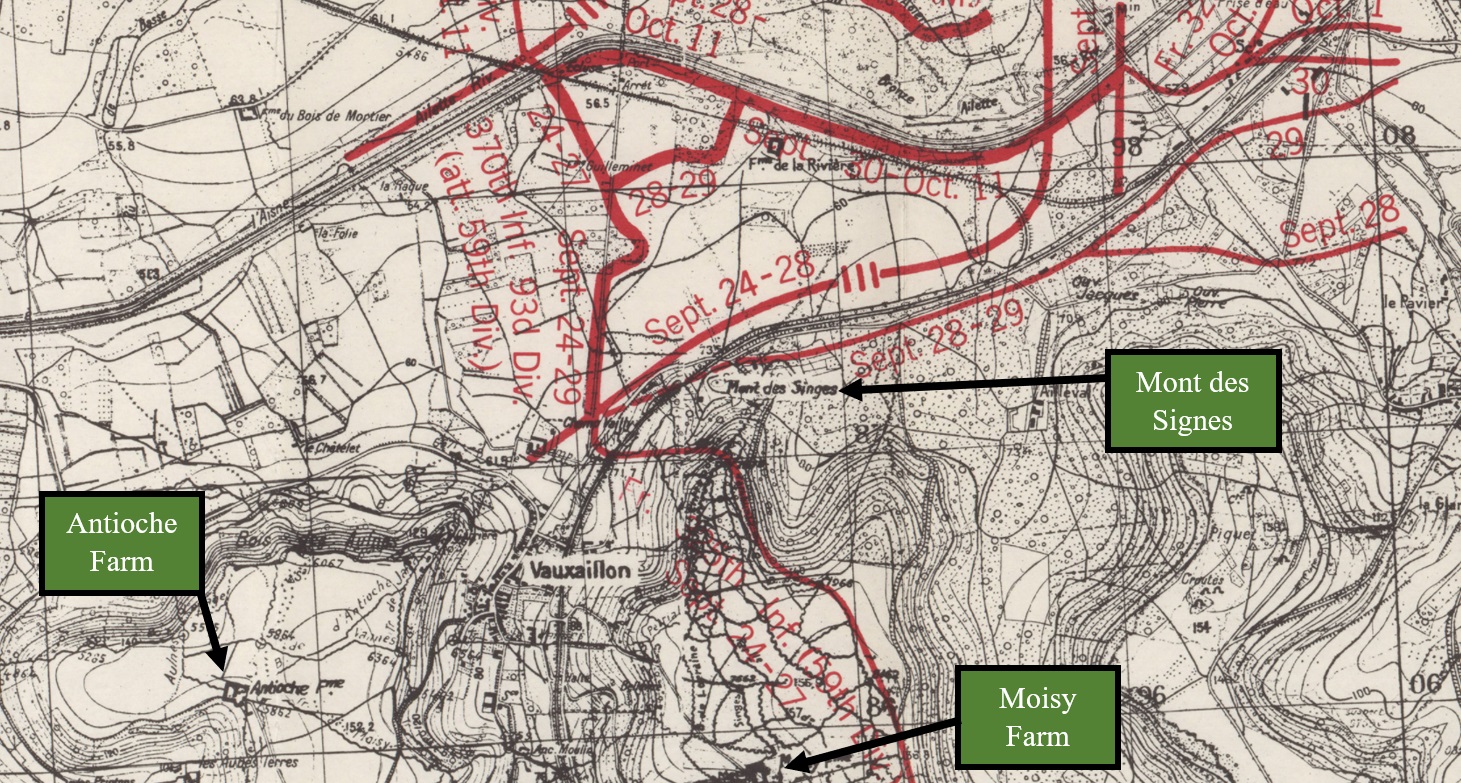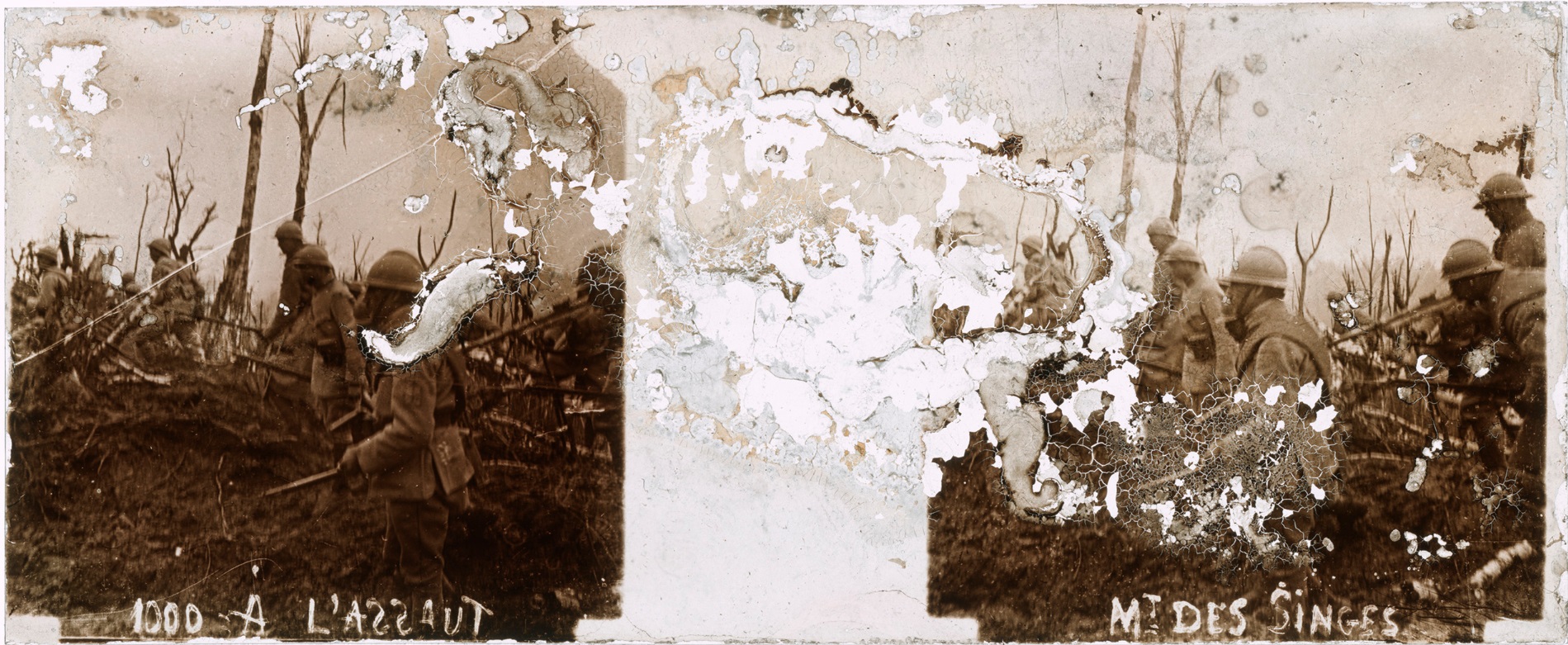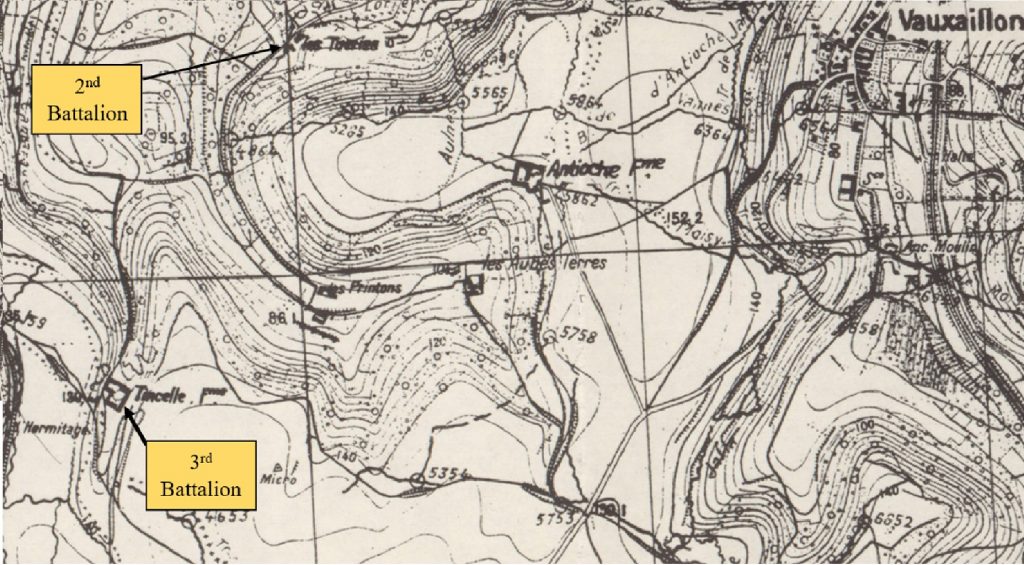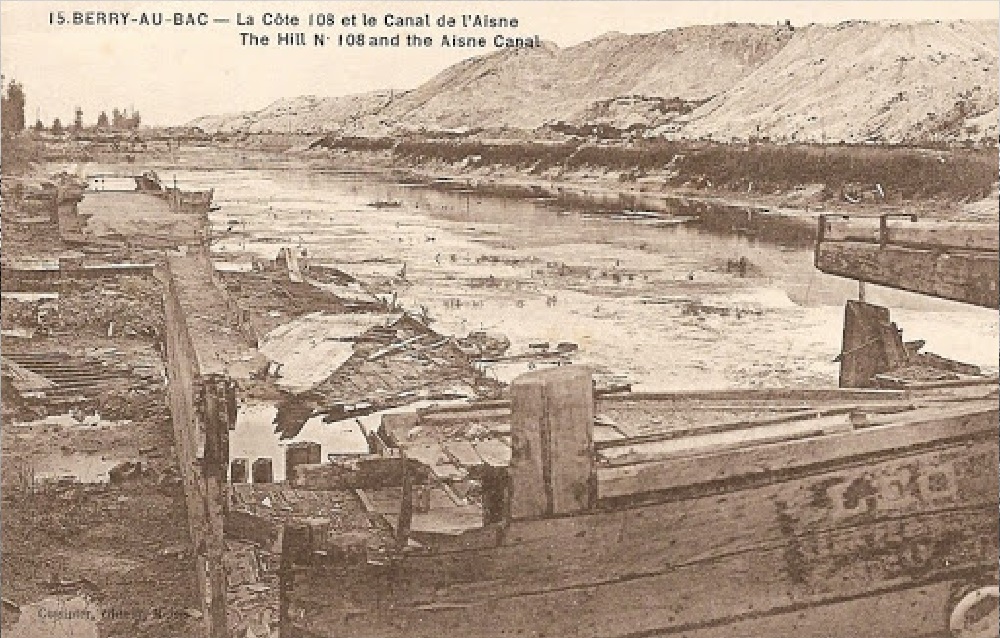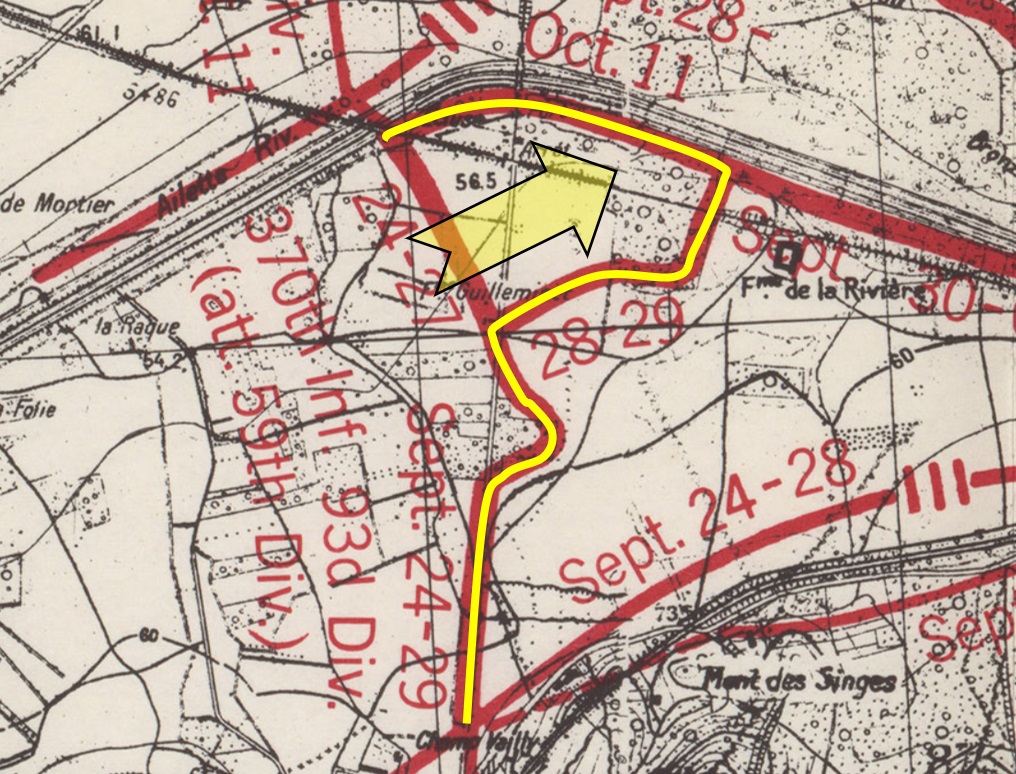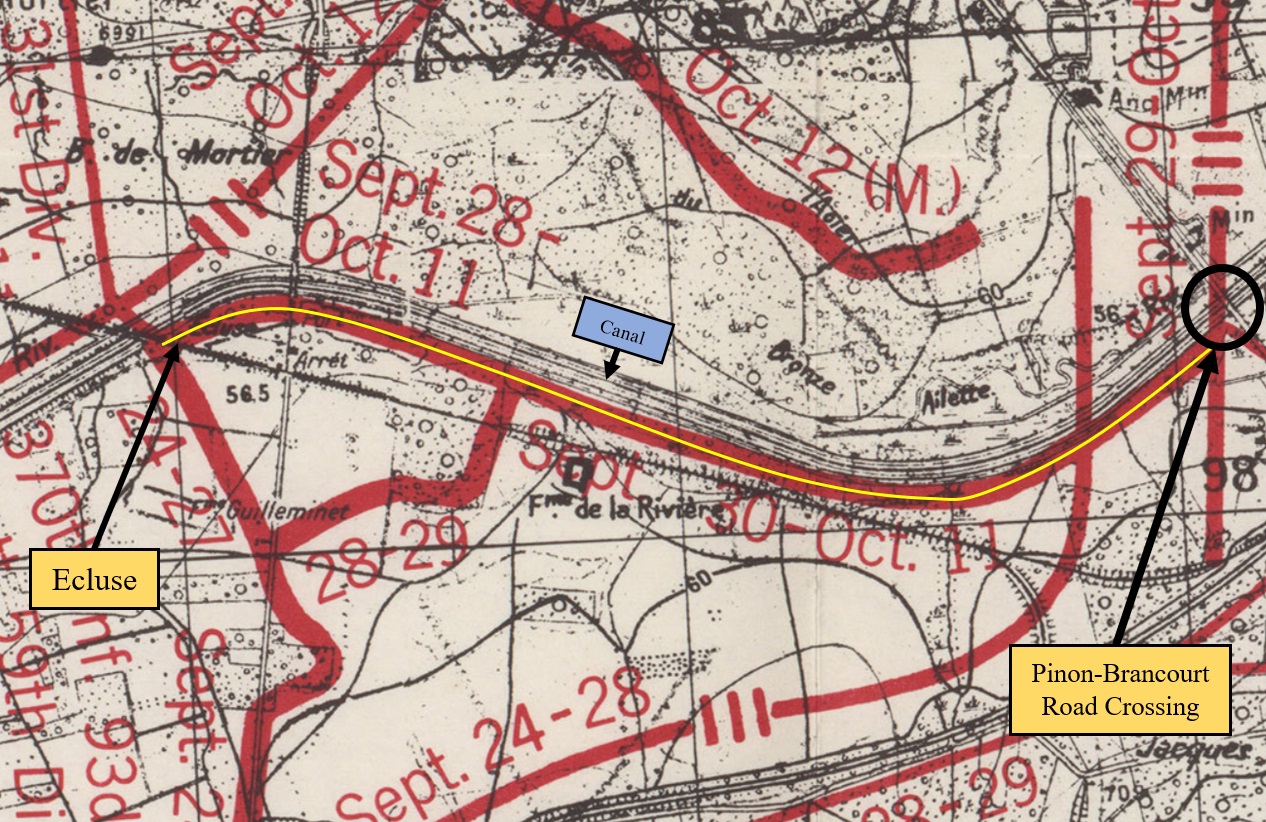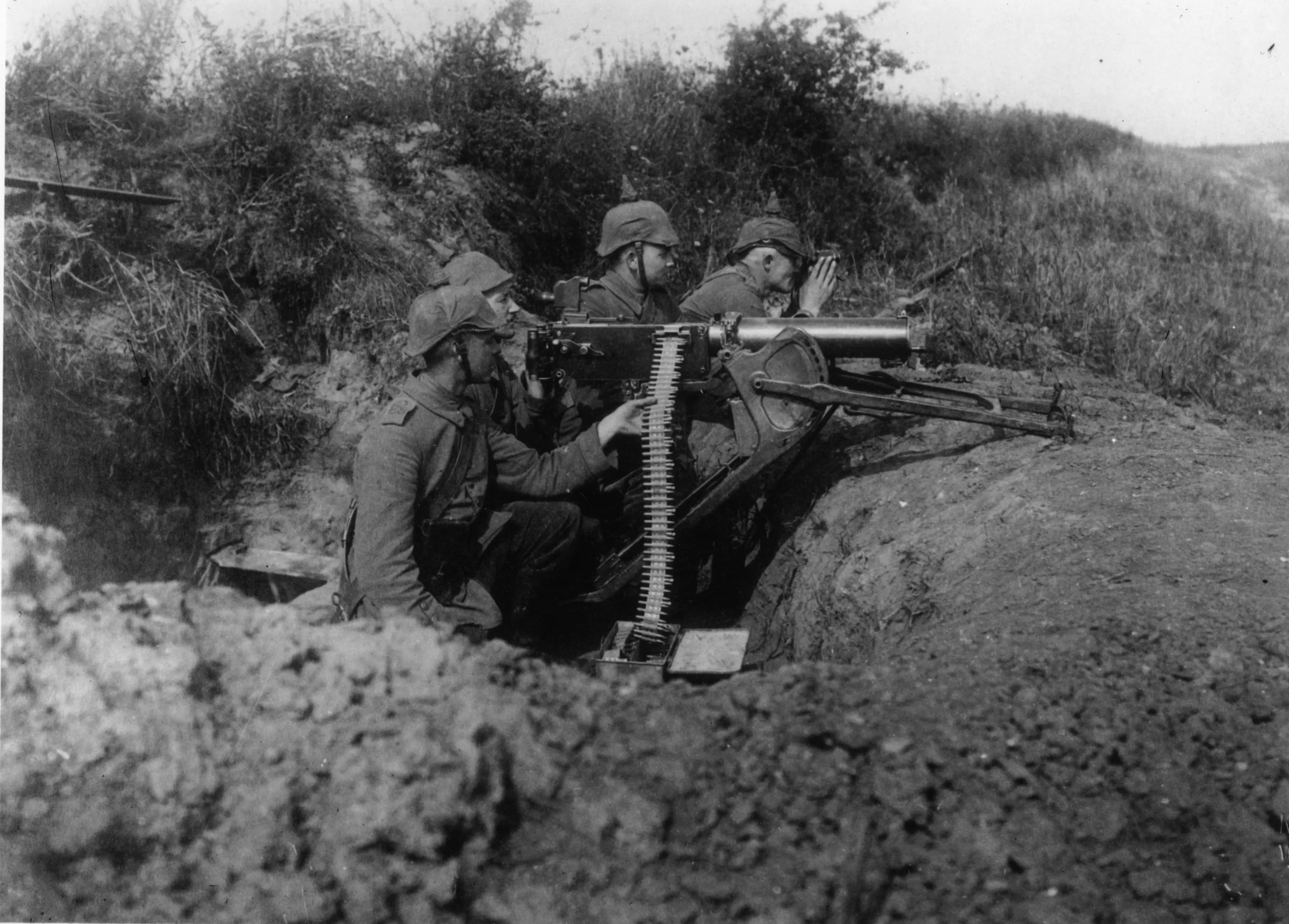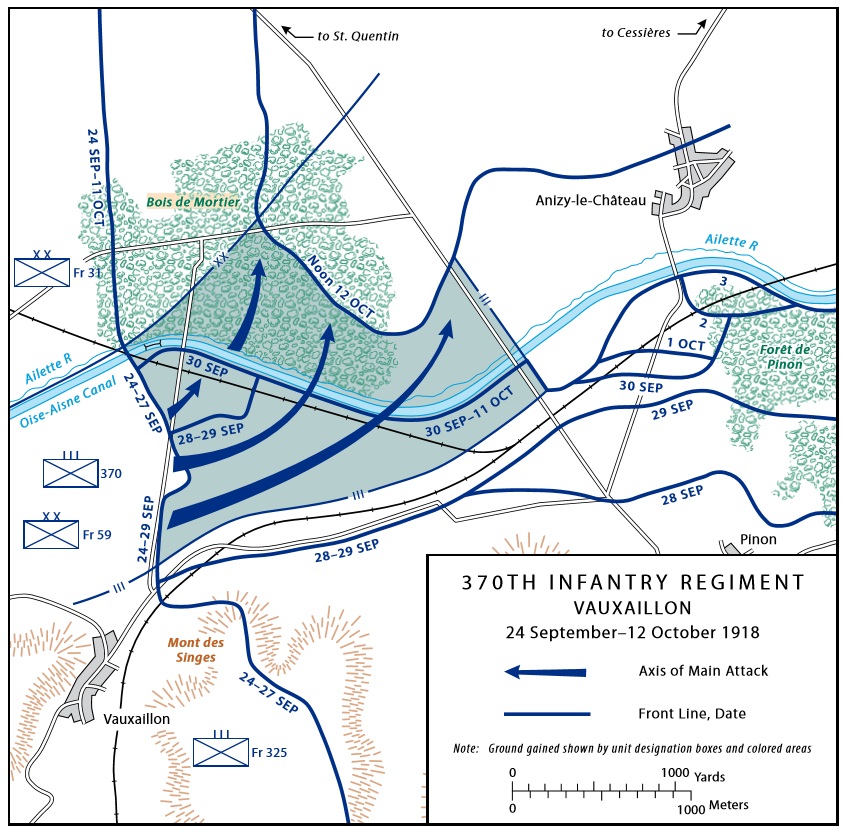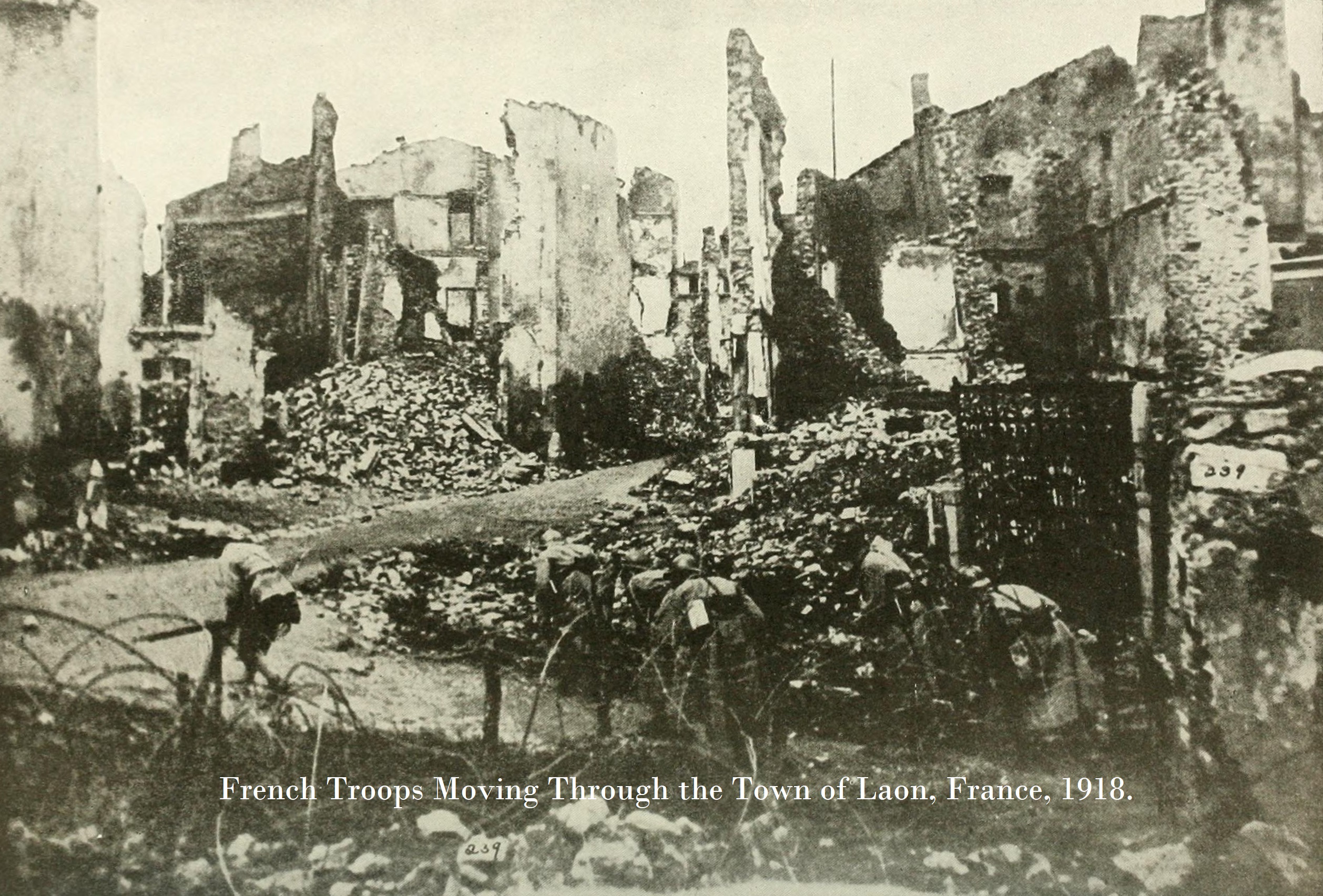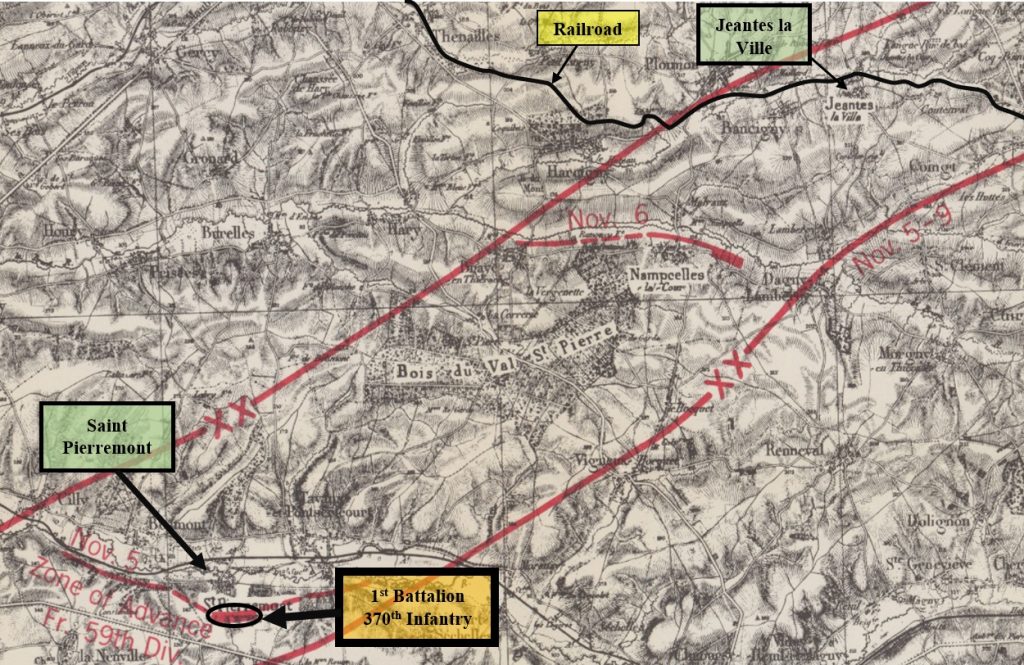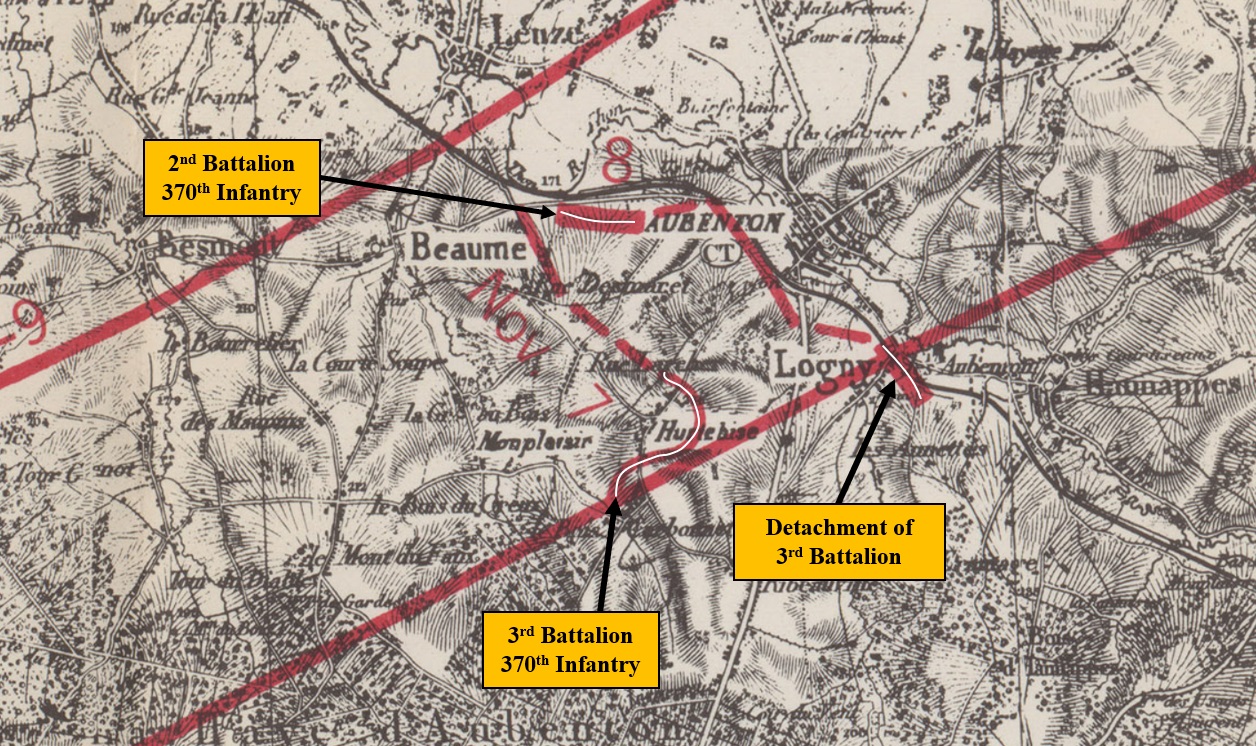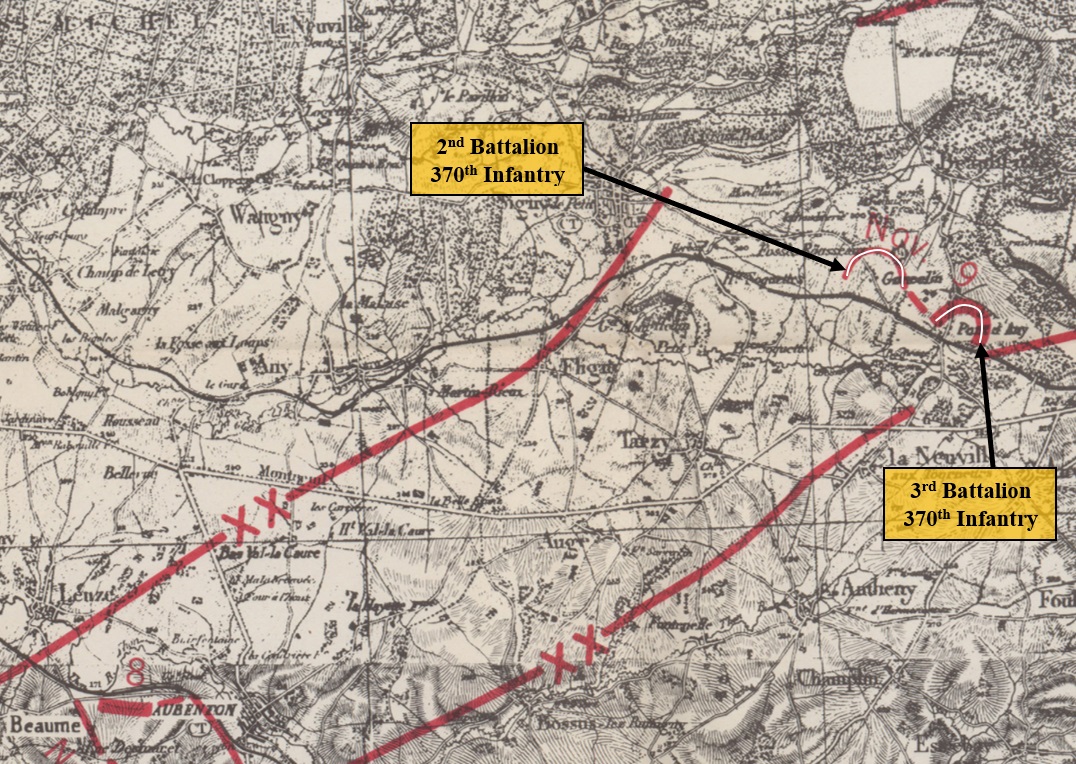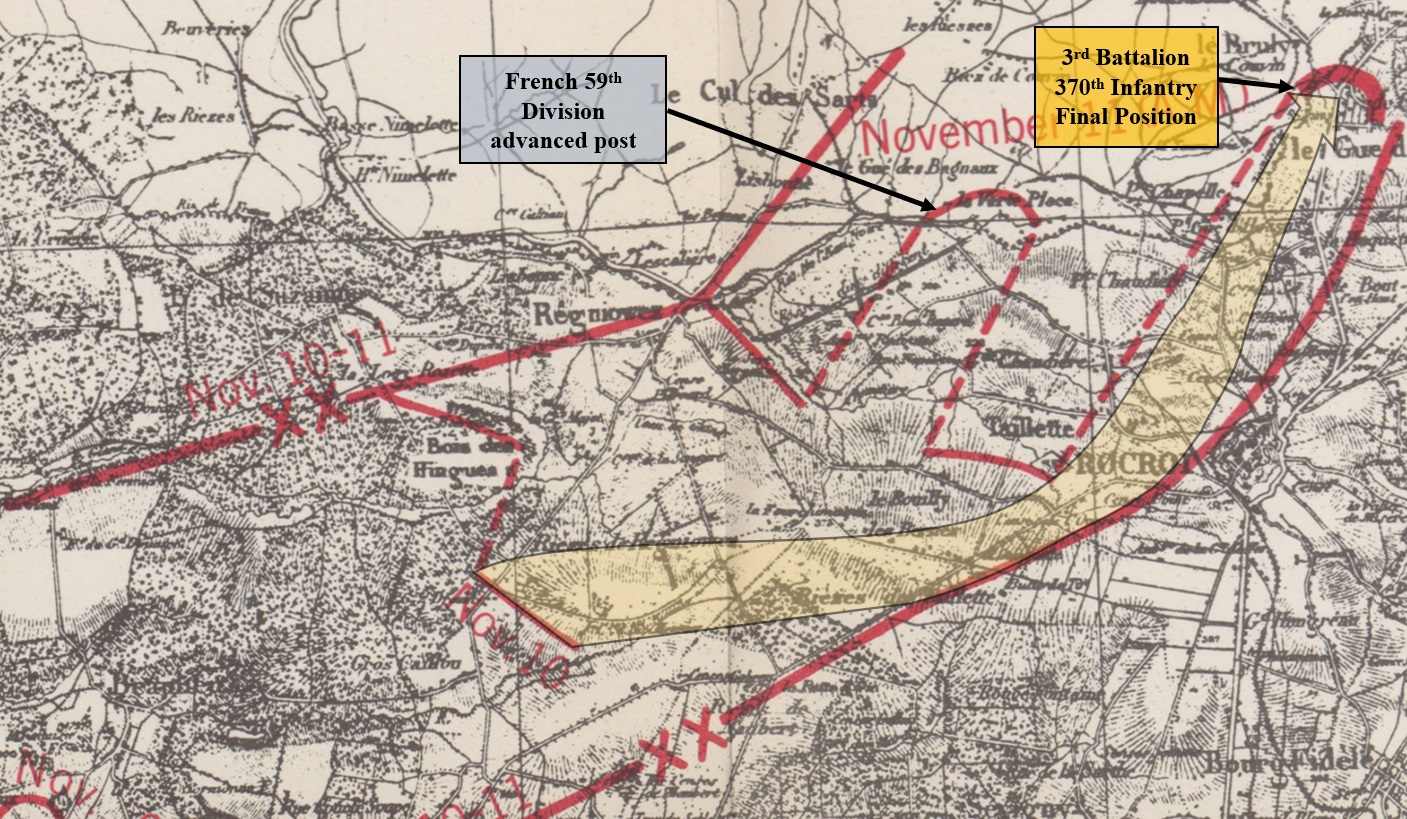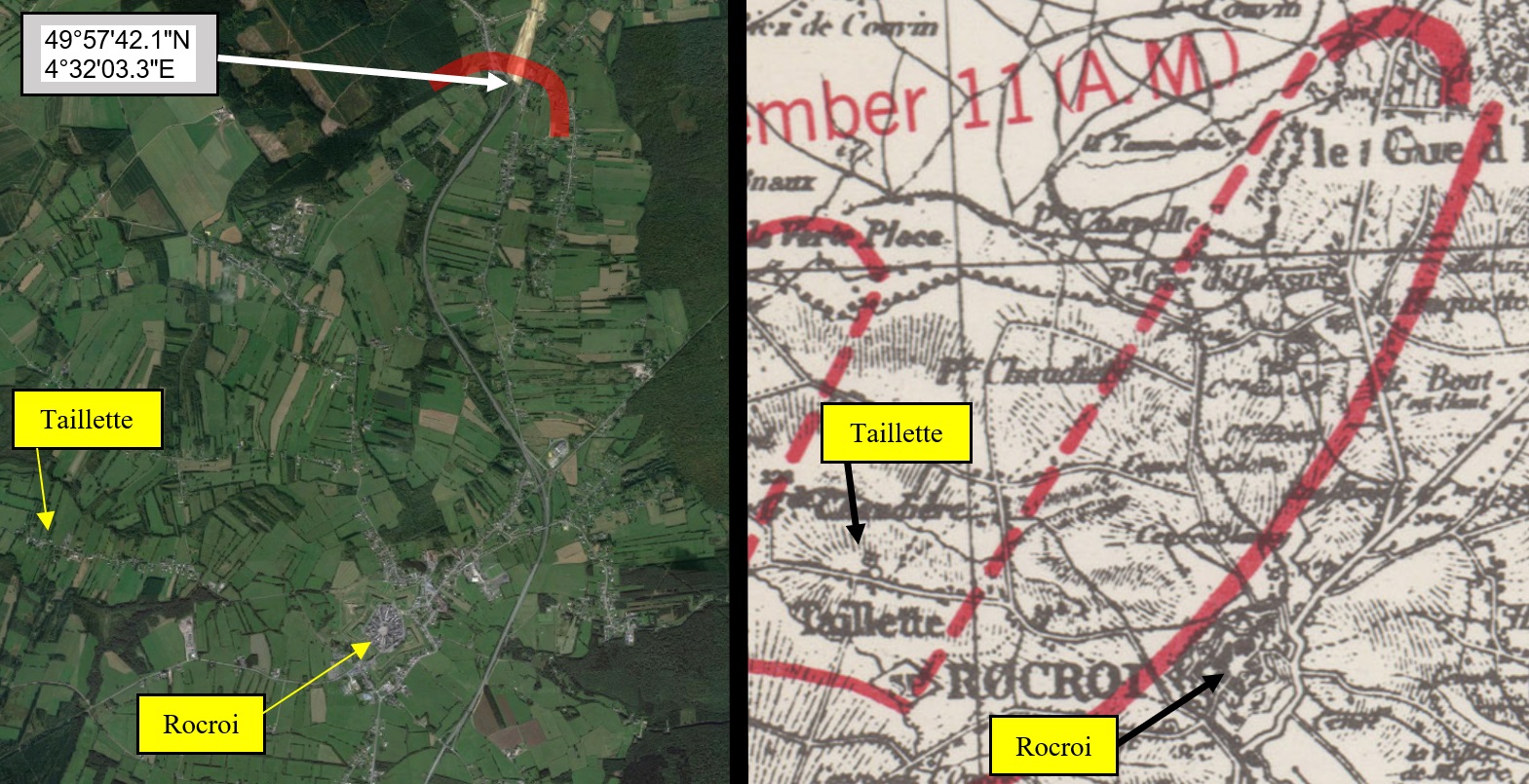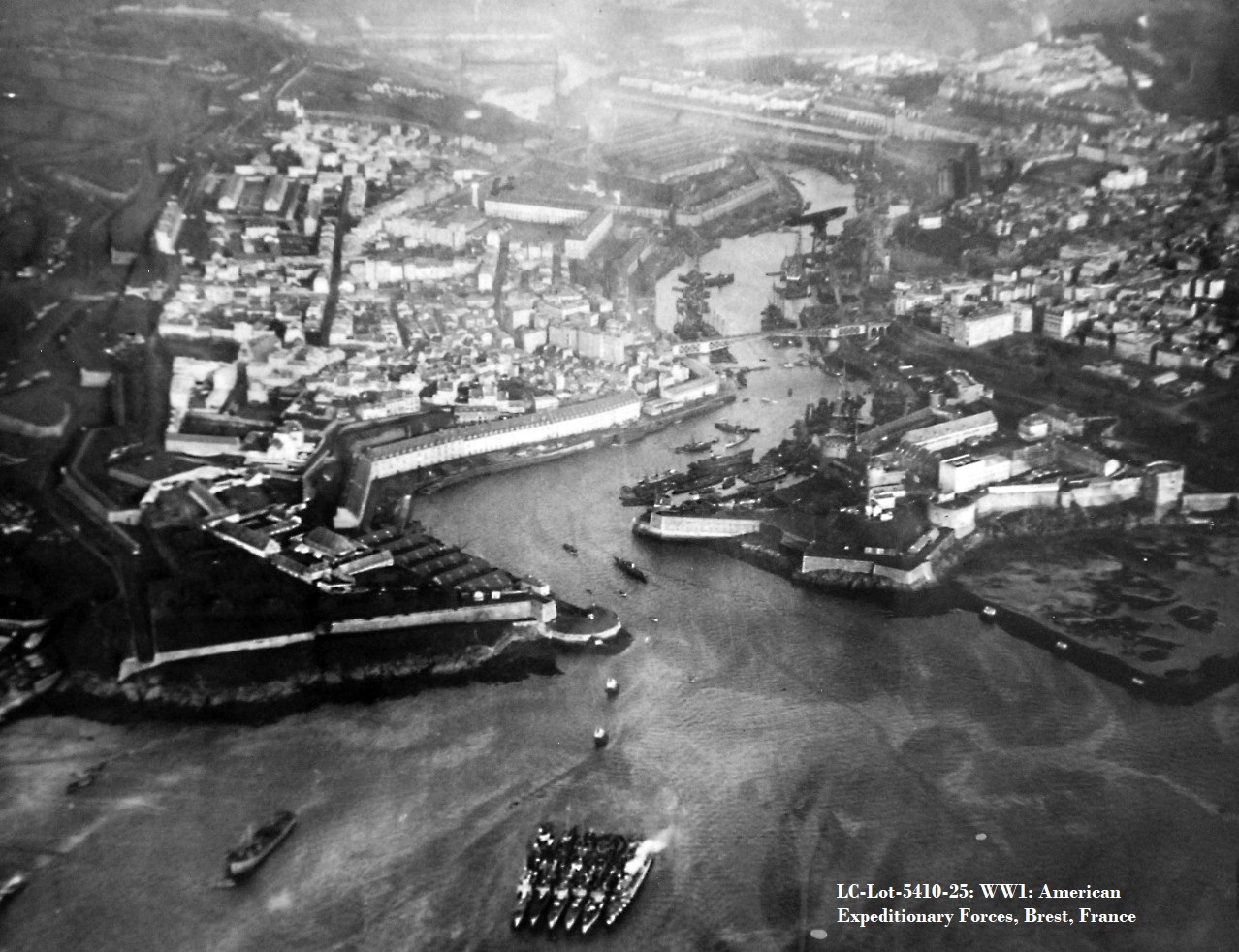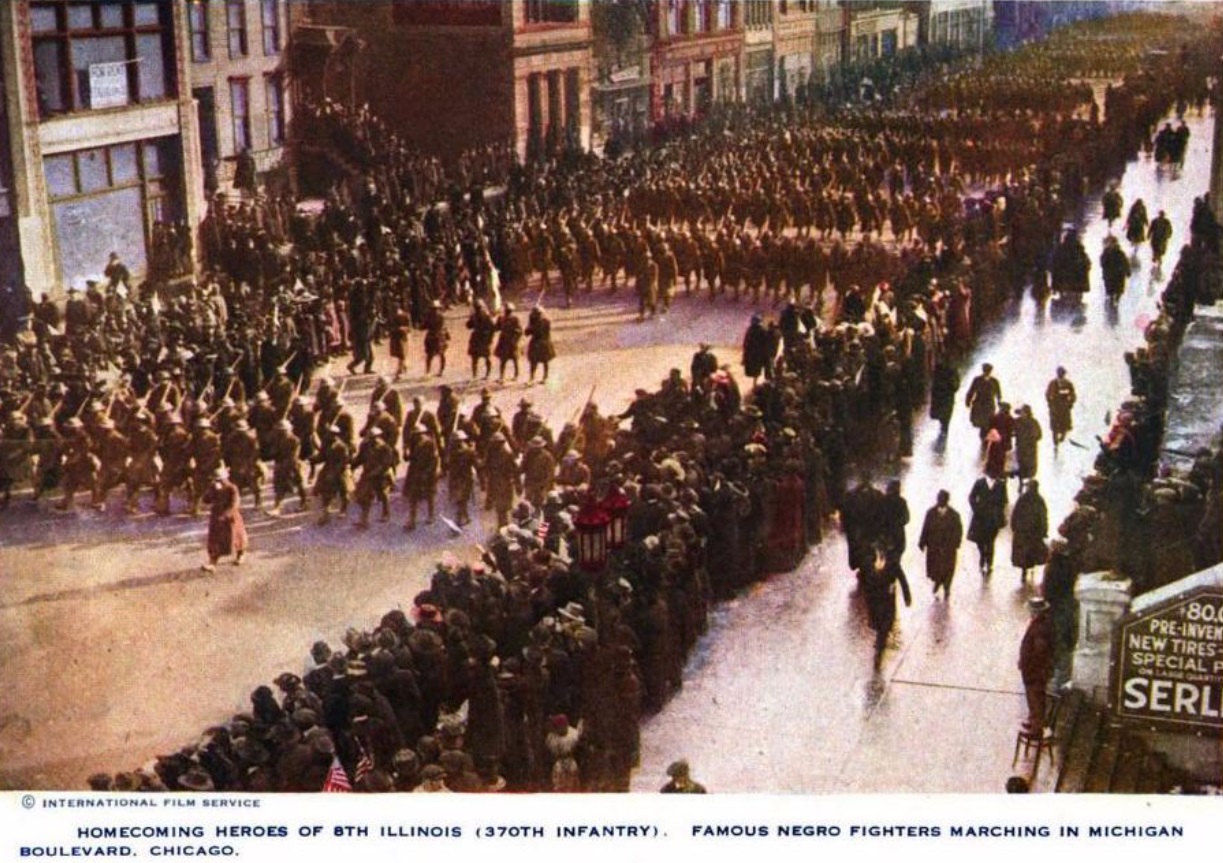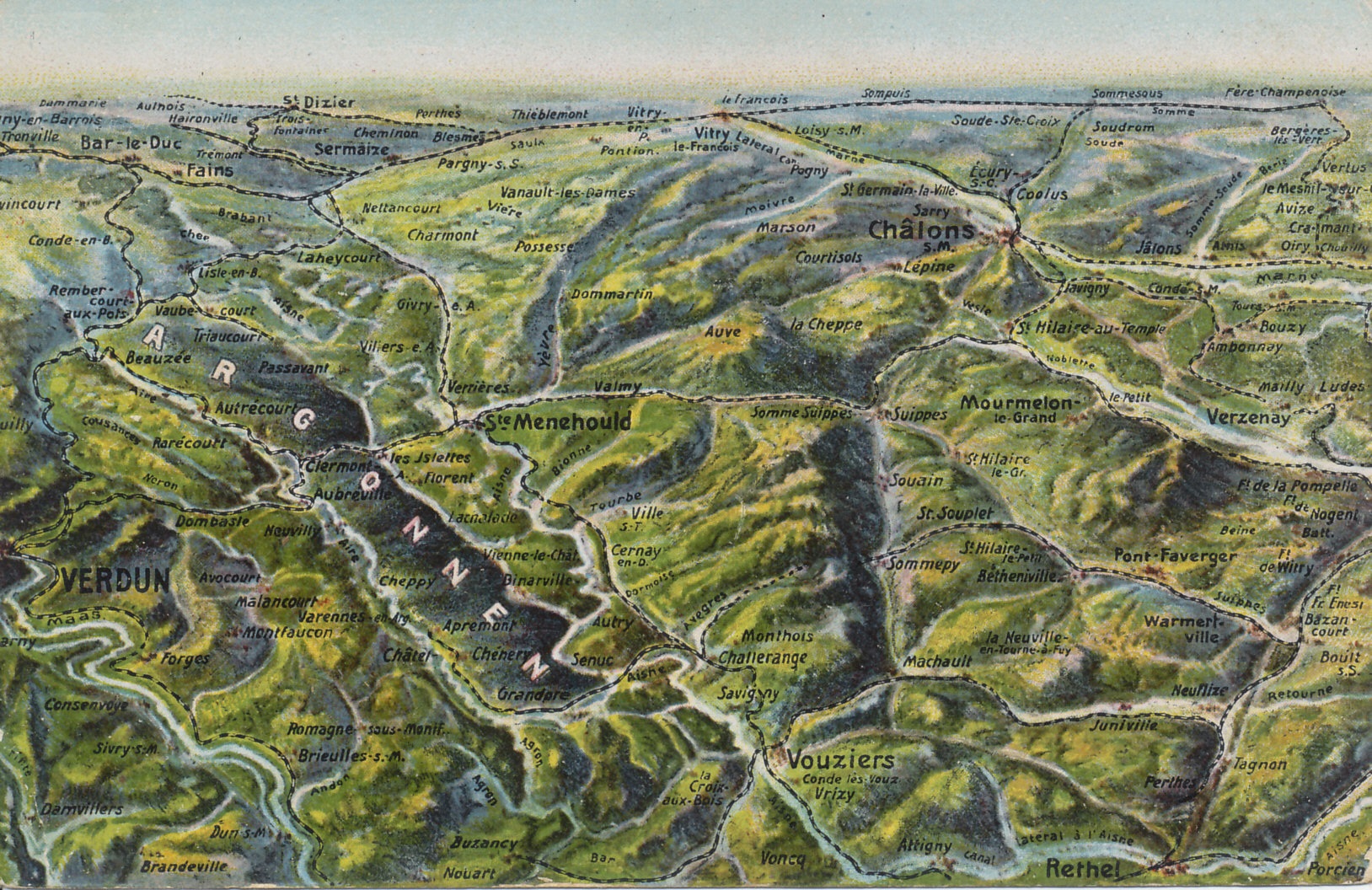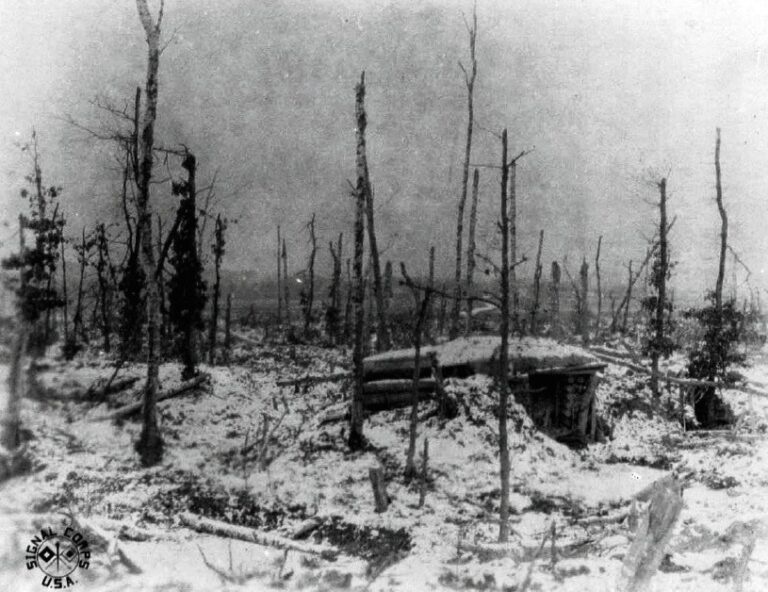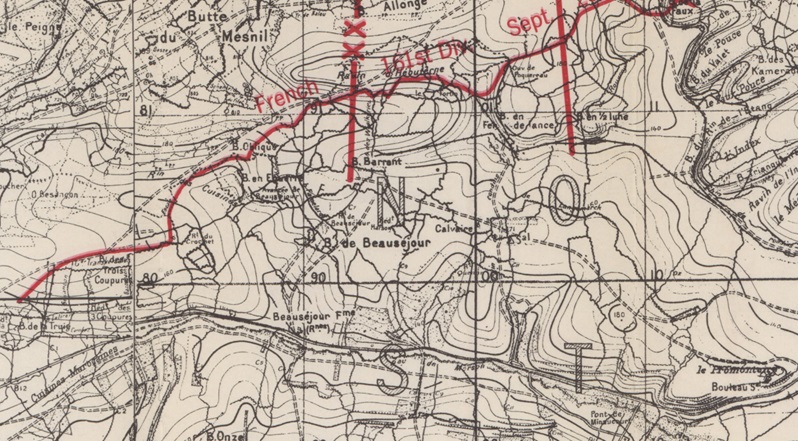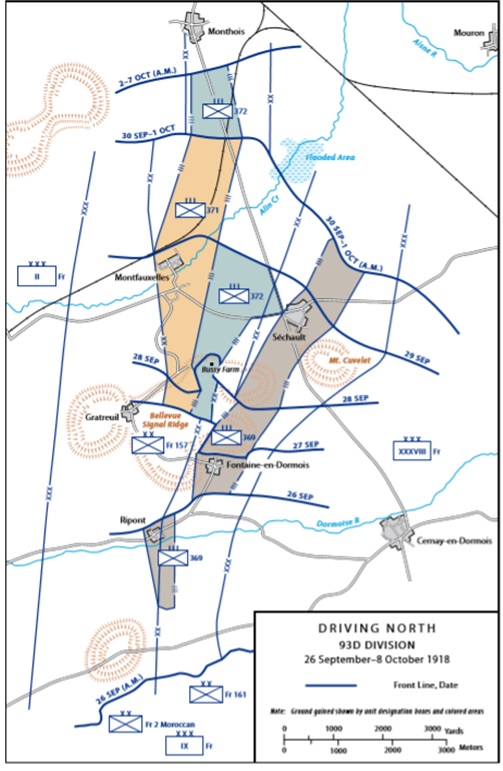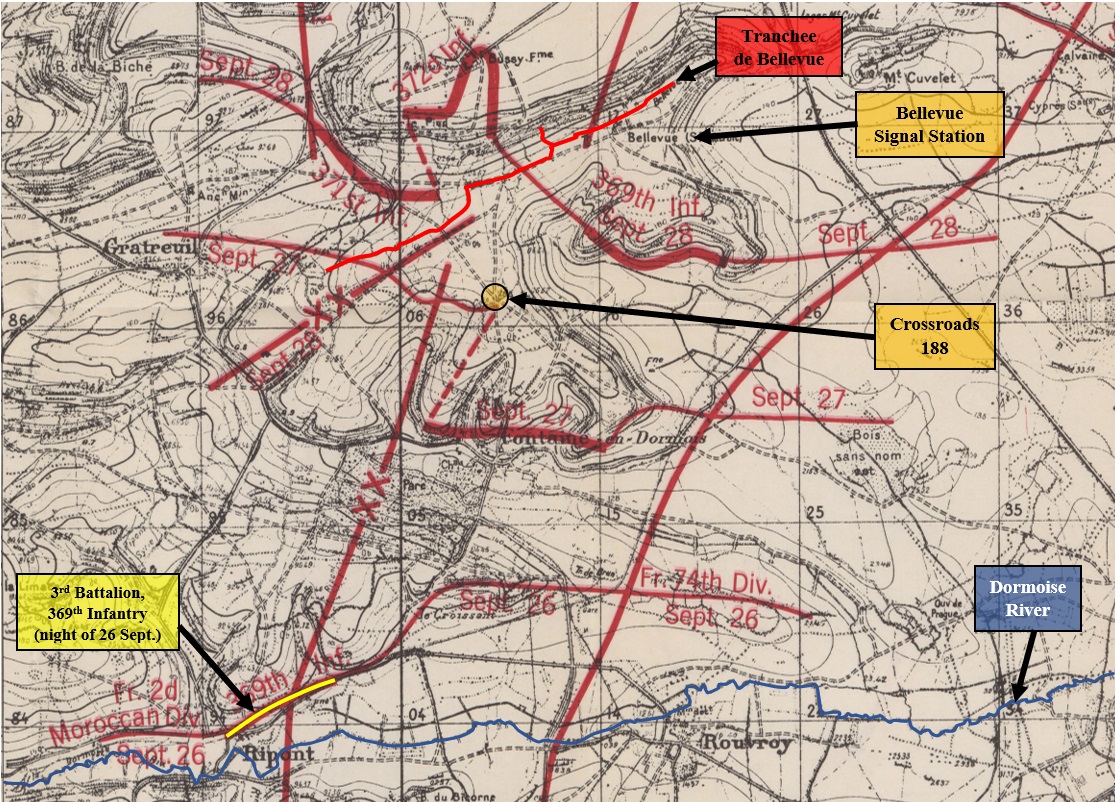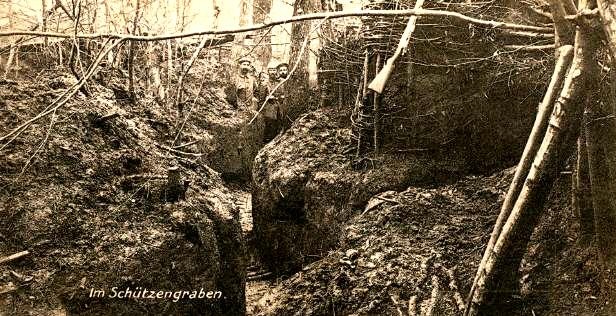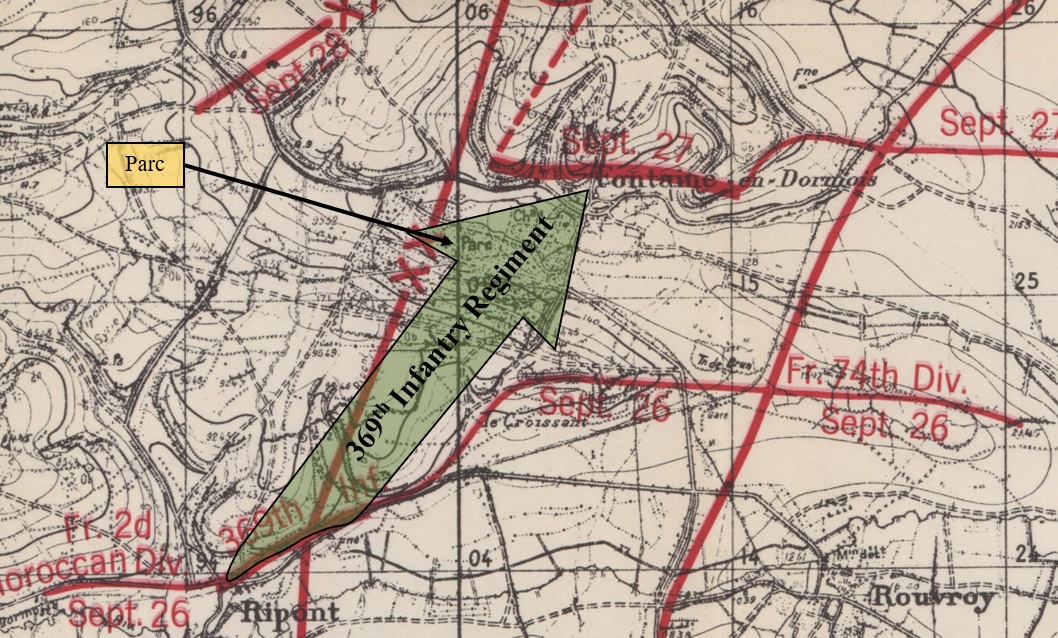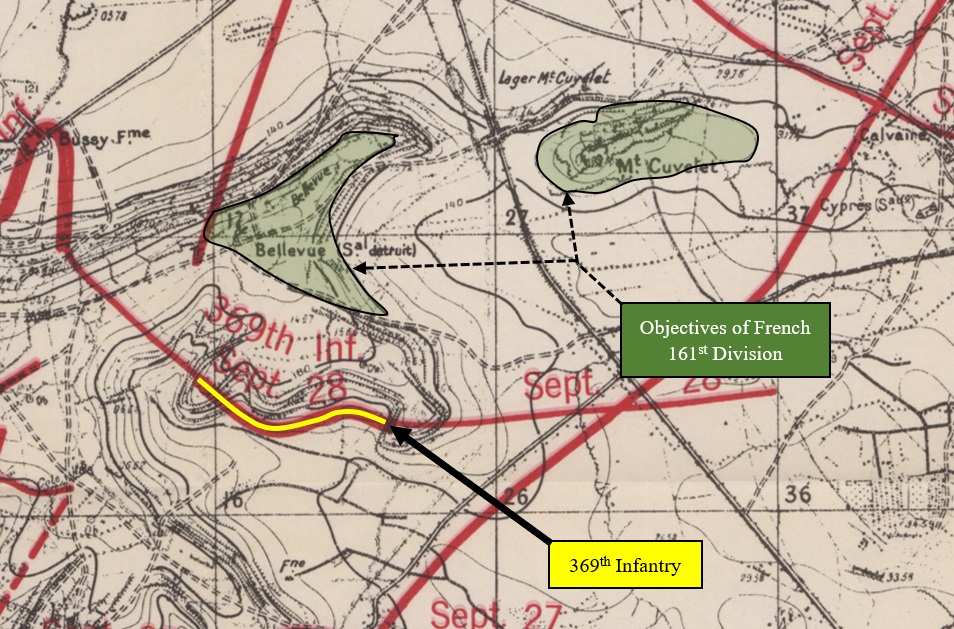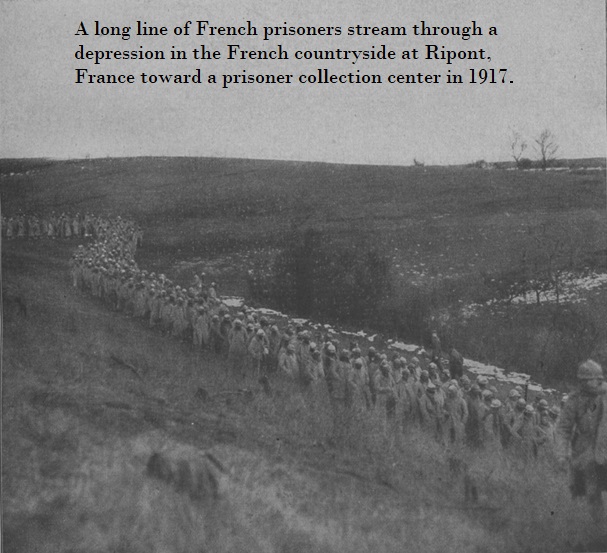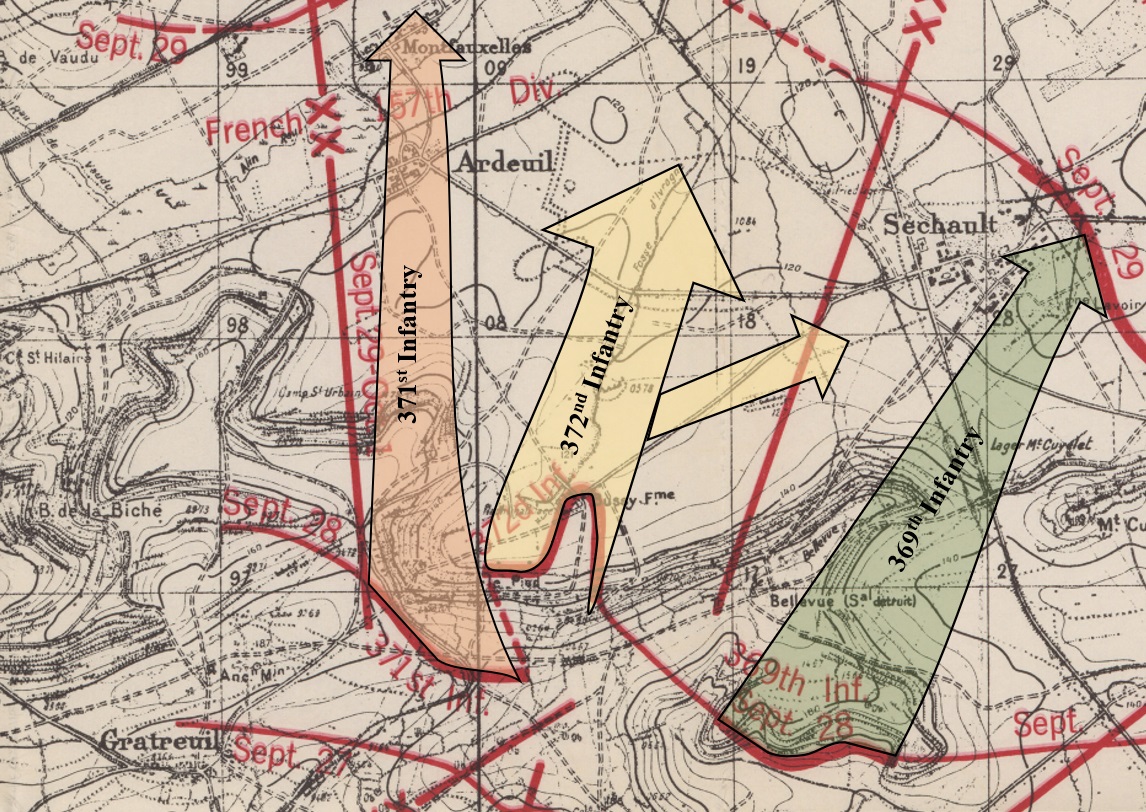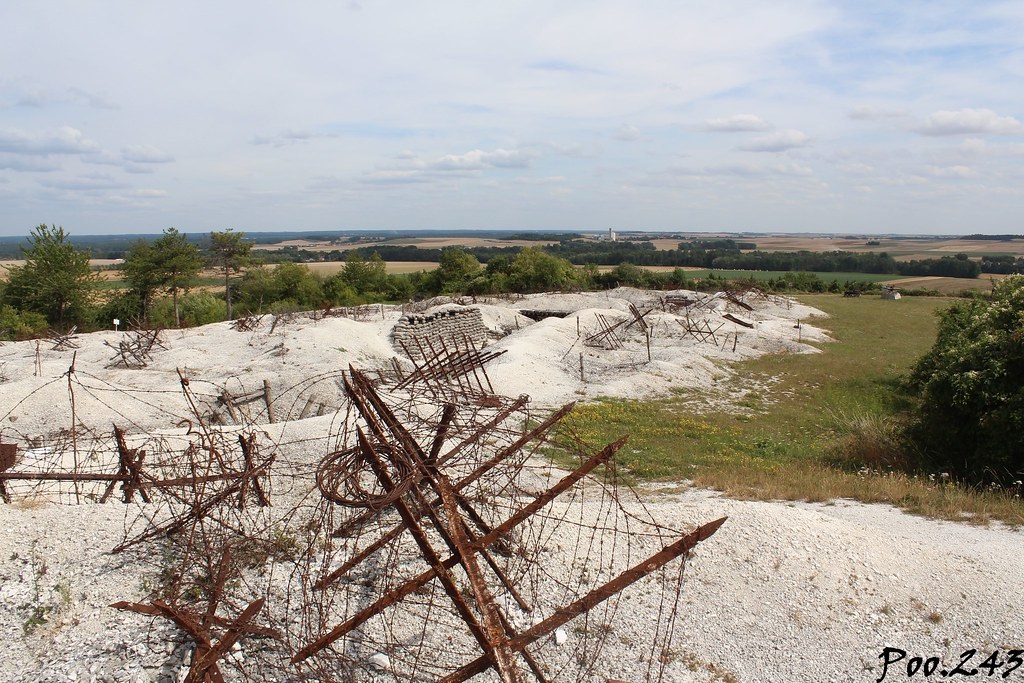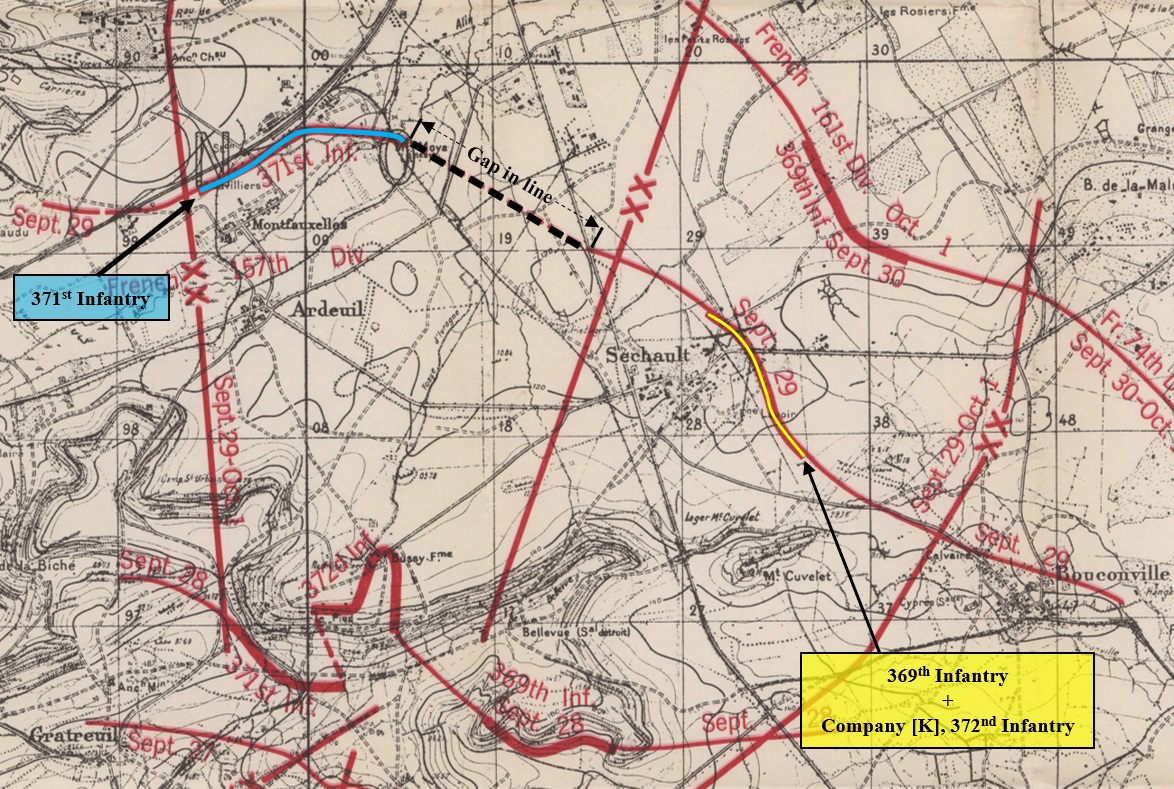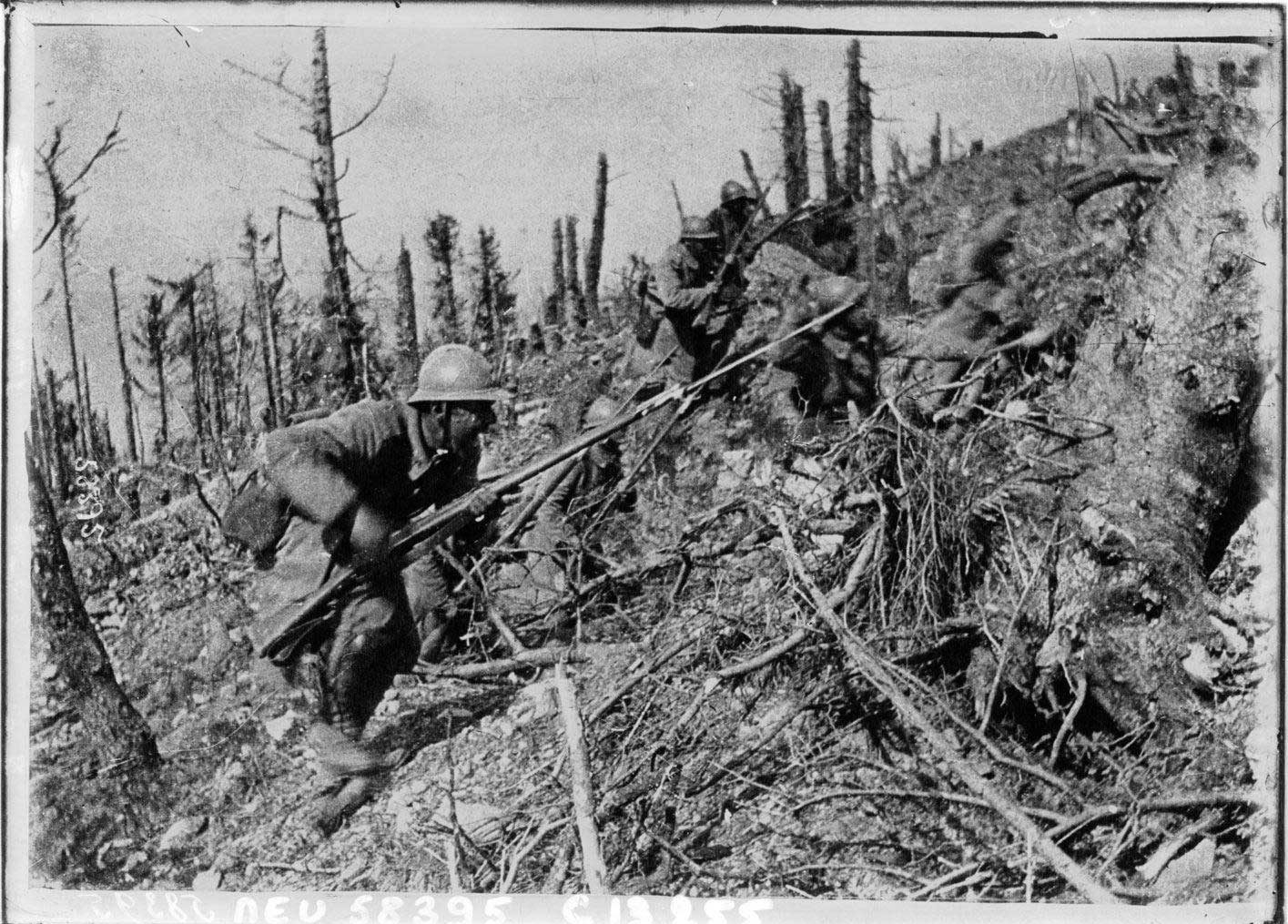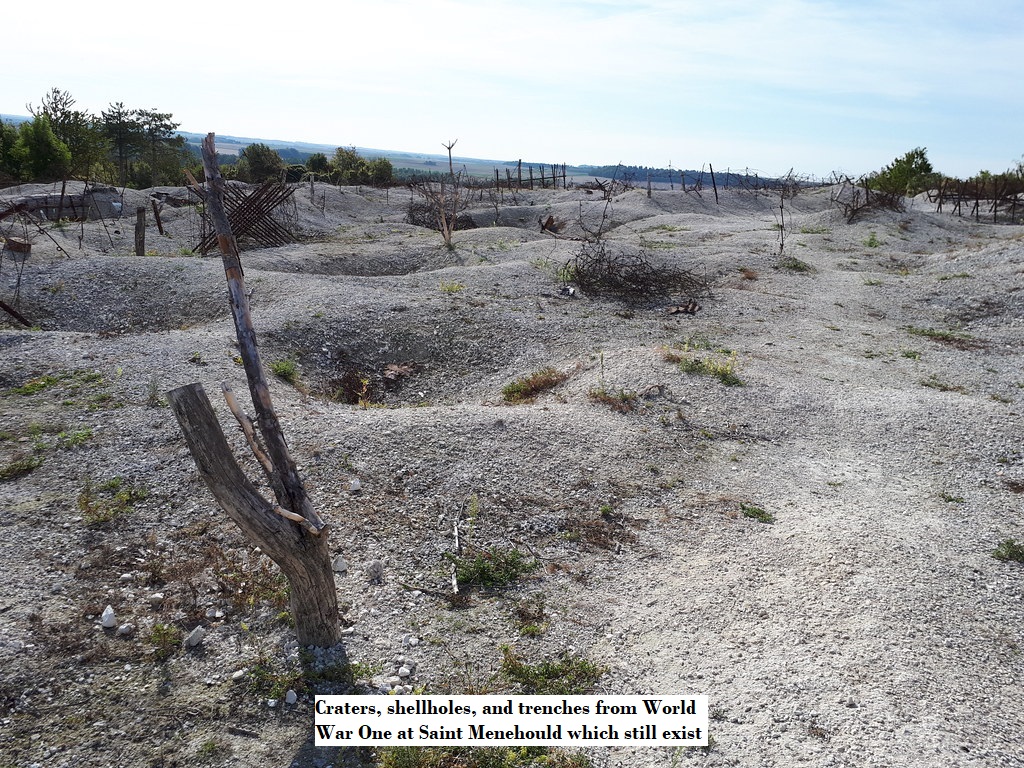
The American 93rd Infantry Division, known as the Blue Helmets Division, was organized in December 1917 at Camp Stuart, Virginia from African-American National Guard units in New York (State), Illinois, Connecticut, Maryland, Massachusetts, Ohio, Tennessee, Washington D.C. as well as Selective Service draftees from South Carolina.
Organization of the 93rd Division:

The first unit of the 93rd Division sailed from Hoboken, New Jersey on 12 December 1917 while the remainder of the 93rd sailed between February to April 1918. The units of the 93rd landed at Brest and Saint Nazaire, France. The four infantry regiments of the 93rd Division (369th, 370th, 371st, and 372nd) were sent to fight with French units, originally as a temporary solution to the depleting French Army. However, later developments had led to the 93rd spending nearly the entire time in France fighting with the French Army, remaining with French divisions until the armistice on 11 November 1918.
The 369th Infantry Regiment: “Harlem Hellfighters”
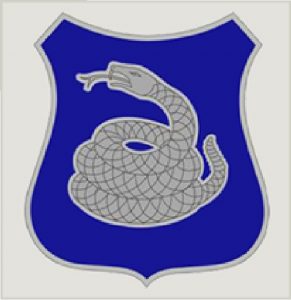 Arguably the most known African-American company of the Great War, the 369th Infantry Regiment, known as the Harlem Hellfighters or the Harlem Rattlers, was organized as part of the 93rd Division (Provisional). The 369th Infantry Regiment arrived in Brest, France in December 1917 and sent to Camp Coetquidan for duties in Services of Supply.
Arguably the most known African-American company of the Great War, the 369th Infantry Regiment, known as the Harlem Hellfighters or the Harlem Rattlers, was organized as part of the 93rd Division (Provisional). The 369th Infantry Regiment arrived in Brest, France in December 1917 and sent to Camp Coetquidan for duties in Services of Supply.
After spending December 1917 and January 1918 performing monotonous duties such as supporting the issuing of supplies to seaport and receiving services, maintaining roadways, caring for animals, etc. the 369th was ordered to travel to Givry-en-Argonne. They had arrived to their destination on 12 March 1918 and were attached to the French 16th Division for training.
On 8 April, the 369th Infantry Regiment participated in the occupation of the Afrique Sector located just west of the Argonne Forest and north of Saint Menehould. The 369th assumed command of the line that had stretched from Ville-sur-Tourbe to the west bank of the Aisne River on 29 April 1918, and remained in this position until it was relieved on 4 July 1918.
Between 15 July and 18 July 1918, the 369th participated in the Champagne-Marne Defensive where the Allied defensed against a German offensive in attempt to widen the Marne salient via attacking both sides of the Reims. During this defensive, the 369th Infantry Regiment stopped a German attack against the French 16th Division and was moved to support the French 161st Division. From 21 to 22 July 1918, a single battalion of the 369th Infantry Regiment entered the front line in the Beausejour subsector (Calvaire Sector) located 1 kilometer south of Butte du Mesnil.
From 23 July to 19 August 1918, the 39th Infantry Regiment occupied the Calvaire subsector (Calvaire Sector) 1 kilometer north of Calvaire. They were then moved to Saint Ouen and trained with the French until 7 September 1918. Two days later, the 369th was assigned to the French 161st Division. The 369th relocated back to the Beausejour subsector on 11 September 1918, where on 14 to 16 September 1918 they were moved to the Somme-Bionne area (15 kilometers west of Saint Menehould) in preperation for the Meuse-Argonne (Champagne) Offensive with the French Fourth Army.
During its service, the 369th Infantry Regiment suffered 1,500 casualties and had participated in the Champagne-Marne, Meuse-Argonne, Champagne (1918) and Alsace (1918) campaigns.
The 370th Infantry Regiment: “Black Devils”
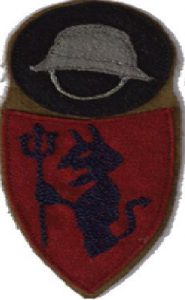
The 370th Infantry Regiment companies organized at various rendezvous locations pursuant to the call to service by President Woodrow Wilson. Originally the 8th Regiment Illinois National Guard, the unit was called into service in early August 1917 and commanded by Colonel Franklin Denison. However, in December 1917 the 8th Illinois National Guard was re-designated as the 370th Infantry Regiment and assigned to the 185th Infantry Brigade of the 92nd Division alongside the old 15th New York National Guard (369th Infantry Regiment).
The 370th Infantry Regiment was the only infantry regiment of the United States Army that served in the Great War comprised almost entirely of African-American servicemembers, including African-American officers from the highest rank of Colonel on down. Recruits of the 370th Infantry Regiment primarily came from the “Black Belt” and other southside communities of Chicago, Illinois. However, not all recruits came from Chicago and the companies assorted within the 370th were assigned dependent on the location they came from:
Chicago, Illinois: Headquarters Company, Machine-Gun Company, Supply Company, Detachment Medical Company, as well as Companies [A], [B], [C], [D], [E], [F], [G], and [H].
Springfield, Illinois: Company [I]
Peoria, Illinois: Company [K]
Danville, Illinois: Company [L]
Metropolis, Illinois: Company [M]
After sailing for 16 days on the U.S.S. President Grant, the 370th Infantry Regiment arrived in Brest, France on 22 April 1918. Upon arrival the 370th proceeded to Grandvillars in the Vosges Region near Belfort and was attached to the French 73rd Division for training. On 19 May 1918, the regiment was transferred to the French 133rd Division but was transferred to the French 10th Division to occupy a sector near the Swiss border on 1 June 1918. After 11 days, the 370th was moved to Lignieres where it spent only five days before being transferred to the French 34th Division at the tip of the Saint Mihiel Salient. On 22 June 1918, the 370th Infantry took control of the subsector south of the town of Saint Mihiel where it remained until 1 July 1918.
After its relief in the Saint Mihiel subsector, the 370th Infantry was transferred to the French 36th Division in the vicinity of Auzeville (about 20 kilometers southwest of Verdun). From 7 July to 18 August 1918 the 370th participated in the occupation of the Aire Sector on the Meuse-Argonne front 10 kilometers north of Auzeville.
Upon being relieved from the Aire Sector, the 370th trained in the Bar-le-Duc area until 11 September 1918 until it was moved to the area of La Ferte-Milon (65 kilometers north of Paris). However, “according to official records of the Army at the close of World War One, the 370th Regiment and the 93d Division were never in the front lines, never advanced against the enemy, and suffered no casualties. They were basically written out of the history books.”
In total, 71 Soldiers of the 370th Infantry Regiment were awarded the Croix de Guerre, 23 were awarded the Distinguished Service Cross, 1 servicemember was awarded the Distinguished Service Medal, and the entirety of Company [C] was awarded the Croix de Guerre unit citation.
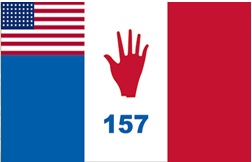
The Red Hand Division:
Although the American 371st and 372nd Infantry Regiments were a part of the 93rd Division, the 93rd was never formally organized and as a result, the 371st and 372nd were loaned to the French 157th “Red Hand” Division and technically separate from the 93rd Division in its endeavors.
The 371st Infantry Regiment
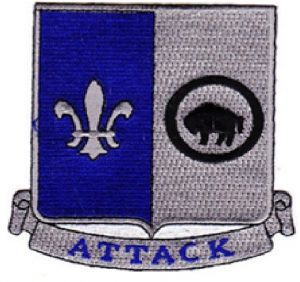
Upon its arrival in France, the 371st Infantry Regiment proceeded to Rembercourt-aux-Pots, about 26 kilometers west of Saint Mihiel, and trained with the French XIII Corps until 6 June 1918. After training, the 371st was designated as an organic part of the French 157th “Red Hand” Division and then placed at the disposal of the French 68th Division holding the Verdun Sector on the Meuse-Argonne front.
On 11 July 1918, the 371st Infantry moved into a support position in the Verdun Sector and was passed back to the control of the French 157th Division five days later. The 371st Infantry Regiment participated in the occupation of the Verdun Sector until 14 September 1918, and moved with the French 157th Division to the Somme-Bionne area in preparation for the Meuse-Argonne (Champagne) Offensive with the French Fourth Army.
The 372nd Infantry Regiment
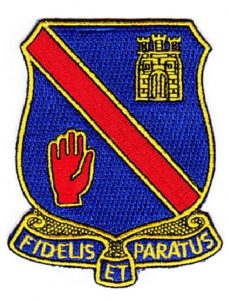
The 372nd Infantry Regiment was an African-American infantry regiment composed of the First Separate Battalion of the District of Columbia, the 9th Ohio Separate Battalion, Company [L] of Massachusetts, the First Separate Company of Connecticut, and the First Separate Company of Maryland.
All of the troops in the 372nd Infantry were National Guard servicemembers, and 250 men were from Camp Custer, Michigan that had been recruited mainly from Michigan and Wisconsin.
The 372nd embarked on the U.S.S. Susquehanna from Newport News, Virginia on 30 March 1918 for overseas duty. On 13 April 1918, the 372nd arrived to port at Saint Nazaire and entrained for Vaubecourt. Ten Days later, the 372nd arrived at 0700 hours (7:00 A.M.) and began a march in heavy rain at 0830 hours (8:30 A.M). By 1400 hours (2:00 P.M.) the next day, the 372nd reached their destination of Conde-en-Barrois (5 kilometers south of Rembercourt-aux-Pots) and began its training with the French XIII Corps until 26 May 1918.
After completing its training the 372nd joined the French 63rd Division, which had been holding the Aire Sector on the Meuse-Argonne front between the Aire River to the Le Four de Paris. The 372nd departed Conde-en-Barrois at 0805 hours (8:05 A.M.) via French motorized trucks and headed for Les Sennades on 28 May 1918, where it had arrived at 1330 hours (1:30 P.M.) on the same day.
The next day, the 372nd Infantry took over the sector known as “Argonne West” and were officially on the frontlines by 4 June 1918. On 29 June 1918, the 372nd change its sector and took over the Vacquois Sector (subsector of the Verdun) where a suspected German attack was to take place. The French 157th Division, of which the 371st and 372nd Infantry Regiments were attached, had been placed as the Reserve Division, and on 1 July 1918 the 372nd assumed command of the Vaquois subsector, east of the Aire River. The next day, the 372nd became an organic part of the French 157th Division.
After occupying the Verdun sector between 16 July to 14 September 1918, the 372nd moved with the French 157th Division to Hans, near Somme-Bionne, in preparation for the Meuse-Argonne (Champagne) Offensive with the French Fourth Army.
On 17 November 1918, the French 161st Division and the 369th Infantry advanced into Germany as part of the French Army of Occupation until the 369th was relieved from French command on 12 December 1918. The 369th Infantry would return to the area of Belfort on 17 December 1918, where on New Year’s Eve it would relocate to the American Embarkation Center in Le Mans and sail from Brest, France on 2 February to arrive in New York on 12 February 1919.
On 20 December 1918, the French 157th Division of which the 371st and 372nd Infantry Regiments served under, was disbanded. The 371st and 372nd Infantry Regiments went back under American command. In January 1919, they were relocated to the American Embarkation Station in Le Mans, France where they sailed from Brest, France on 3 February 1919 and arrived in Hoboken, New Jersey on 11 February 1919).
The American 93rd "Blue Helmets" Division
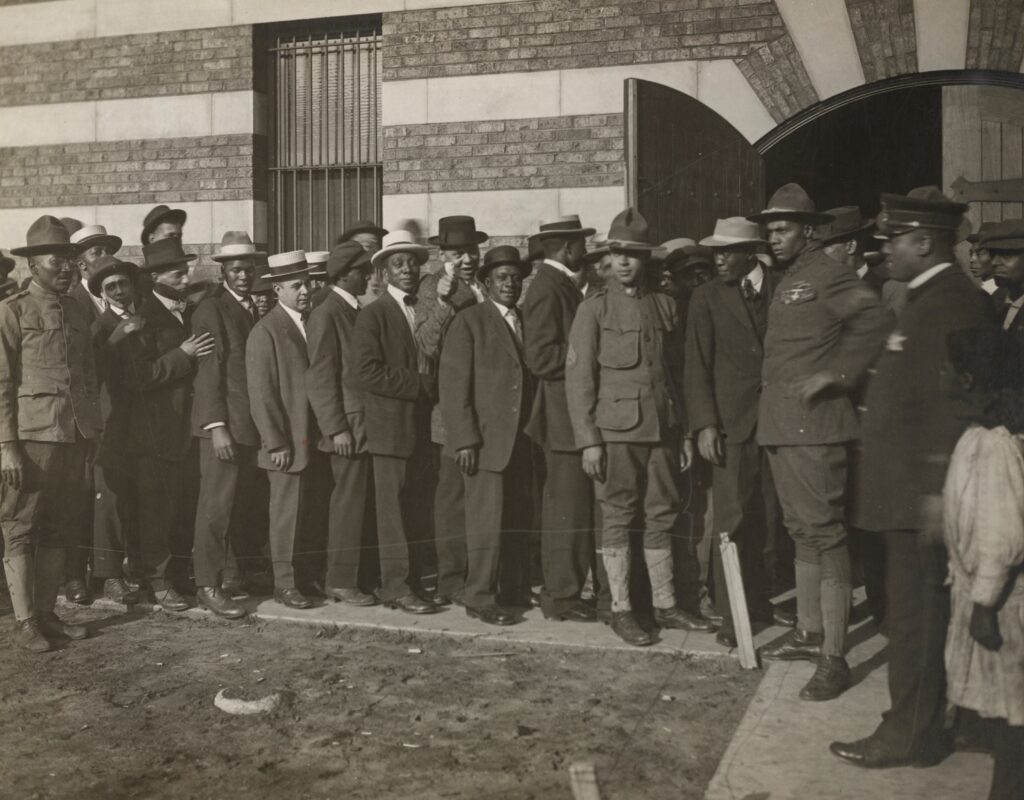
African Americans eager to enlist, 8th Regiment Illinois National Guard (later 370th Infantry Regiment), Chicago, Illinois, 1917.
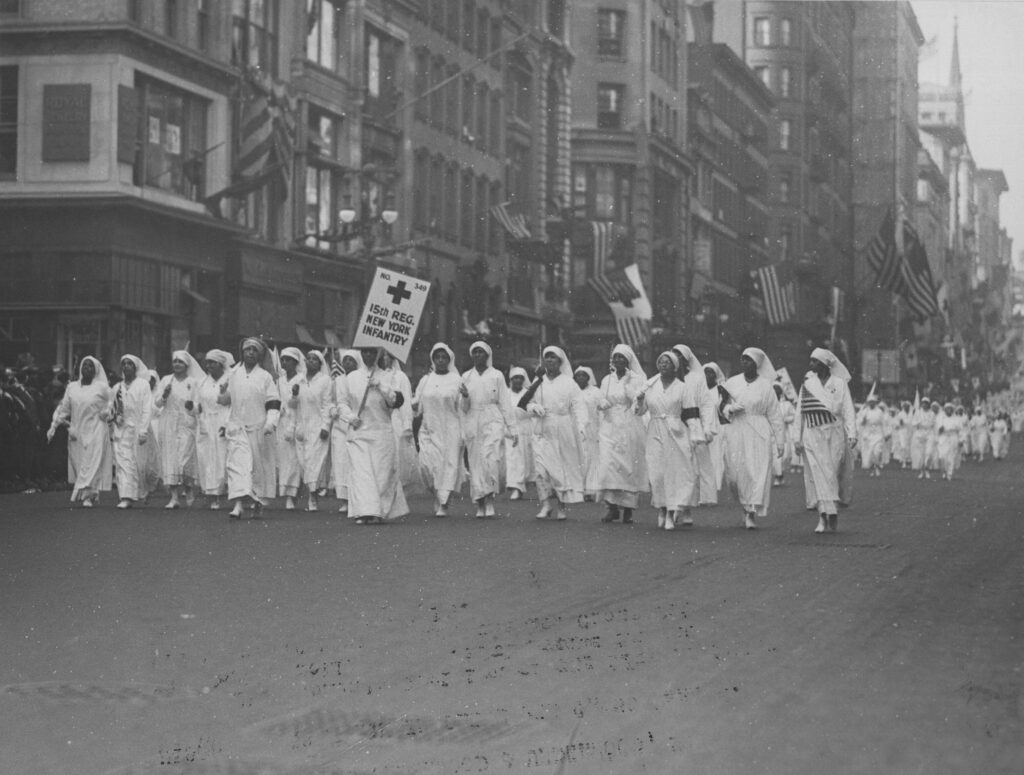
American Red Cross Parade, Women’s Division of the 15th Regiment New York National Guard (369th Infantry Division), 1918.
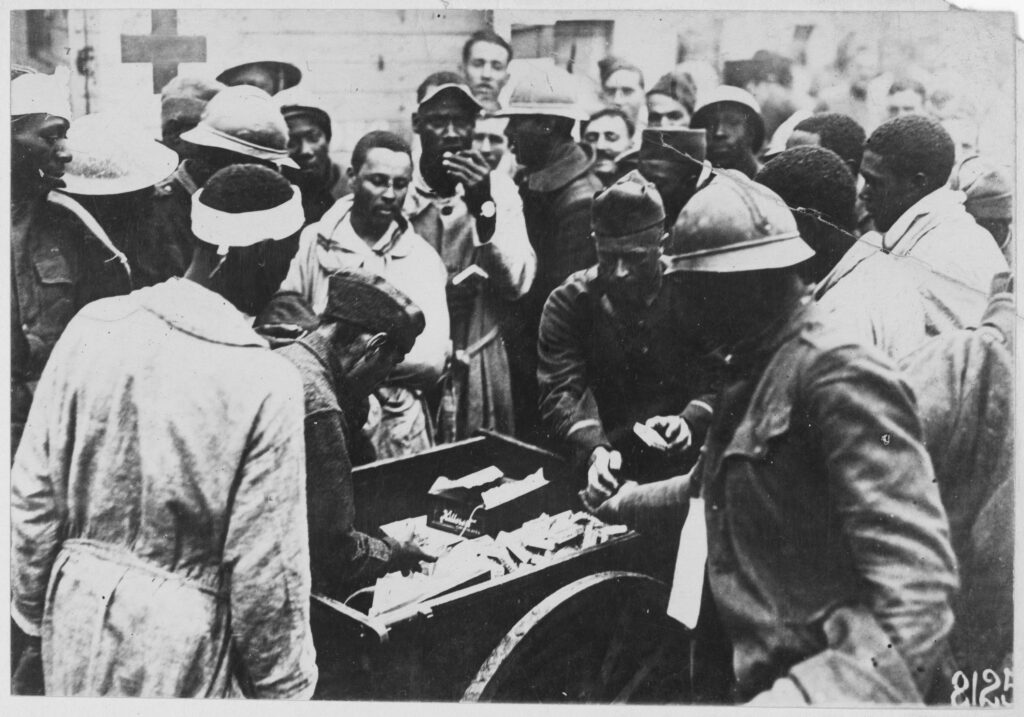
“American Red Cross workers distribute chocolate, cigarettes, and other items to wounded soldiers of the 93rd Division at the American Red Cross Hospital No. 5 in Auteuil, France.”
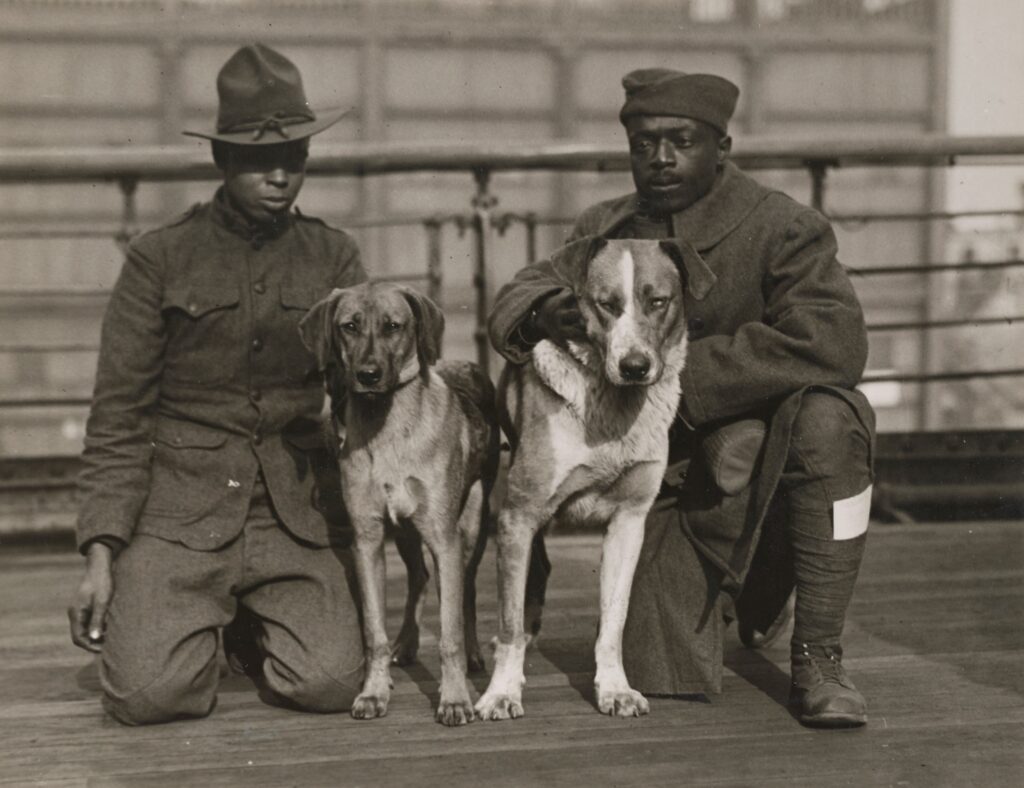
German Dogs “Crown Prince” and “Kaiser Bill” captured by Private Robinson Cleve, 529th Engineers, and Private Daniel Nelson, 372nd Infantry, 28 January, 1919.
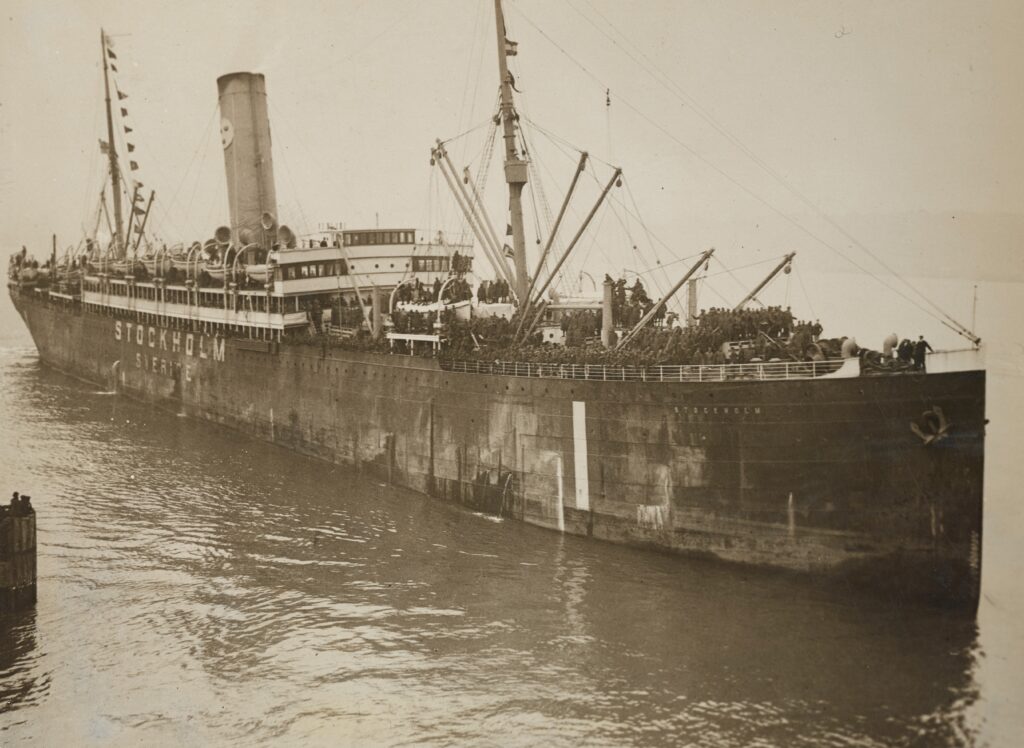
The transport ship Stockholm carrying some 1,000 members of the 93rd Infantry Division home, February 1919.
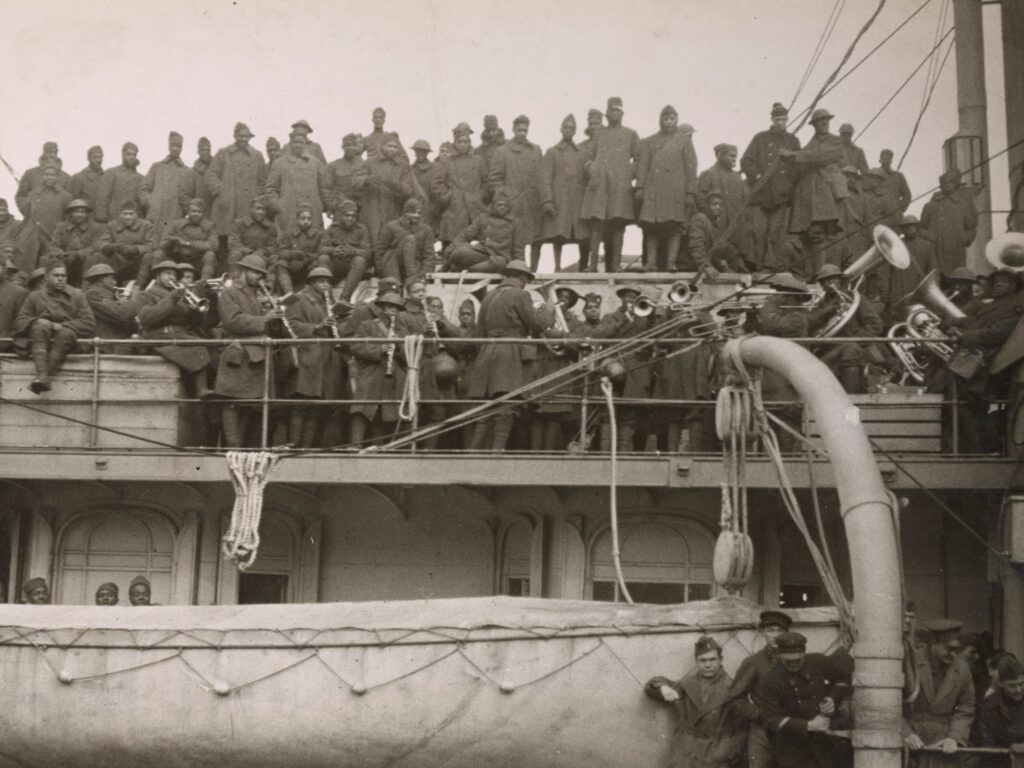
The 369th Infantry Regiment Band plays before disembarking in Hoboken, New Jersey, 10 February, 1919.

93rd Division Officers returning home. From left to right: Major J. R. White (369th Infantry Regiment), Lieutenant Colonel Otis B. Duncan (369th Infantry Regiment), and Lieutenant W. J. Warfield (370th Infantry Regiment), 10 February, 1919.
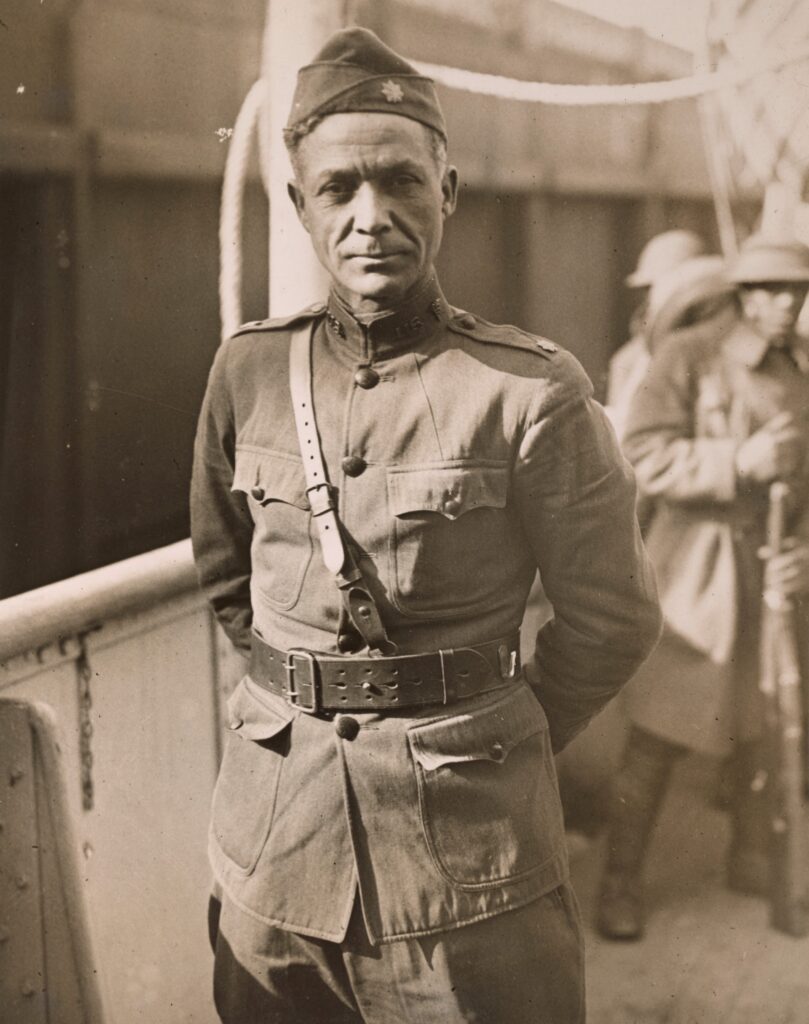
Major Joseph H. Ward, US Medical Corps, attached to 369th Infantry Regiment. He was the only African-American officer to achieve the rank of Major during the war. Hoboken, New Jersey, 10 February, 1919.
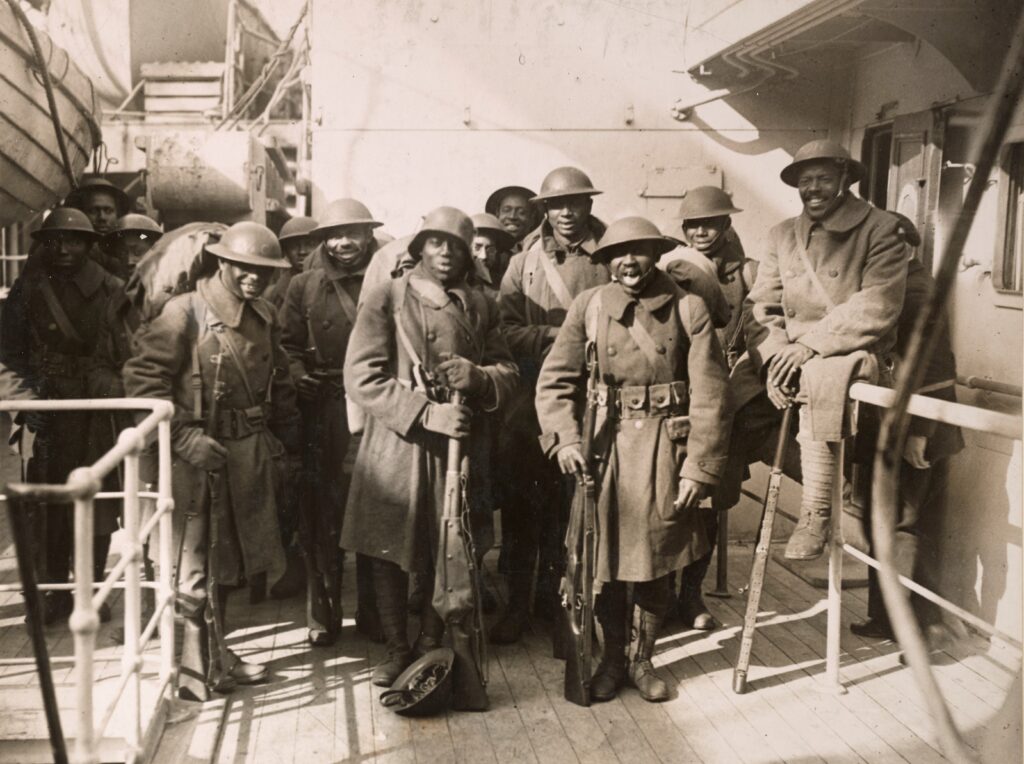
Soldiers of the 369th Infantry Regiment ready to disembark in Hoboken, New Jersey, 10 February, 1919.
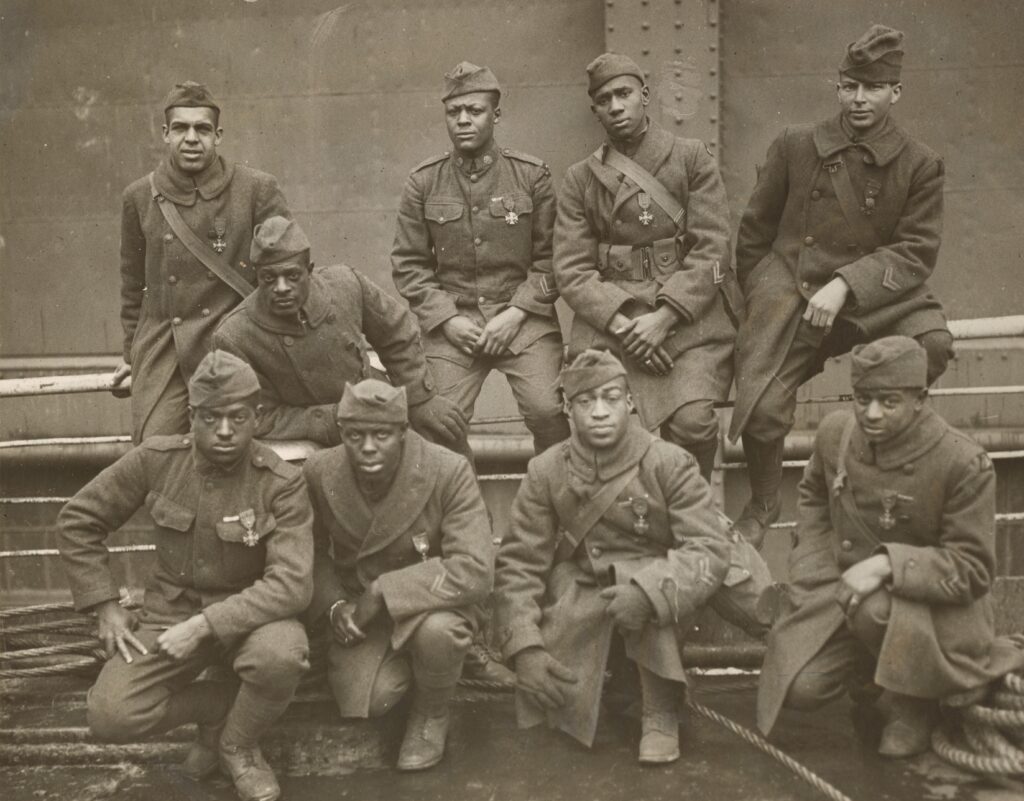
Members of the 369th Infantry Regiment who won the Croix de Guerre for gallantry in action. Bottom row, from left to right; Private Ed “Eagle Eye” Williams, Private Herbert “Lamp Light” Taylor, Private Leon Fraitor, Private Ralph “Kid Hawk” Hawkins. Back Row, from left to right: Sergeant H. D. Prinas, Sergeant Dan Storms, Private Joe “Kid Woney” Williams, Private Alfred “Kid Buck” Hanley, and Corporal T. W. Taylor. 12 February, 1919.
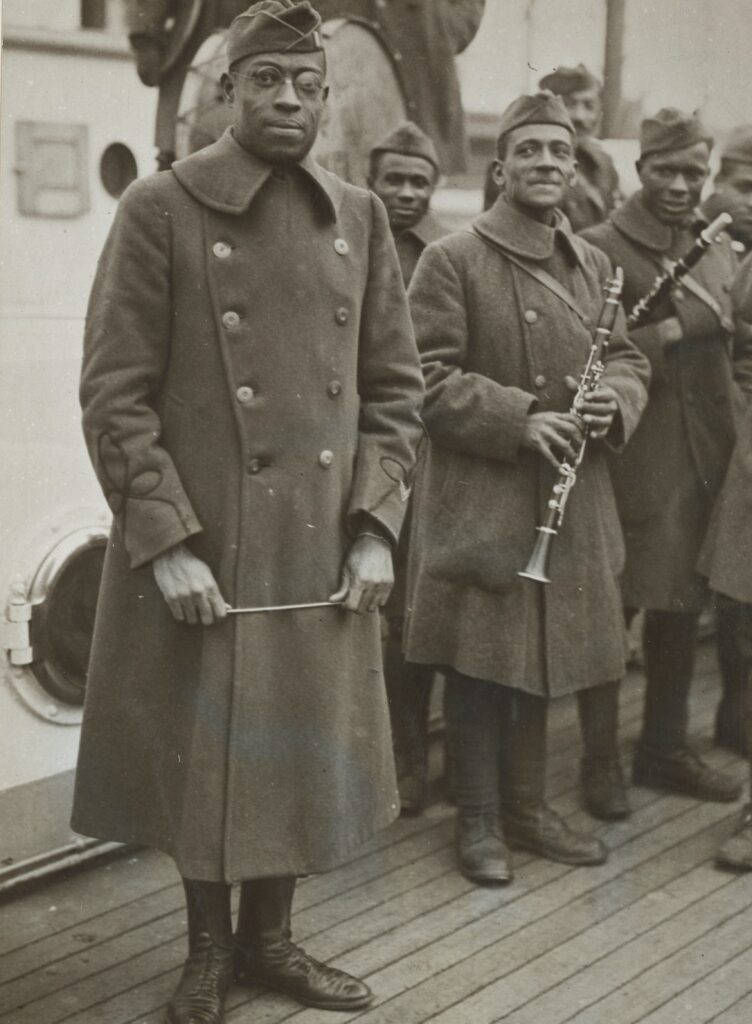
Lieutenant James Reese Europe, a famous jazz musician and Band Leader of the 369th Infantry Regiment, February, 1919.
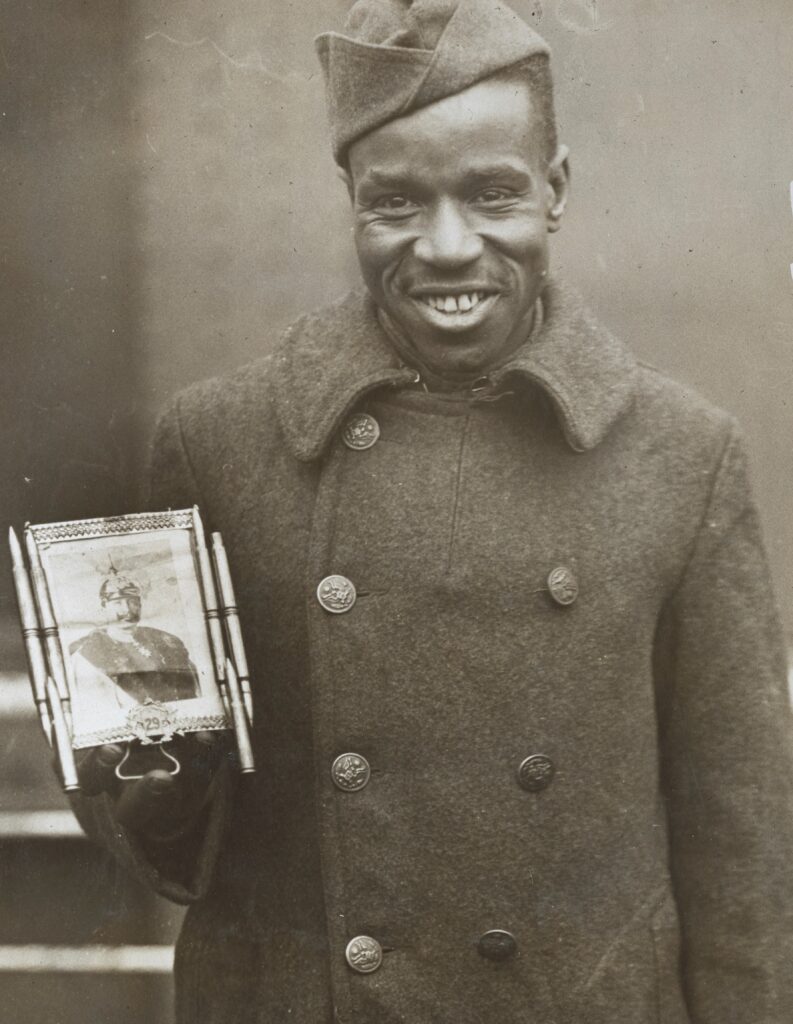
Corporal Fred “Devil’s Man” McIntyre (369th Infantry Regiment) poses with a picture of the German Kaiser that he kept for luck, 12 February, 1919.
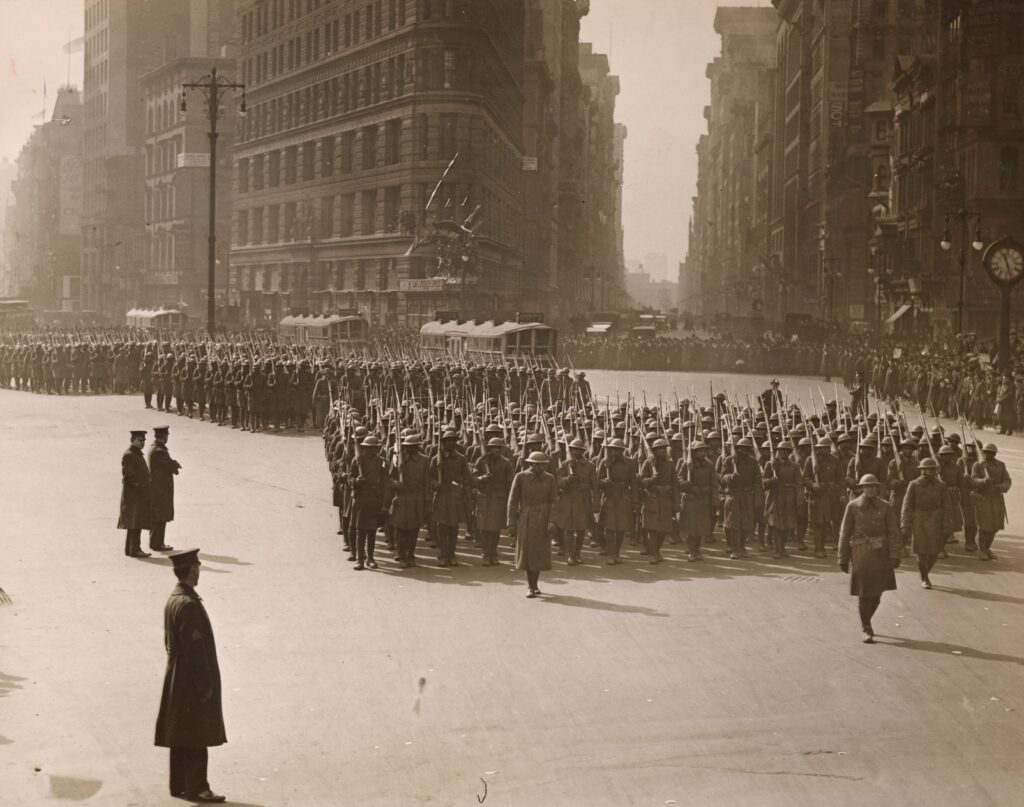
The 369th Infantry Regiment begin their victory parade at the Flatiron Building, New York City, New York, 17 February, 1919.
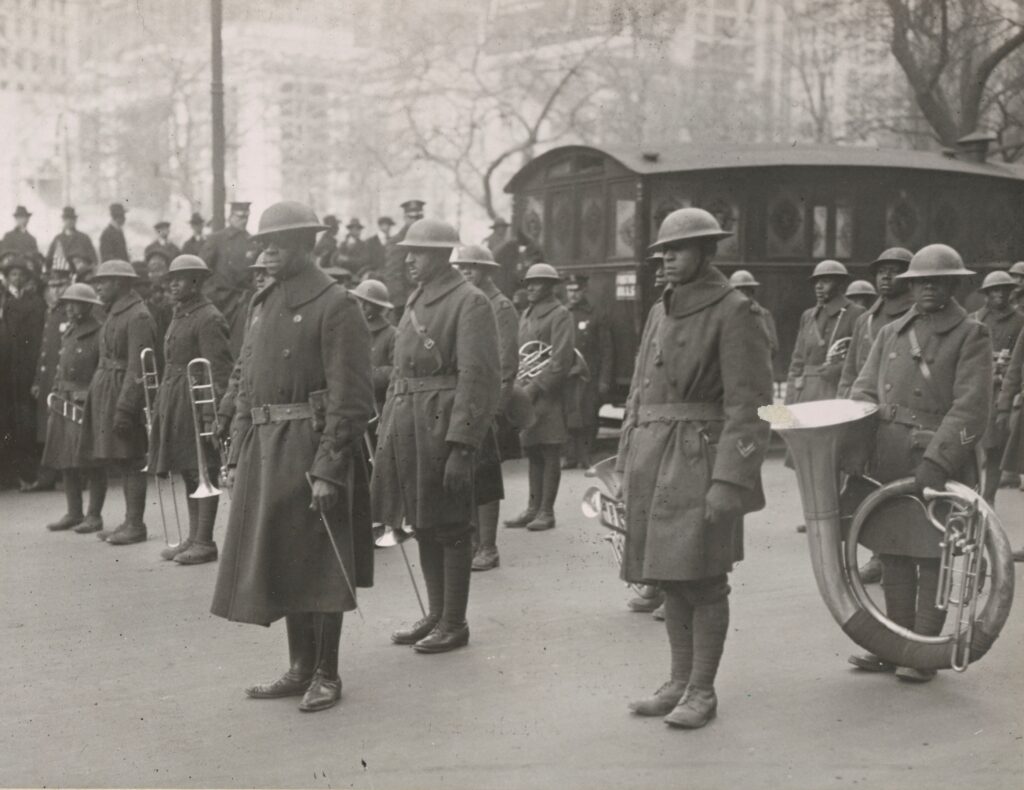
Lieutenant James Europe and his band during the 5th Avenue Parade, New York City, New York, 17 February, 1919.
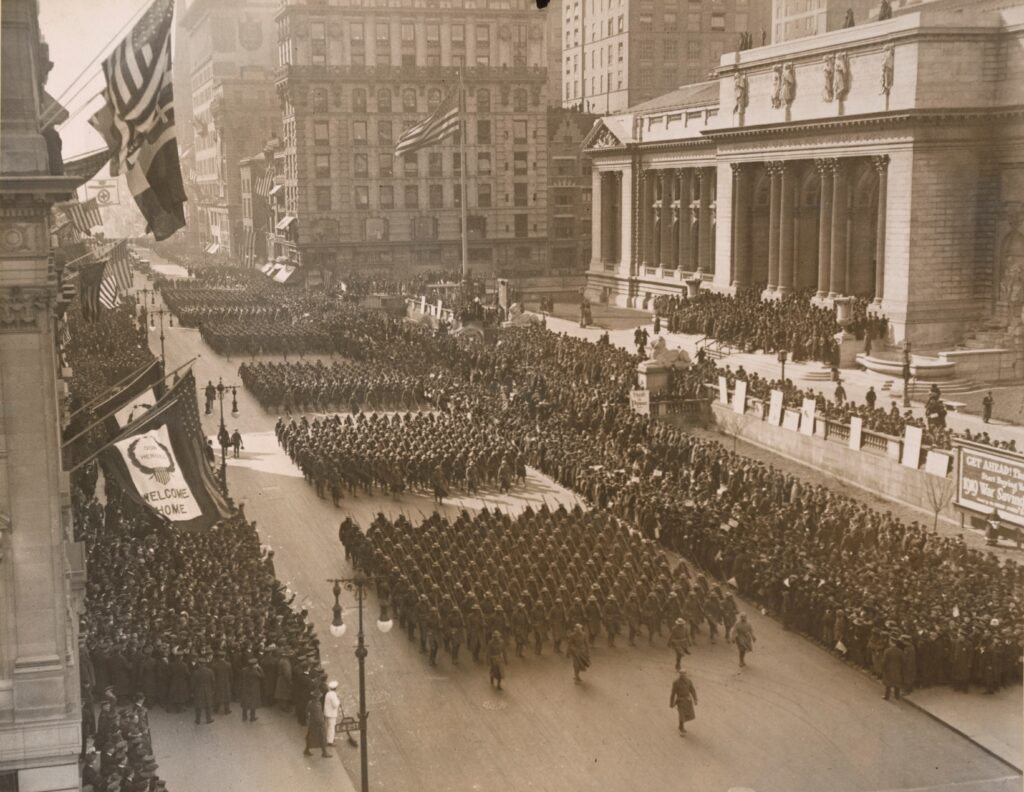
369th Infantry Regiment marching past the New York Public Library on 42nd Street and 5th Avenue, New York City, New York, 17 February, 1919.

Soldiers of the 369th Infantry Regiment passing down 5th Avenue. The standing man with the bouquet is Medal of Honor recipient Private Henry Johnson. New York City, New York, 17 February, 1919.

Members of the 369th Infantry Regiment passing up 5th Avenue in formation, New York City, New York, 17 February, 1919.

The men of the 369th Infantry Regiment swing up Lenox avenue during their parade, New York City, New York, 17 February, 1919.
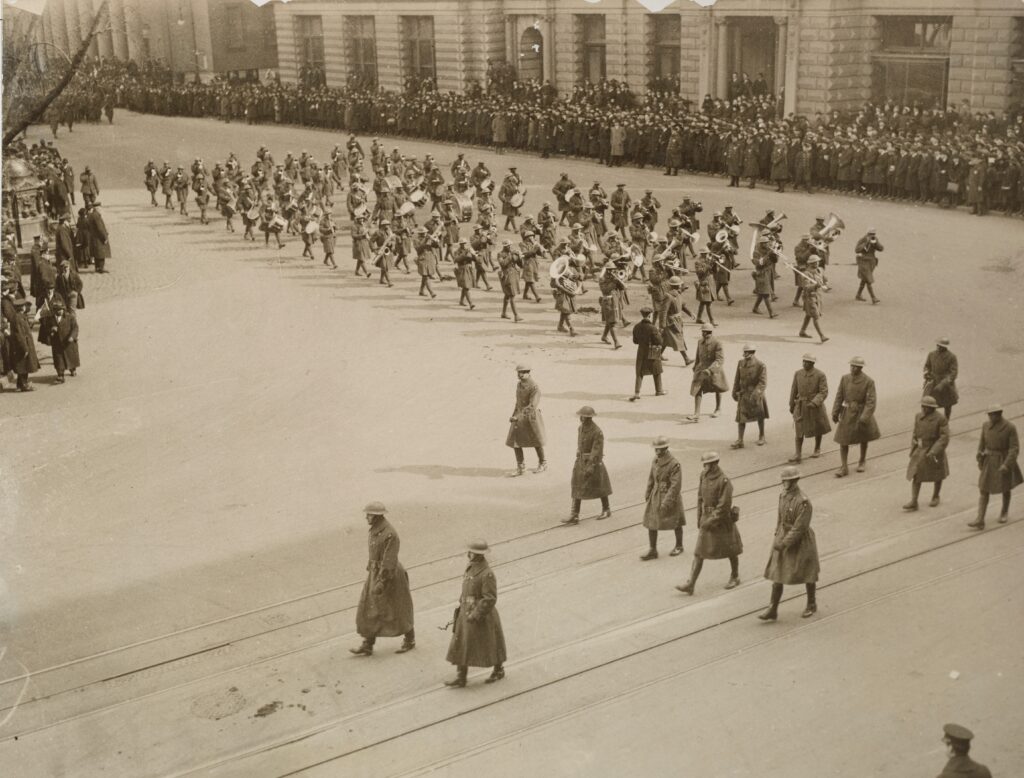
Lieutenant James Reese Europe and the 369th Infantry Regiment Band reach Lenox avenue, New York City, New York, 17 February, 1919.
93rd Division - Oise-Aisne Offensive
The Oise-Aisne Offensive began on 18 August 1918 when the French Tenth Army attacked in the area of Noyon, France with the objective of forcing the Germans to abandon their defensive lines along the Vesle and Aisne Rivers. The offensive was to continue as a secondary operation while the Meuse-Argonne offensive began on 26 September 1918, both offensives were to eventually converge. The 370th Infantry Regiment operated with the French Tenth Army in the Oise-Aisne Offensive, while the 369th, 371st, and 372nd Infantry Regiments operated as part of the French Fourth Army in the Meuse-Argonne.

Given the success of the British-French attack between the Oise and Scarpe Rivers, the German Army began a tactical withdrawal between the Vesle and Scarpe Rivers between 3 to 7 September 1918. The French Tenth Army came across new German positions along the Ailette River, and on 14 September 1918 the French Tenth Army attacked the line: Vailly-sur-Aisne – Fort de la Malmaison – Chavignon.
The objective was to force another German withdrawal from the line of the Aisne River. However, the attack was only slightly successful and the French troops were ordered to organize defensive positives and remain prepared in case of another German withdrawal.
The 370th Infantry Regiment
The 370th Infantry Regiment was assigned to the French 59th Division (part of the French Tenth Army) and entered the line on 17 September 1918 as a part of the French XXX Corps. Taking over the missions of the French 17th and 66th Division, which the French 59th Division had just relieved, the 370th assisted in stiff fighting that resulted in no change in the lines.
Companies [F], [G], [I], and [L] of the 370th Infantry were attached to the frontline regiments of the French 59th Division, and although not originally in the assault echelon, they had participated in fighting near Moisy Ferme and Mont des Singes. Meanwhile, the rest of the 370th remained in division reserve in the area of Antioche Farm.
Throughout the night of 22 September, and into the early morning of 23 September 1918, the 370th Infantry entered the line between Vauxaillon and Canal de l’Oise a l’Aisne. The 1st Battalion, 370th Infantry had relieved French troops in the frontline along the road between Champ Vailly and Ecluse.
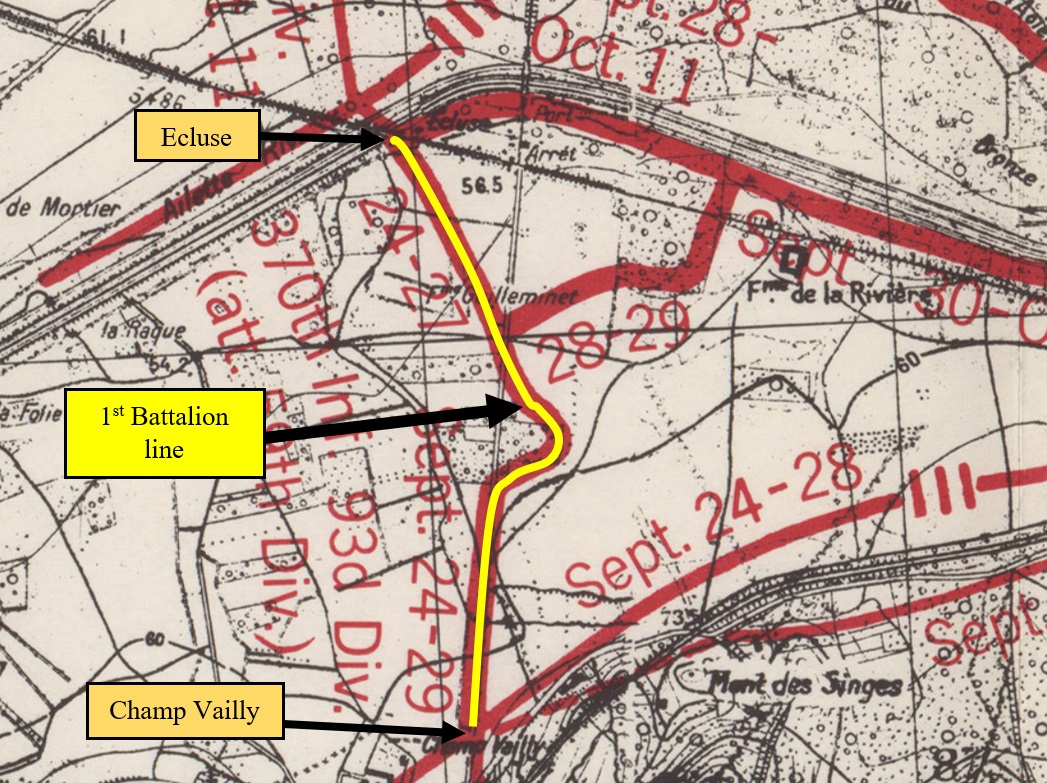
The 2nd Battalion was placed in support near Les Tueries (about 1,700 meters west of Vauxaillon), while the 3rd Battalion was placed in reserve near Tincelle Farm (about 1,400 meters southwest of Antioche Farm). Once in position, the 370th took command of the left subsector on the 24th September 1918. There was local fighting in the right zone of action of the French 59th Division between 25 to 27 September, of which the 370th Infantry Regiment engaged in minor combat actions to clear enemy positions from the triangle formed by the road, the canal, and the railroad.
The Army Group of the German Crown Prince approved the tactical withdrawal of the German Seventh Army to Canal de l’Oise a l’Aisne and Bois de Mortier during the night of 27 September and early morning of 28 September 1918.

This withdrawal was necessary to the survival of the German units within the area due to the desperately needed reinforcements in the Champagne and Meuse-Argonne areas, where the American First Army and the French Fourth Army were battering away at the German lines in their general attacks starting 26 September 1918. It was also necessary to avoid dramatic German losses entailed in holding the Laffaux Salient nearly 4 kilometers southwest of Pinon.
Following the German evacuation of positions south of Canal de l’Oise a l’Aisne, information of the withdrawal was obtained by the French around 0100 hours (1:00 A.M.) on 28 September 1918. The French were ready to make a all-out charge on the frontline and ordered an attack at daybreak to gain contact with the Germans. The 370th Infantry received orders to attack as its 2nd Battalion was being relieved on the frontline, regardless, the relief was completed.
The advance began at 0800 hours (8:00 A.M.) and German resistance presented itself from Mont des Singes, Ferme de la Riviere and Bois de Moriter. The right of the 370th Infantry Regiment was unable to advance, however, its left was successful and occupied the woods west of Ferme de la Rivere by noon on 28 September 1918. The position was held facing east toward the farm, and north toward the canal.
Throughout the day, despite hardened German resistance, the French forces persisted and captured the towns of Pinon, Ouvrage Pierre, Ouvrage Jacques, and Mont des Singes around the area of the 370th Infantry. At 1720 hours (5:20 P.M.) the French 59th Division issued orders for a continuation of attack for the night of 28 September, of which the 370th participated, with the sector of the 370th extending from the Pinon – Brancourt road crossing to Ecluse.
Between the 28 and 29 September, the 370th Infantry remained in combat against stubborn German resistance. Although the fighting was continuous throughout the daytime, only small gains had been made whereby Patrols of the 370th had crossed the canal and entered Bois de Mortier but were quickly driven back by German machine-gun fire.
The attack continued without any changes to the objectives on 30 September 1918, and the French managed to capture the line of bastions in Foret de Pinon as well as the Sawmill (Scierie) west of the Anizy railroad station. The 3rd Battalion, 370th Infantry Regiment moved into a position along the railroad northeast of Vauxaillon and relieved the 2nd Battalion of the 370th Infantry, excluding Company [F], which remained along the canal and within the woods west of Ferme de la Riviere. The 3rd Battalion and Company [F] (of the 2nd Battalion) attacked at 1500 hours (3:00 P.M.) and captured the farm, then established a position along the canal from the Pinon-Brancourt road bridge/crossing to the French 59th Divisional boundary.
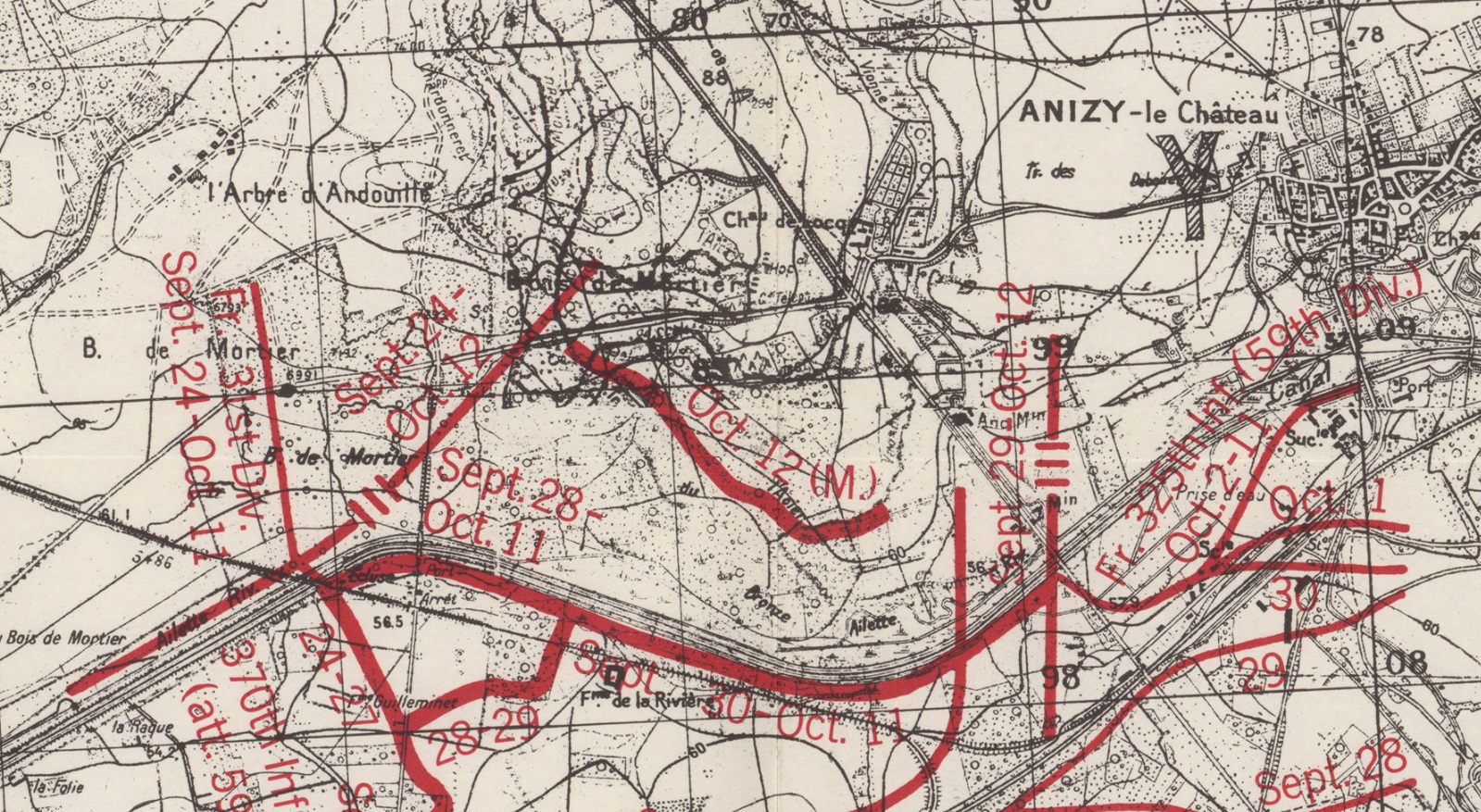 Between 1 and 3 October 1918, the French captured the Anizy railroad station, the sugar factory (Sucrerie) south of Anizy, and conducted mop-up operations south of the canal. While these advances were being made, the 370th Infantry engaged in mop-up operations south of the canal as well. The French 59th Division was ordered to organize its sector for defense and make preparations to cross the canal and capture Anizy-le Chateau.
Between 1 and 3 October 1918, the French captured the Anizy railroad station, the sugar factory (Sucrerie) south of Anizy, and conducted mop-up operations south of the canal. While these advances were being made, the 370th Infantry engaged in mop-up operations south of the canal as well. The French 59th Division was ordered to organize its sector for defense and make preparations to cross the canal and capture Anizy-le Chateau.
Between 4 to 11 October 1918, the French 59th Division (including the 370th Infantry Regiment) actively patrolled and prepared to cross the canal and the Ailette River. Unsuccessful attempts were made to build temporary bridges across the canal despite indications that the German were withdrawing. On 4 October 1918, the 3rd Battalion, 370th Infantry reconnoitered the western portion of Bois de Mortier and on6 October 1918, the French 59th Division was assigned to the French XVI Corps.
The 3rd Battalion, 370th Infantry Regiment’s Company [C] relieved Company [F] along the canal west of Ferme de la Riviere throughout the night of 7 October 1918 and the 1st Battalion relieved the 3rd Battalion in the frontline throughout the night of 8 October 1918. The continued attacks by the French and Americans in the Champagne Region, as well as between the Meuse River and Argonne Forest, forced the Germans to execute a withdrawal between 10 and 13 October 1918.
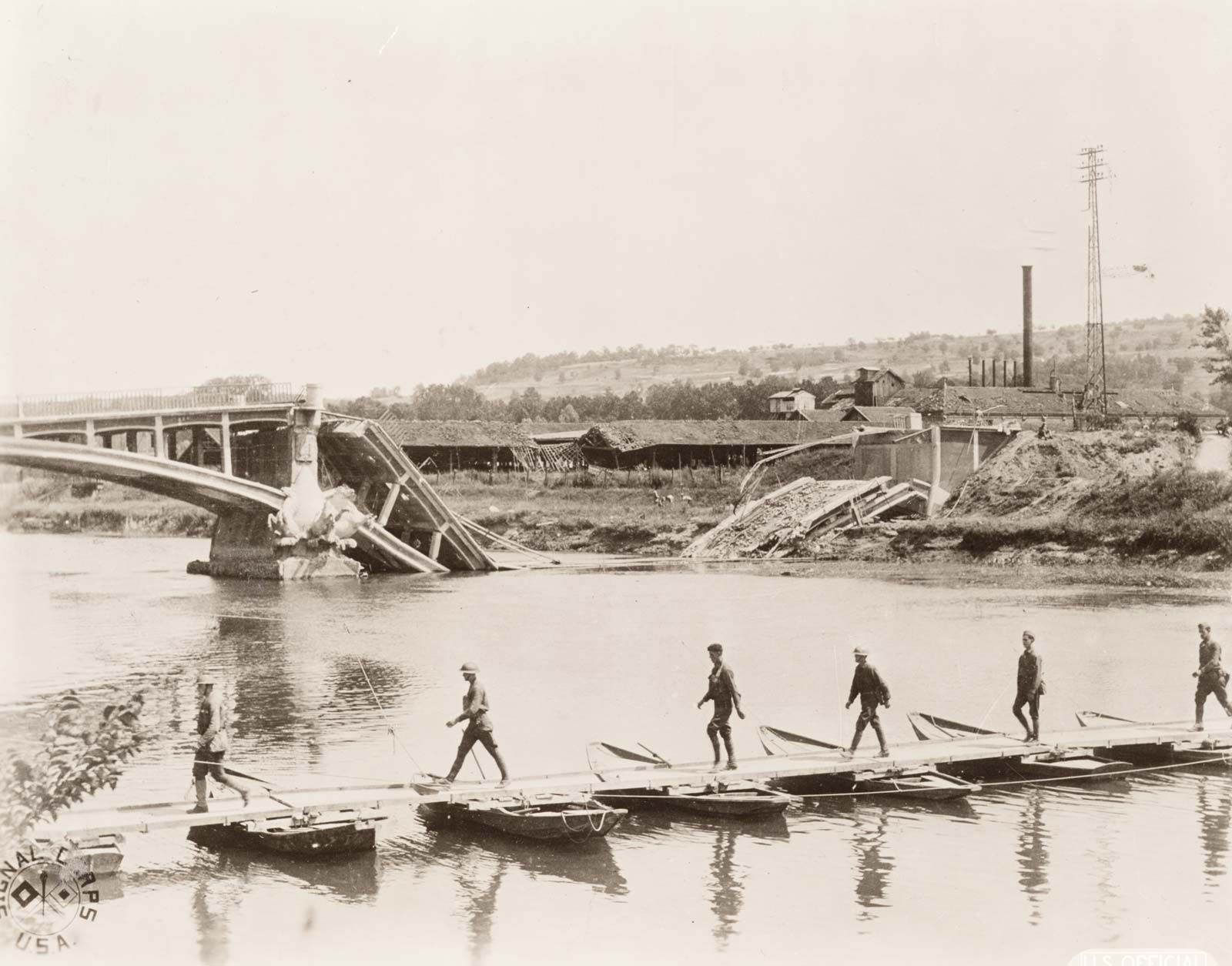 By 12 October 1918, German artillery had ceased altogether, however, patrols continued to meet German resistance and the first attempts to cross the Pinon-Brancourt bridge had failed. At 0630 hours (6:30 A.M.), the bridge had finally been capture and the crossing of the canal had begun.
By 12 October 1918, German artillery had ceased altogether, however, patrols continued to meet German resistance and the first attempts to cross the Pinon-Brancourt bridge had failed. At 0630 hours (6:30 A.M.), the bridge had finally been capture and the crossing of the canal had begun.
Soon after, the 1st Battalion, 370th Infantry (aided by the French 31st Division to its left) crossed the canal and advanced approximately 500 meters and entered Bois de Mortier. With Bois de Mortier captured, the first phase of the German pursuit by the French 59th Division was complete and the French 59th Division (including the 370th Infantry) was passed down to division reserve or acted as support during the rest of the operation.
On 13 October 1918, the 370th was passed to the reserve of the French Tenth Army and remained in the area of Cessieres and reorganized for road construction duties.
The French Tenth Army was relieved by the French Third Army on 27 October 1918, and the French 59th Division was assigned to the French XVIII Corps with the task of relieving the French 127th Division located northeast of Laon. The relief was completed on 30 October 1918 and command of the sector was passed to the French 59th Division at 1000 hours (10:00 A.M). The mission of the French 59th Division was to join in the attacks to capture the line of La Serre Riviere, as well as be ready to aggressively pursue any German withdrawal.
The French 59th Division (artillery included) was placed at the disposal of the French XVIII Army Corps effective at noon to ensure the relief of the French 127th Division. General Orders No. 2020/3 instructed one battalion of the 370th Infantry to move forward during the night and station itself at the end of the march at Allemagne and Coudedeau Farms, meanwhile the headquarters and two other battalions of the 370th Infantry were to move into conformity with orders to be given at a later time.
 To complete its mission, the French 59th Division organized the sector between its French 232nd and 325th Infantry Regiments. The 370th Infantry Regiment’s battalions were divided and assigned to support and reserve echelons for the French 59th’s attack. In the case of a German withdrawal, the frontline battalions were ordered to immediately pursue the German forces by using the support battalions for a passage of lines. The main objective was to obtain the line of La Serre Riviere and organize defensive positions after its capture.
To complete its mission, the French 59th Division organized the sector between its French 232nd and 325th Infantry Regiments. The 370th Infantry Regiment’s battalions were divided and assigned to support and reserve echelons for the French 59th’s attack. In the case of a German withdrawal, the frontline battalions were ordered to immediately pursue the German forces by using the support battalions for a passage of lines. The main objective was to obtain the line of La Serre Riviere and organize defensive positions after its capture.
In early November the Germans were forced to withdrawal to previously prepared defensive positions of the Antwerp-Meuse line. The German withdrawal opposite of the French 59th Division commenced on 4 and 5 November 1918. The German withdrawal was discovered during a patrol in the early morning of 5 November 1918 and the French 59th quickly responded by taking pursuit. (Picture below, French troops engage with the Germans outside of Saint Pierremont).
On 5 November 1918, the 1st Battalion, 370th Infantry Regiment was attached to the French 325th Infantry Regiment and entered the frontline. Although German resistance consisted of delaying actions to slow the pursuit of their units via artillery and machine-guns, regardless, the advance was rapid and by nightfall the division had held the south bank of the Serre River. The 1st Battalion held a position on the hills overlooking Saint Pierremont overnight. (Picture below, church located in Saint Pierremont today and in 1914-15)

The following day, 6 November 1918, the French 59th Division continued its pursuit with the objective of capturing the railroad through Jeantes la Ville. The 1st Battalion, 370th Infantry advanced through Bois du Val St. Pierre, where Company [C] captured a German artillery battery. It was here that heavy machine-gun resistance was encountered and the division was forced to establish a line along La Brune Riviere for the night, the 1st Battalion of the 370th spent the night in the frontline on the right of the division, east of Nampcelles-la-Cour.
On 7 November 1918, the pursuit was once again continued. At 0600 hours (6:00 A.M.) the advance toward a line between the plateau of La Hayette Ferme and Bas Val-la Caure as the objective. Very strong German resistance was encountered along the line of the Aubenton-Hirson railroad, and the French 59th Division halted and held a line both south and north of Hurtebise as well as east of Beaume. The 1st Battalion, 370th Infantry halted at Monplaisir, however, wasn’t in the frontline.
The advance objectives changed to capturing the Maubert-Fontaine-Hirson railroad on 8 November 1918. The 370th’s 1st Battalion was relieved by its 3rd Battalion, while its 2nd Battalion entered the line along the railroad east of Beaume as part of the French 232nd Infantry Regiment (on the left). The Germans stubbornly resisted and little progress was made throughout the day. A detachment from the 3rd Battalion, 370th Infantry had reached Logny les Aubenton as the rest of the 3rd Battalion remained near Hurtebise and charged with protecting the right flank of the French 59th Division. Meanwhile the 2nd Battalion partook in fighting east of Beaume, and at the end of the day the French 59th Division held a line facing Aubenton.
Field Report 529-30.1 on 8 November 1918 stated that at 2000 hours (8:00 P.M.), the 370th were holding the northern edges of Logny and the south edges of the Aubenton Railroad Station. The formation listed Captain Patton’s 2nd Battalion in line, with Colonel Duncan’s 3rd Battalion in Support.
On 9 November, the attack order was resumed with the previous days objectives having been unchanged, however, an hour before the attack commenced the French 59th Division had learned that the German positions had been abandoned overnight. At 1500 hours (3:00 P.M.), the French 59th Division reached the objective of Maubert-Fontaine-Hirson Railroad. The front of the 3rd Battalion, 370th Infantry held Pont d’Any, while the 2nd Battalion advanced and held a position at Goncelin throughout the night.
On 10 November 1918, the French 59th Division was assigned to the French XVI Corps and ordered to continue its pursuit of the Germans to the line between Taillette – le Cul des Sarts. During the day, the division’s advance guard reached a line along the eastern and northern edges of Bois des Hingues. The 3rd Battalion, 370th Infantry was located north of Eteignieres but not within the front lines.
On the day of the Armistice, 11 November 1918, the French 59th Division and the 370th had continued its advance with its objectives having been unchanged. The advance had met slight resistance but the French 59th Division reached the Rocroi – Regniowez road by 1100 hours (11:00 A.M.), the time the Armistice became effective, with the divisional cavalry occupying Taillette with outposts located in La Verte Place. By 1100 hours (11:00 A.M.), the 3rd Battalion, 370th Infantry Regiment discontinued its advance and was located at Le Gue d’Hossus.
After the Armistice became effective, the 370th Infantry was concentrated in the area of Aubenton then moved to the area north of Laon. On 13 December 1918, the 370th was relieved from duty with the French 59th Division and relocated to Soissons, where ten days later it moved to the American Embarkation Center of Le Mans to return to the United States. On 2 February 1919, the 370th Infantry Regiment embarked the ship La France IV in Brest, France and arrived one week later in New York to little praise, celebration, or recognition.
The total casualty count of the 370th Infantry Regiment during the Oise-Aisne Offensive was 665: 560 being wounded, 15 dying of their wounds, and 90 being Killed In Action (KIA).
93rd Division - Meuse-Argonne (Champagne) Offensive
While the 370th Infantry Regiment of the 93rd Division were fighting in the Oise-Aisne Campaign, the rest of the 93rd Division’s infantry regiments (369th, 371st, and 372nd) were participating in the Meuse-Argonne (Champagne) Offensive as part of the French Fourth Army, French IX Corps, and taking heavy casualties. The 369th Infantry Regiment was attached to the French 161st Division, French Fourth Army; while the 371st and 372nd were attached to the French 157th Division, French Fourth Army.
The Champagne region is located on the northeast of the Paris basin, although known for its for its flat plains, chalky soil, low hills, and the valley of the Marne River; it also holds a series of escarpments that transform into ridgelines and are great for use as a natural barrier. The terrain within the Argonne Forest consisted of broadleaf forest growing on ridges that raised 300 feet above the surrounding land, meanwhile the Meuse River ran parallel to the Argonne Forest and the Meuse Heights that consisted of a range of hills that raised over 600 feet above the battlefield made the land notoriously difficult to navigate.
“The effect of the high ground to left and right is to turn the sector into a long, shallow channel. This configuration, with the ridges running across the sector and Montfaucon in the center, gave the Germans good observation over perhaps 80 percent of the battlefield, with the remainder visible from balloon or aircraft [reconnaissance]. Small though Montfaucon is, it had twenty-three artillery observation posts on it because the lie of the land gave it panoramic views as far south as Verdun. In 1918, with artillery at a peak of accuracy, the sector was effectively a shooting gallery, with the attacks troops and rear areas exposed o shell fire at all times.”
-Harries, Meirion, and Susie Harries. The Last Days of Innocence: America at War, 1917-1918. New York: Vintage Books, 1998. Page 349-350
The Champagne cradled intricate German trench networks that had been built and reinforced since the beginning of the war in 1914, with the German Third Army improving the fortifications in the rear-guard positions. The necessity of the Meuse-Argonne (Champagne) Offensive came from the Spring Offensive launched by the Germans in 1918.
As a result of the German offensives, the Allied reserves had faced almost certain defeat unless the Americans provided immediate support from the American Expeditionary Forces (AEF). The AEF Commander-in-Chief, John J. Pershing, had postponed the concentration of American Divisions for the formation of the American Army and made all American combat units available for the British and French, given this assistance the Allies were able to stop the German offensive before it had won a decisive victory during its counter offensive beginning on 18 July 1918 in the Marne Salient. During the Marne Salient counteroffensives, a strategic plan was agreed upon by the Allied forces to reduce the various salients that interefered with railroad communications, including the Saint Mihiel Salient.
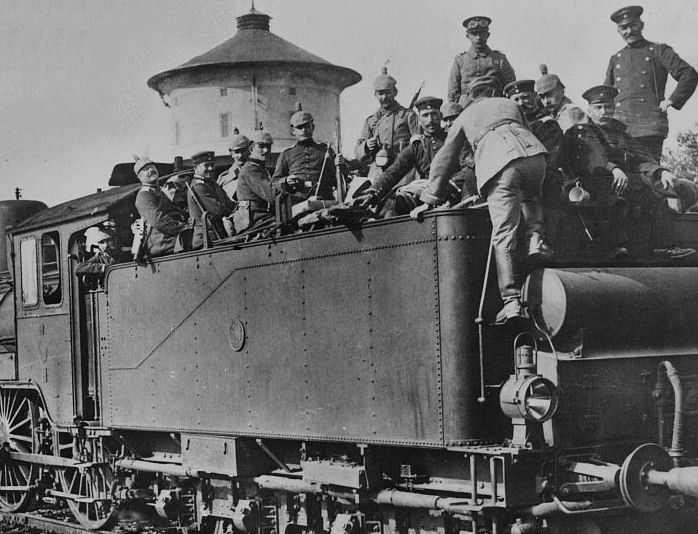 The Meuse-Argonne (Champagne) Offensive began on 26 September 1918 and was the largest operation the American Expeditionary Forces had participated in, involving over 1 million American servicemembers and had a total casualty count over 350,000 (over 26,000 being American). The Meuse-Argonne Offensive of the American First Army and the French Fourth Army was directed against the principal German lateral line of supply (the Carignan-Sedan-Mezieres railroad), which laid about 53 kilometers from the front at the town of Sedan. This railroad was the final objective of the Meuse-Argonne Offensive, and was a stretch of the four-track railroad that linked German General Ludendorff‘s Armies with Germany. The railroad was responsible for carrying a vast amount of German troops and munitions vital to the German war effort.
The Meuse-Argonne (Champagne) Offensive began on 26 September 1918 and was the largest operation the American Expeditionary Forces had participated in, involving over 1 million American servicemembers and had a total casualty count over 350,000 (over 26,000 being American). The Meuse-Argonne Offensive of the American First Army and the French Fourth Army was directed against the principal German lateral line of supply (the Carignan-Sedan-Mezieres railroad), which laid about 53 kilometers from the front at the town of Sedan. This railroad was the final objective of the Meuse-Argonne Offensive, and was a stretch of the four-track railroad that linked German General Ludendorff‘s Armies with Germany. The railroad was responsible for carrying a vast amount of German troops and munitions vital to the German war effort.
The American First Army was organized on 10 August 1918, where on 30 August 1918 it had assumed command of the front between Port-sur-Seille (east of the Moselle River) to Watronville (approximately 11 kilometers southeast of Verdun). On 12 September 1918, components of the American First Army conducted the Saint Mihiel Offensive and reduced the Salient by 16 September 1918. With the salient reduced, the Allies could now being their push into German lines on 26 September 1918. Various offensives were conducted, including the American operations between the Meuse River and Argonne Forest supported by the French Fourth Army located between the Argonne Forest and Suippes River (left of the American First Army). Overall, the campaign would be the final Allied effort of the Great War, deciding the fate of who were to be the victors in the four years of death and carnage.
The mission of the French Fourth Army, and subsequently the 369th, 371st and 372nd Infantry Regiments of the 93rd Division, was to advance toward the Aisne River. Preparations were in the works and at 2100 hours (9:00 P.M.) of 23 September 1918, the 372nd Infantry left Dommartin for Camp des Mangineux, arriving at 0030 hours (12:30 A.M.) in the morning of 24 September 1918. During the day, the 372nd left Mangineux to relocate to Hans, where upon arrival it joined the French IX Army Corps.

“A glass plate stereoview slide with handwritten label 1st Ligne, Beausejour (Frontline, Beausejour). French soldiers are seen in a trench on the frontlines in Beausejour. The photograph was taken between 28 July, 1914 and November 11 1918 in France during World War One.” A single battalion of the 369th Infantry Regiment, 93rd Division had entered frontlines similar to what is depicted in this photograph.
During the night of 24 September and early morning of 25 September 1918, the support battalions of the 369th Infantry Regiment were attached to the French 161st Division. They were ordered to move forward to positions within the rear of the French frontline troops as the reserve battalion moved to a position nearly 4 kilometers south of Bois de Beausejour. To the French 161st Division’s right flank was the French 74th Division of the French XXXVIII Corps and to the right was the French 161st Division’s 2nd Moroccan Division of the French IX Corps. Meanwhile, the 371st and 372nd Infantry Regiments were held in reserve of the French 157th Division located about 14 kilometers south of Ripont at Somme-Bionne.
At 2300 hours (11:00 P.M.) on 25 September 1918, the French artillery opened fire all along the front to begin a 6 and a half hour artillery barrage preparatory to the offensive. An observer of the French artillery barrage remarked that “The thunder and roar of the massed artillery shook the earth and the sky was alight with the flashes of the guns. It was wondrous – it was insanity and the fever gripped us all.“
26 September 1918:
On 26 September 1918, the Meuse-Argonne Offensive had officially began with the American First Army and the French Fourth Army beginning their advance in the morning following a rolling barrage at 0525 hours (5:25 A.M.). A dense fog and smoke had blanketed the Argonne that was so thick that it was reported one could only see as far as 40 feet. A solid thicket of French and German barbed-wire covered nearly 1,000 feet of “no-man’s land,” accompanied by thick underbrush that turned the intertwined man-made and natural obstacles into a nearly impenetrable terrain.
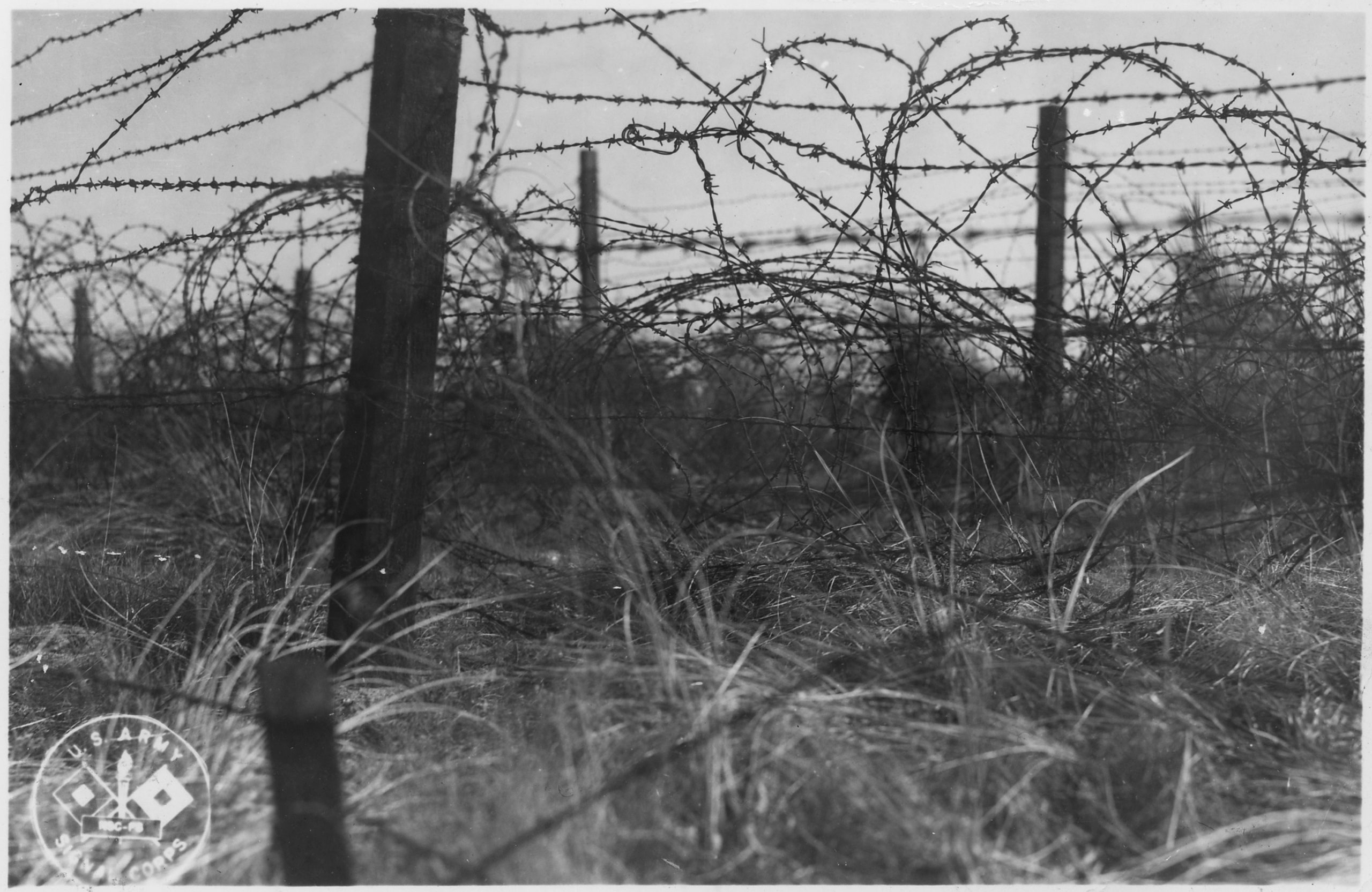
The French IX Corps, of which the 369th, 371st, and 372nd Infantry Regiments were attached, battle plan was to attack in a northward direction with French divisions abreast. The 2nd Moroccan Division was located on the left while the French 161st Division, with the 369th Infantry attached, was located on the right. Meanwhile, the French 157th Division, with the 371st and 372nd Infantry Regiments remained in reserve with the task of filling any gaps that may occur during the advance.
The tough German defenses and challenging terrain created obstacles for the advance. In the path of the advance was the Dormoise River followed by the heavily forested ridgeline known as Bellevue Signal Ridge, which extended over 2 kilometers across the route of the advance and where numerous villages laid in the paid that had been fortified by the German defenders.
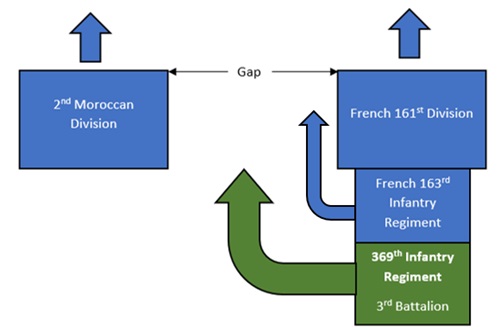
The French 161st Division, of which the 369th Infantry was attached, had encountered no resistance during their advance to their first position. The French 161st continued their advance, shortly thereafter a gap had opened between the 2nd Moroccan Division and the French 161st Division. The 369th Infantry, upon its own initiative, closed the gap and placed three battalions in column with its 3rd Battalion leading the way.
The 3rd Battalion, 369th Infantry, remained abreast the 2nd Moroccan and French 161st Division’s for the remainder of the day, and had advanced on the town of Ripont alongside the 2nd Moroccan Division and the French 163rd Infantry Regiment. The 3rd Battalion crossed La Dormoise Riviere around 0800 hours (8:00 A.M.) as the French 163rd Infantry reached the Rouvroy-Ripont Road around the same time. German fire from the north had halted the advance of the 3rd Battalion, 369th Infantry as well as the French 363rd Infantry Regiment on the far right flank of the French 163rd Division, of which the 2nd Battalion of the 369th Infantry was attached.
“At 8 A.M. of the 26th of September, our assault was started through the Calvaire Sector. Many prisoners were taken and sent to the rear, as well as large quantities of guns, machine guns, ammunition and supplies. The town of Ripont was also captured by 3rd Battalion. The Moroccan troops at the same time attacked the Butte de Mesnil, a strongly fortified German position, which had always withstood all attempts to reduce it. However, in a sustained attack occupying two days, the defense was overcome and the Moroccans caused the [Germans] to retire in confusion. The casualties on both sides, owing to the fact that most of the fighting was of the hand to hand type, were exceedingly heavy.”
– George S. Robb, Manuscripts Collection 51: 1887-1972.
At noon, 26 September 1918, the French 161st division issued the order to continue its assault after a heavy artillery barrage commenced on the German line of resistance. This assault would continue to the road extending northwest through “crossroads 188,” located about 600 meters north of Fontaine-en-Dormoise. When this objective was reached, the 1st Battalion of the 369th Infantry was to remain as Division Reserve as the 2nd and 3rd Battalions were given orders to attack and hold Tranchee de Bellevue and the slopes descending from Bellevue Signal Station located to the northeast. The attack was to commence behind a rolling barrage as soon as the 2nd and 3rd Battalions of the 369th were ready.
Attacks were attempted at 1530 (3:30 P.M.) and 1700 hours (5:00 P.M.) but despite the artillery bombardment against the German lines, the German resistance remained heavy and the low-lying ground on both sides of the Dormoise River created a natural defense in slowing the advance, with its muddy and marshy soil that remained exposed to the German machine-guns. The 3rd Battalion, 369th Infantry held the left portion of the line on the slopes north of La Dormoise Riviere with the French 163rd Infantry (center) and French 363rd Infantry (right). This line extended from the area of Tranchee de Brun along the Rouvroy-Ripont Road.
During the night of 26 September 1918, the French 157th Division, of which the 371st and 372nd Infantry Regiments were attached, had been moved to the area of Butte du Mesnil. This location was near the original line of attack on 25 September 1918, but well behind the French 161tst Division and 369th Infantry Regiment.
27 September 1918:
The French IX Corps ordered a continuation of attack for 27 September 1918 without any changes to the objectives of the French 161st Division, and an advance was ordered to a line between Mont Cuvelet – Tranchee de Bellevue, by two successive stages. The French 161st Division ordered the attack to commence at 0515 hours (5:15 A.M.) after a 30-minute artillery bombardment on the German lines, and the attack lines consisted of the French 163rd Infantry Regiment on the left, the 369th Infantry in the center, and the French 363rd Infantry Regiment on the right; the 3rd Battalion of the 369th had been ordered as the assault echelon with its 2nd Battalion in support and 1st Battalion remaining in division reserve.
Despite the preparations made throughout the night of 26 September and early morning of 27 September 1918, the attack did not begin on time due to the slow transmission of orders. The delay in communications due to translation and transmission had resulted in the 3rd Battalion of the 369th Infantry being delayed in entering its line of departure.
At 0915 hours (9:15 A.M.) on 27 September 1918, the French 161st Division ordered its French 163rd Infantry Regiment to attack to the left of the zone of action assigned to the 369th Infantry. The general advance of the French 163rd and 363rd Infantry Regiments commenced between 1000 (10:00 A.M.) and 1030 hours (10:30 A.M.), and the French 161st Division ordered its 163rd Infantry Regiment, assisted by the 363rd Infantry Regiment, was to attack to the north and advance to the southern edge of the wooded area about 1 kilometer north of Ripont known as Parc. As the French regiments commenced their attack, the 369th Infantry was ordered by the French 161st Division to move forward in a column of battalions and be placed in line between the French regiments after reaching its objective.
At 1230 hours (12:30 P.M.) the French 161st Division announced that the flank divisions were side-by-side, which made it possible for the Germans to offer serious resistance along the plateaus north of Fontaine-en-Dormois and Bellevue Signal Ridge. Subsequently, a strong advance was ordered behind a rolling artillery barrage. By 1425 hours (2:25 P.M.), a line had been reached along the crest of the hill north of Fontaine-en-Dormois and crossroads 188, and was held throughout the night with the 369th Infantry Regiment in rear of the line inside Fontaine-en-Dormois as well as along the Fontaine-en-Dormois – Gratreuil Road.
At 1720 hours (5:20 P.M.), the French 161st Division issued orders calling for a continuation of attack in the direction of Mont Cuvelet – Croix Renard. The division cavalry was ordered before daybreak the following day (28 September 1918) to precede the infantry between the town of Sechault and Bouconville. Orders had also specified that the Germans were holding Bellevue Signal Station and an infantry attack would be necessary, supported by artillery concentration on the station, to start at 1830 hours (6:30 P.M.). However, the attack on Bellevue Signal Station was not made on 27 September 1918. Throughout the night, the 2nd Battalion of the 369th Infantry relieved the 3rd Battalion in the frontline.
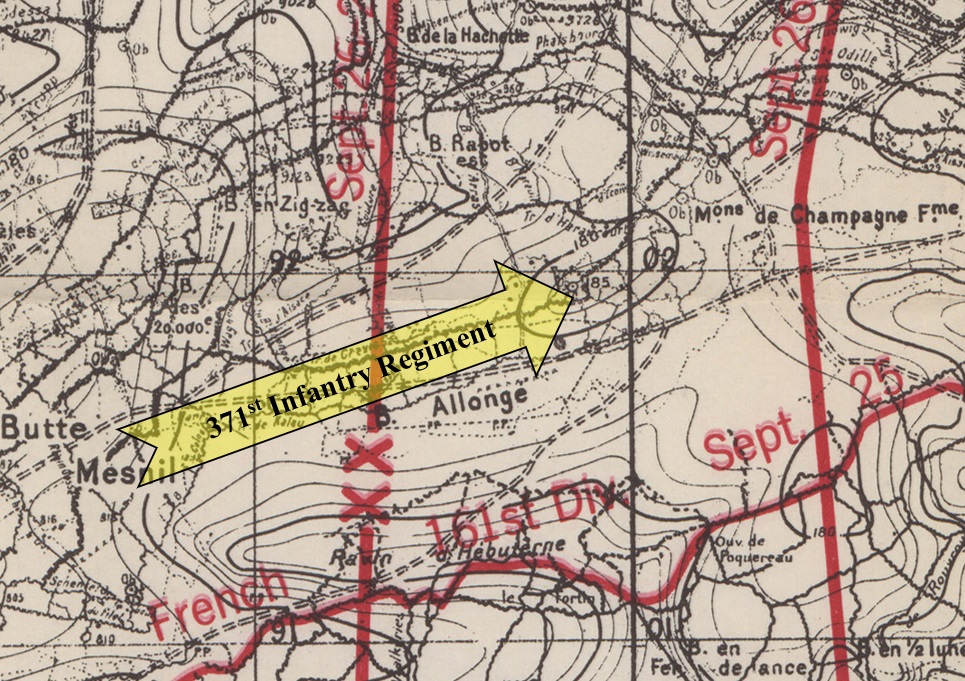 Meanwhile, earlier in the day at about noon on 27 September 1918, the French 157th Division ordered the 371st Infantry Regiment to march from Butte du Mesnil to the crests between Maisons de Champagne Ferme and Butte du Mesnil. Around 1230 hours (12:30 P.M.), as the French 161st Division and the 369th made their assault, the 371st Infantry Regiment made its march to relocate.
Meanwhile, earlier in the day at about noon on 27 September 1918, the French 157th Division ordered the 371st Infantry Regiment to march from Butte du Mesnil to the crests between Maisons de Champagne Ferme and Butte du Mesnil. Around 1230 hours (12:30 P.M.), as the French 161st Division and the 369th made their assault, the 371st Infantry Regiment made its march to relocate.
At 1600 hours (4:00 P.M.), the French 157th Division ordered the 371st Infantry to move in the direction of Ripont-Bussy Ferme, which would be followed by a battalion of the French 333rd Infantry. The 371st was to dispose its battalion in depth to occupy the positions between the 2nd Moroccan Division on the left and the French 161st Division on the right, with a boundary set in a southwest-northeast direction through the crossroads located about 500 meters south of Le Pied. Around 1725 hours (5:25 P.M.), the 371st Infantry continued its advance in accordance to the orders of the French 157th Division.
28 September 1918:
The march of the 371st Infantry was in progress throughout the night, and the regiment had arrived to its destination at the break of dawn on 28 September 1918, astride the Ripont-Gratreuil Road with its leading elements at the Fontaine-en-Dormois-Gratreuil Road. The 1st Battalion of the 371st Infantry was the lead element, with the 3rd then 2nd Battalions following.
The 372nd Infantry (excluding its 2nd Battalion), in accordance to the French 157th Divisions orders, moved throughout the day to Ravin-d’Hebuterne. At midnight, the 372nd Infantry Regiment continued its march to Ripont and arrived at 0230 hours (2:30 A.M.) on 28 September 1918.
At 0130 hours (1:30 A.M.) on 28 September 1918, the French 161st Division issued field orders announcing that if the plateau of Bellevue Signal Station hadn’t been taken during the night of 27 September or early morning of 28 September 1918 by the French 163rd Infantry and the 369th Infantry Regiments, the attack would be renewed at 0700 hours (7:00 A.M.). Since the attack had not occurred, a the orders of the French 161st Division would stand and at 0330 hours (3:30 A.M.) the 369th were given orders to attack. With the 2nd Battalion of the 369th now on the front, and abreast of the flanking French Regiments, the 3rd Battalion stayed in close support. A preparatory artillery barrage bombarded the German signal station at 0430 hours (4:30 A.M.) and the infantry attacked.
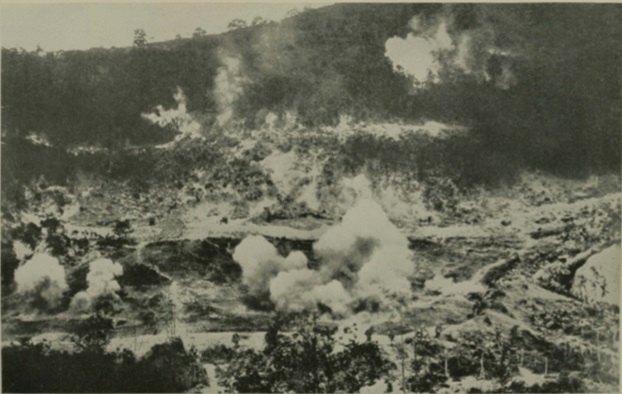 Regardless of the supporting barrage, the Germans provided stiff resistance with machine-gun fire from the ridge of Bellevue Signal Station against the 369th. Nonetheless, the 369th prevailed with the 74th Division to its right, with the right portion of the line reaching a northwest-southeast line on the ridge and extending south of the crossroads near Bellevue Signal Station. However, the left and center was unable to pass the crossroads around 500 meters south of Le Pied.
Regardless of the supporting barrage, the Germans provided stiff resistance with machine-gun fire from the ridge of Bellevue Signal Station against the 369th. Nonetheless, the 369th prevailed with the 74th Division to its right, with the right portion of the line reaching a northwest-southeast line on the ridge and extending south of the crossroads near Bellevue Signal Station. However, the left and center was unable to pass the crossroads around 500 meters south of Le Pied.
Around 0900 hours (9:00 A.M.) the 369th Infantry repulsed a German counterattack, and at 1400 hours (2:00 P.M.), the French 161st Division gave stated that the crest of Bellevue Signal Station would be taken. By 1600 hours (4:00 P.M.), the advance elements held a line along the road just south of Tranchee de Bellevue. However, this line was lost and the 369th were forced to organize its line on the southern slopes of the plateau for the night. Around midnight, the French 161st Division issued orders to take complete possession of Bellevue Signal Station, the spur located to the northeast, and Mont Cuvelet.
In the French 157th Divisions zone of action, the 371st Infantry began its attack at 0645 hours (6:45 A.M.) on 28 September 1918, with a 500-meter wide front. 1st Battalion, 371st Infantry was the lead element, followed by its 3rd Battalion and then the 2nd Battalion. The advance occurred after a passage of lines had been made through the right battalion of the 2nd Moroccan Division (on the 371st Infantry’s left flank). German machine-gun fire dramatically slowed the advance and caused disorganization that left a gap between the right flank of the 371st Infantry and the left flank of the French 161st Division. At 0840 hours (8:40 A.M.), the French 157th Division ordered the 372nd Infantry to advance from Ripont with two of its battalions to fill the gap.
The 3rd Battalion, 372nd Infantry Regiment was placed as the assault battalion, with the 1st battalion following 1 kilometer behind in support and the 2nd Battalion was to remain in reserve. Around 1130 hours (11:30 A.M.), the 1st and 3rd Battalions were engaged in combat. With the combined attack between the 371st and 372nd Infantry Regiments, the western slope of Bellevue Signal Ridge was taken. By nightfall, the advance elements had reached the heights south of Bussy Farm and slopes of Le Pied.
After dark, 3rd Battalion of the 371st Infantry was relocated to the left of the 1st Battalion and Bussy Farm was occupied for the night. On the right portion of the 372nd, two companies of the 372nd Infantry continued their advance, but had lost direction and became separated from other elements of the 3rd Battalion. Portions of these companies reached positions west of Sechault at the road junction and had spent the night there, the remaining elements of the 372nd Infantry were located on the slopes of Le Pied.
29 September 1918:
The French 157th Division had issued orders at 0200 hours (2:00 A.M.) on 29 September 1918 for its attacks that day. The mission of the division to cover the right flank of the 2nd Moroccan Division while simultaneously advancing in the direction of Monthois, taking the German positions on the plain east of Marvaux during its movement. The French 157th directed the assault to commence at 1000 hours (10:00 A.M.) in three columns, with the French 333rd Infantry on the left, the 371st Infantry in the center, and the 372nd Infantry Regiment on the right. At 0645 hours (6:45 A.M.), the division issued further orders that prescribed intervals of 500 meters between the assault regiments.
The 371st Infantry were ordered to attack around 0915 (9:15 A.M.) and verbally transmitted their orders to the 3rd Battalion to attack at 1000 hours (10:00 A.M.), however, the orders weren’t actually received by the 3rd Battalion by 1000 hours (10:00 A.M.). Given that the French 333rd Infantry commenced their attack, the 3rd Battalion advanced with them despite receiving the orders. Company [K], located on the leftmost portion of the 3rd Battalion, helped attack German machine-gun positions and drive back German infantry which allowed the French to continue their advance. Company [K] reached positions about 750 meters northwest of Ardeuil were it had formed on the line with French troops for the remainder of the night.
 The attacking regiments of the French 157th were to be on their line of departure at 0930 hours (9:30 A.M.) and attack in a northward direction. Upon receipt of the orders, the 372nd Infantry replaced the 3rd Battalion with its 1st Battalion in the assault echelon, with the 3rd Battalion now acting as support. The attack began at 1000 hours (10:00 A.M.) as ordered and the 1st Battalion, 372nd Infantry advanced to the right of its assigned axis toward the town of Sechault. The situation became further complicated when it was discovered that the French 161st Division to the right of the 372nd Infantry hadn’t begun its forward movements.
The attacking regiments of the French 157th were to be on their line of departure at 0930 hours (9:30 A.M.) and attack in a northward direction. Upon receipt of the orders, the 372nd Infantry replaced the 3rd Battalion with its 1st Battalion in the assault echelon, with the 3rd Battalion now acting as support. The attack began at 1000 hours (10:00 A.M.) as ordered and the 1st Battalion, 372nd Infantry advanced to the right of its assigned axis toward the town of Sechault. The situation became further complicated when it was discovered that the French 161st Division to the right of the 372nd Infantry hadn’t begun its forward movements.
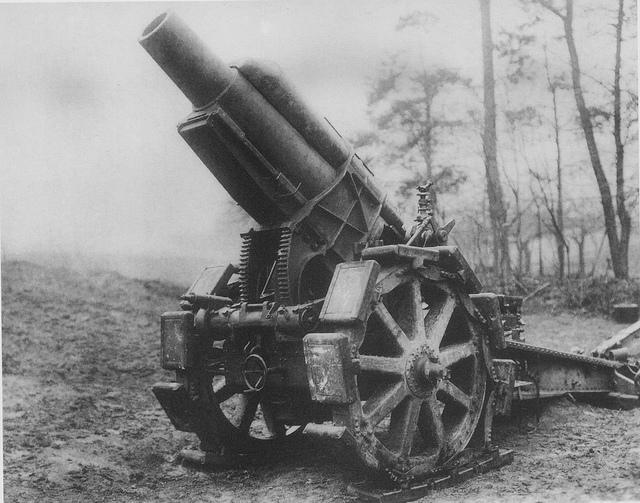 Around 1300 hours (1:00 P.M.), patrols of the 372nd Infantry entered the town of Sechault, but were driven back by German machine-gun fire. Luckily, during the morning of 29 September 1918, the 1st Battalion of the 369th Infantry was ordered to pass through the lines of the 2nd Battalion and take the town of Sechault. This passage of lines commenced shortly after noon and the 1st Battalion began its attack on the town of Sechault at about 1425 hours (2:45 P.M.) from the heights south of the town. 1st Battalion, 369th Infantry attacked Sechault without artillery support, and had crossed a plain under heavy Austrian 88’s and German machine-gun fire. During the advance elements of Company [K] of the 372nd Infantry Regiment, who had gotten lost the night prior and spent the night west of Sechault, had come into contact with the 1st Battalion of the 369th. During the night of 29 September 1918, the 2nd Battalion of the 372nd Infantry was relocated to the ravine southwest of Bellevue Signal Station.
Around 1300 hours (1:00 P.M.), patrols of the 372nd Infantry entered the town of Sechault, but were driven back by German machine-gun fire. Luckily, during the morning of 29 September 1918, the 1st Battalion of the 369th Infantry was ordered to pass through the lines of the 2nd Battalion and take the town of Sechault. This passage of lines commenced shortly after noon and the 1st Battalion began its attack on the town of Sechault at about 1425 hours (2:45 P.M.) from the heights south of the town. 1st Battalion, 369th Infantry attacked Sechault without artillery support, and had crossed a plain under heavy Austrian 88’s and German machine-gun fire. During the advance elements of Company [K] of the 372nd Infantry Regiment, who had gotten lost the night prior and spent the night west of Sechault, had come into contact with the 1st Battalion of the 369th. During the night of 29 September 1918, the 2nd Battalion of the 372nd Infantry was relocated to the ravine southwest of Bellevue Signal Station.
Sechault was taken in the afternoon, and a line was consolidated to its north and east, the 2nd Battalion assisted the 3rd Battalion of the 369th Infantry in holding this line throughout the evening. The elements of Company [K], 372nd Infantry helped to mop-up portions of the town as the 369th held its line. During the night, the 369th Infantry were ordered to withdraw to the southern edge of Sechault from its position to allow a friendly artillery barrage to commence the following day. The 369th was greeted by the French regiments to its left and right, and the artillery barrage commenced just north of the town. The elements of Company [K], 372nd Infantry were withdrawn and reorganized south of Bussy Farm.
The 3rd Battalion, 371st Infantry (excluding Company [K]) advanced north with the rest of the 371st throughout the day and had captured the towns of Ardeuil and Montfauxelles. It established a line for the night in the railroad yards located north of Montfauxelles, but had lost contact with the French 333rd Infantry Regiment to its left flank until after midnight, and a gap in the line was recorded on its right flank between Sechault – Moulin Moya. The 2nd Battalion, 371st Infantry moved to Montfauxelles and formed a right-flank guard with a single company, while the 1st Battalion, 371st Infantry took positions just south of Sechault-Ardeuil road and extended the right-flank protection of the 2nd Battalion to the southwest.
Due to the heavy losses taken of both officers and enlisted men, the 1st and 3rd Battalions of the 372nd Infantry were reorganized into a provisional battalion during the night of 29 September 1918.
30 September 1918:
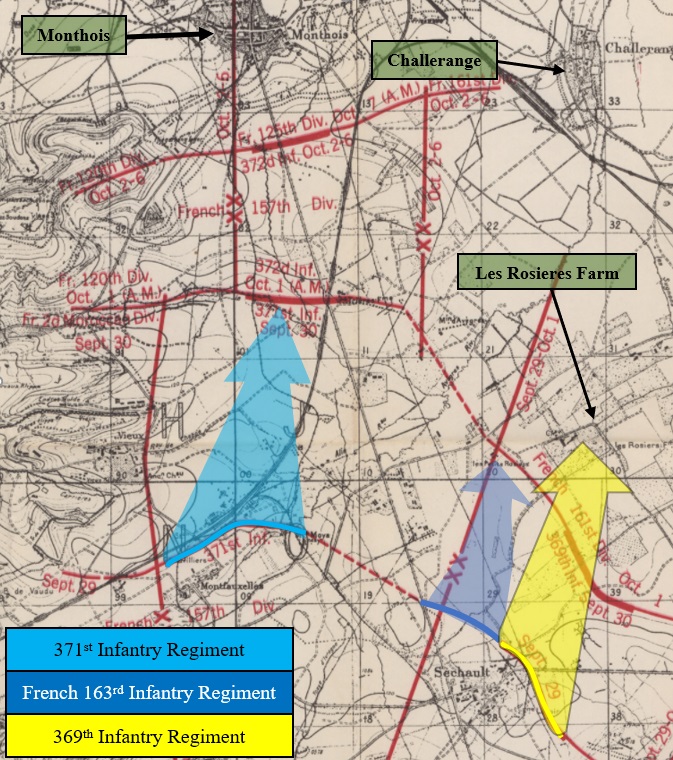 The French 157th Division was ordered by the French IX Corps to take the towns of Monthois and Savigny-sur-Aisne, while the French 161st Division were ordered to take Challerange and the heights to the north. The 369th Infantry had been warned that Challerange was strongly fortified and thus shouldn’t be attacked in a frontal assault until artillery preparation and partial encirclement had been made. The attacks began at 0700 hours (7:00 A.M.) with the French cavalry aiding the advance.
The French 157th Division was ordered by the French IX Corps to take the towns of Monthois and Savigny-sur-Aisne, while the French 161st Division were ordered to take Challerange and the heights to the north. The 369th Infantry had been warned that Challerange was strongly fortified and thus shouldn’t be attacked in a frontal assault until artillery preparation and partial encirclement had been made. The attacks began at 0700 hours (7:00 A.M.) with the French cavalry aiding the advance.
The 3rd Battalion, 371st Infantry Regiment lead the assault of the French 157th Division and was supported by the 2nd Battalion, 371st Infantry.
At 0830 hours (8:30 A.M.), the French 163rd Infantry Regiment was held up near Les Petit Rosier by German machine-gun fire from the east and southeast. The 1st Battalion of the 369th Infantry Regiment, followed by the 2nd Battalion, received fire from the right-rear flank but continued to advance in a northeast direction with the French 363rd Infantry alongside them on the right.
A battalion of the French 333rd Infantry attacked on each flank of the 371st Infantry, and had reached Trieres Farm by 0930 hours (9:30 A.M.). By 1100 hours (11:00 A.M.), the 371st and French 333rd Infantry had established a east-west line that was held immediately north of Trieres Farm where the regiments had halted for the remainder of the day.
By 1500 hours (3:00 P.M.), the advance had reached the line between the southwest corner of Bois de la Malmaison – les Petites Rosiers with the infantry regiments of the 161st Division abreast. Further advances on the left had been stopped due to the flooded condition of the Avegres Riviere, and couldn’t be flanked from the west without entering into the zone of action of the French 157th Division. Due to the inability of the French 161st Division and the 369th Infantry to pass the flooded areas of the Avegres Riviere, the 2nd Battalion of the 371st Infantry accompanied by the 1st Battalion were ordered to cover the right flank.
Awaiting further orders to launch an attack on Monthois, which had depending on the success of the 2nd Moroccan Division to the left of the French 157th Division, the 371st Infantry was relieved by the 2nd Battalion, 372nd Infantry during the night of 30 September and early morning of 1 October 1918. The 371st Infantry was then reorganized in the area of Ardeuil and remained in division reserve until the relief of the division during the night of 6 October and early morning of 7 October 1918.
Also throughout the night of 30 September and into the early morning of 1 October 1918, the 369th Infantry was relieved by the French 363rd Infantry Regiment and relocated to the area of Bellevue Signal Station. The 369th Infantry Regiment had remained in reserve until the French 161st Division was withdrawn from the line during the night of 6 October and early morning of 7 October 1918.
1 October 1918:
Just after midnight, the 372nd Infantry’s 1st and 3rd Battalions had moved to support positions 3 kilometers north of Sechault on the Sechault-Monthois road. Preparations to continue the attack on Monthois were being made along with the French 333rd Infantry, who held positions on both flanks of the 372nd Division.
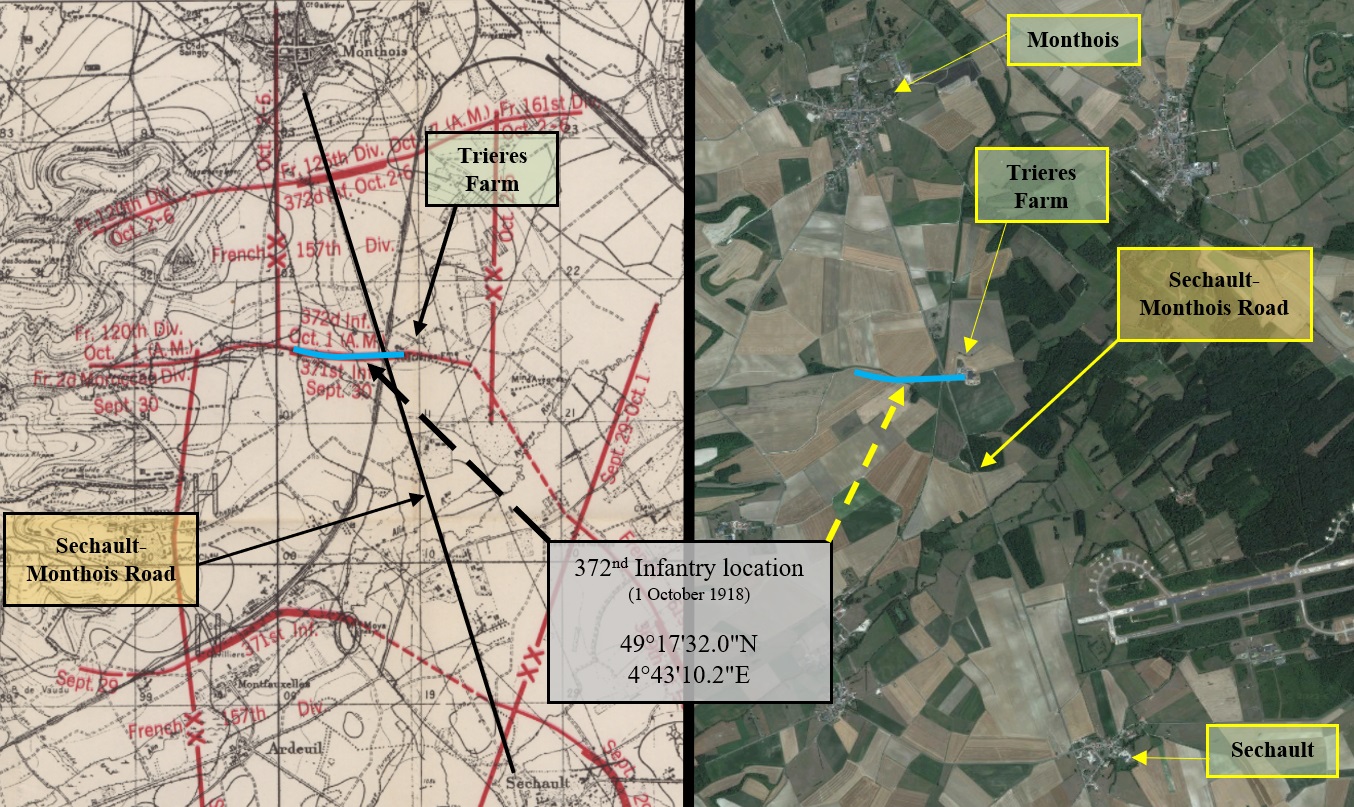
At 0500 hours (5:00 A.M.), the 2nd Battalion of the 372nd Infantry Regiment completed its relief of the 3rd Battalion of the 371st Infantry in the frontline north and west of Trieres Farm. At 0700 hours (7:00 A.M.), the French 157th Division issued orders to be ready to attack Monthois once the 2nd Moroccan Division was ready to attack and reconnaissance missions ordered in the direction of Challerange. The attack on Monthois was to be signaled by rockets from the French 120th Division, who had just relieved the 2nd Moroccan Division to the left of the 372nd Infantry Regiment and the French 157th Division. The attack was planned for 1100 hours (11:00 A.M.) for the following day, allowing preparations to be made. The advance was to be supported by a rolling barrage once the rockets were fired.
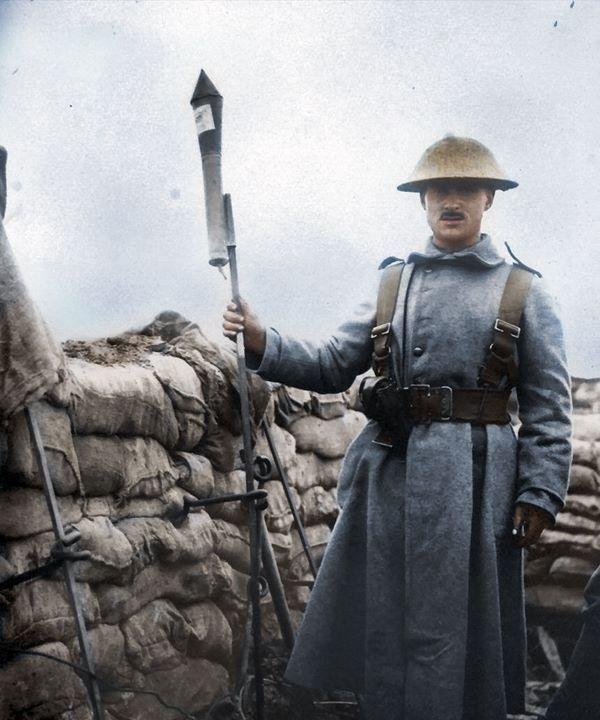 Throughout the cloudy and windy day, the 372nd Infantry remained engaged with the Germans and encountered stiff resistance from a hill that had been fortified overnight. Due to the deeply muddy conditions, the support from French artillery was completely ineffective at keeping the German machine-guns and artillery at bay.
Throughout the cloudy and windy day, the 372nd Infantry remained engaged with the Germans and encountered stiff resistance from a hill that had been fortified overnight. Due to the deeply muddy conditions, the support from French artillery was completely ineffective at keeping the German machine-guns and artillery at bay.
Between 27 September to 1 October 1918, casualties were mounting up for the 93rd Division. The 369th suffered 783 casualties, with 122 soldier Killed In Action and 663 wounded. Meanwhile, the 371st and 372nd Infantry Regiments had sustained 1,275 casualties with the 371st having 107 Killed In Action and 769 wounded; while the 372nd saw 62 Killed In Action and 337 wounded.
2 October 1918:
 At midnight between 1 October and 2 October 1918, the French 157th Division issued orders detailing that the three attacking battalions zone of action would be from vertical grid line 281.5 west to vertical grid line 280.
At midnight between 1 October and 2 October 1918, the French 157th Division issued orders detailing that the three attacking battalions zone of action would be from vertical grid line 281.5 west to vertical grid line 280.
In the early morning, the French 120th Division advanced along the ridges north of Croix des Soudans, however, were unable to entirely clear their zone of action from German defenders; subsequently the French 120th Division did not provide the rocket signal as planned. The French IX Corps, however, still mistakenly believed the ridges were cleared and ordered the French 157th Division to attack.
The assault battalion of the 372nd Infantry, with the French battalions on either side, began their attack under heavy rain, gusty winds and cloudy skies at 1350 hours (1:50 P.M.) behind a rolling artillery barrage.
The Germans rendered heavy resistance and made the advance exceedingly difficult, nonetheless the 2nd Battalion reached a position about 800 meters south of Monthois with battalions of the French 333rd abreast.
Regardless of the 372nd’s success, the American First Army and French Fourth Army had great difficulty in advancing. The French XXXVIII Corps was being held up at Binarville to the 372nd Infantry’s east while the French II Corps couldn’t overcome the German defenses at Blanc Mont Ridge.
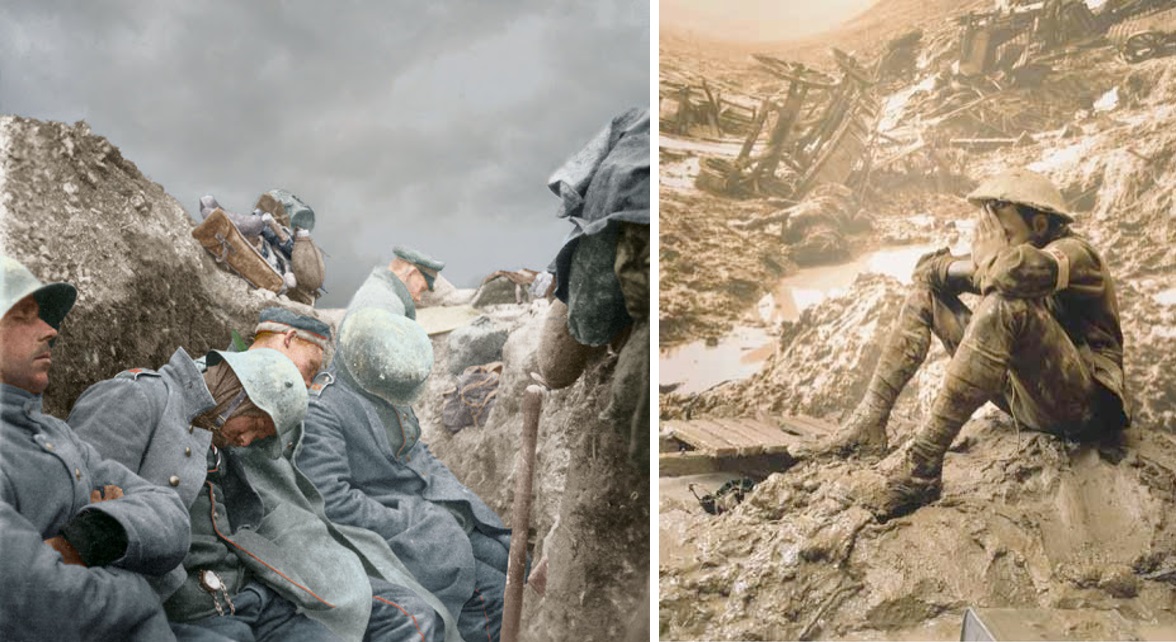
3 October 1918:
As the heavy rain, gusty winds, and cloudy skies continued into the next day, the French 157th Division informed its regiments of resent progress made by the French 161st Division at 0300 hours (3:00 A.M.). The French 161st Division, located to the east of the French 157th Division, had captured the town of Challerange; however, the French 120th Division to the east was still unable to make any progress on the slopes of Croix des Soudans.
At 0525 hours (5:25 A.M.), the 372nd Infantry issued field orders that gave detailed information for the order of attack on Monthois should the French 120th Division succeed in taking the slopes southwest of the town. However, the French 120th Division made no gains throughout the day and the 372nd Infantry made no changes in its position for the day as a result.
During the day, German General Georg von der Marwitz issued orders to his soldiers stating:
4 October 1918:
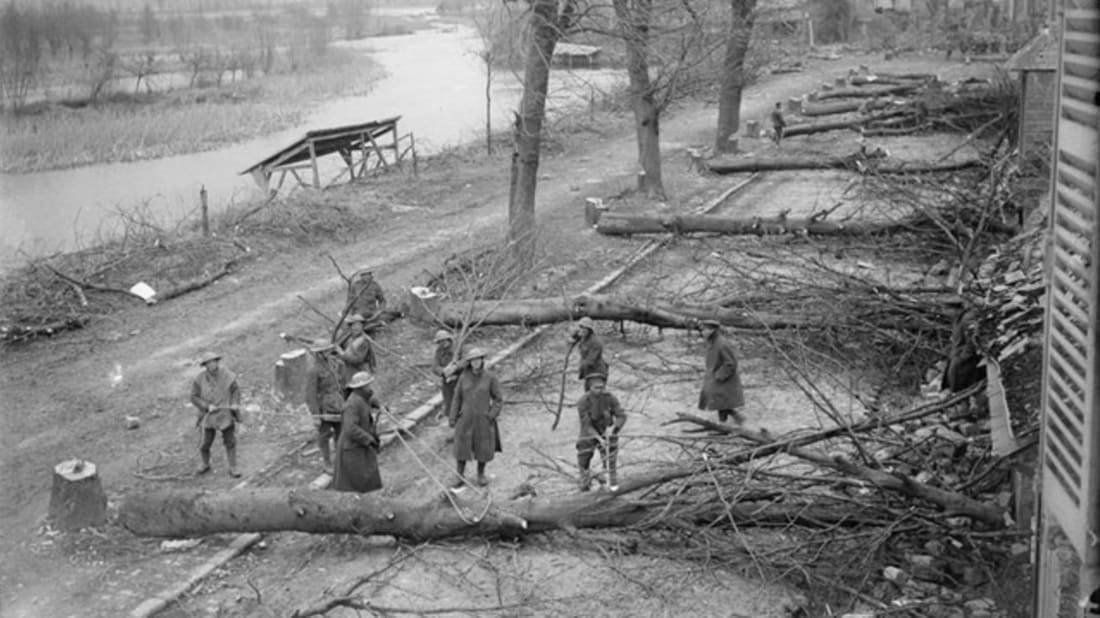 The rain in Monthois was letting up, however, 4 October 1918 was still gusty and the clouds remained overhead. The Germans were participating in their tactical withdrawal and retreating to a valley where a supply base stood. As the Germans withdrew from the area, they destroyed anything they couldn’t move by burning or blowing it up.
The rain in Monthois was letting up, however, 4 October 1918 was still gusty and the clouds remained overhead. The Germans were participating in their tactical withdrawal and retreating to a valley where a supply base stood. As the Germans withdrew from the area, they destroyed anything they couldn’t move by burning or blowing it up.
“October 4, 1918, the 2nd Battalion [372nd Infantry Regiment] is going in this morning, and we are still resting at Vieox, which is about four kilometers from Monthois and is one of the enemy’s railroad centers and hospital bases. The enemy is busy destroying supplies and moving wounded. We can see trains moving out of Monthois. Our artillery is bombarding all roads and railroads in the vicinity. The enemies’ fire is fierce and we are expecting a counter-attack.“
5 October 1918:
The heavy rain returned on 5 October 1918, with increased winds and cloudiness over the heads of the 372nd Infantry Regiment. In the zone of action of the French 157th Division the attack on Monthois was still planned to take place after the French 120th Division had captured Croix de Saingly, however, because the French 120th Division failed to accomplish its mission the plans remained postponed.
The German artillery bombarded the line of the 372nd Infantry and a German counterattack commenced after its conclusion. The 372nd Infantry remained in its position and the fighting became intense and hand-to-hand combat ensued. The German counterattack against the front of the 2nd Battalion was unsuccessful and the Germans suffered heavy losses. The 2nd Battalion of the 372nd was able to fend off the German attack, capturing prisoners in the process. No significant changes in the line had been made, although it was claimed that the 372nd Infantry “continued [its] advance and are now on the outskirts of Monthois.”
6 October 1918:
The sky above the 372nd Infantry finally opened up and 6 October 1918 proved to be a sunny day with cool winds. With the weather proving to be blissful in comparison to the rain and strong winds they had encountered for the past few days, the most encouraging part of the day was the reception of orders from the French 157th Division that it was to be relieved by the French 125th Division during the night. Things continued to look up as the liaison work of the French 157th proved to be exceptional.
“I am proud to forward you here with the thanks and congratulations of General Garnier-Duplessix and I want the same time, dear friends of all ranks, Americans and French, to tell you as your leader and as a soldier, from the bottom of my heart how grateful I am to you all for the glory you have acquired for our splendid [French] 157th Division [371st and 372nd attached].” – General Mariano Goybet, commander of the French 157th Division

During the overnight relief, the Germans bombarded the 372nd Infantry’s line as the French 333rd Infantry attacked and pushed the Germans further back. The 371st and 372nd Infantry Regiments were ordered to take station north and south of Ruisseau de Marson, near Beausejour Farm after being replaced by elements of the French 125th Division.
In total the 369th, 371st, and 372nd Infantry Regiments had suffered a total of 2,502 casualties, including 418 Killed In Action.
7 October 1918:
Although the French 125th Division was relieving the French 157th Division and subsequently the 371st and 372nd Infantry Regiments, elements of the 372nd Infantry continued to patrol the area of Monthois and engage the enemy until they were fully relieved.
Once the French 125th Division were done relieving the French 157th Division and the 371st Infantry Regiment in the frontline, they took command the following morning at 0500 hours (5:00 A.M.), the 371st and 372nd Infantry Regiments headed to their destination near Beausejour Farm (approximately 20 kilometer south).
The 369th Infantry Regiment was relieved from their position near Bellevue Signal Station, where it had remained in reserve for the French 161st Division throughout the night of 6 October and into the morning of 7 October 1918. The 369th was ordered to move with the French 161st Division to Vitry-le-Francois, roughly 80 kilometers south, and the French 161st Division passed to French IX Corps Reserve.
8 October 1918:
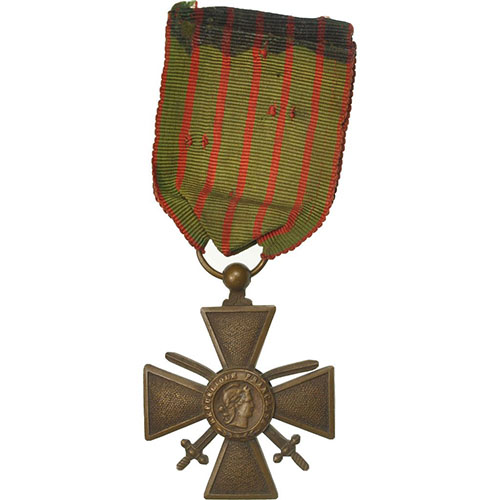 After the French 157th and 161st Divisions had been relieved, all three infantry regiments of the 93rd Division (excluding the 370th Infantry) spent time for rest and rehabilitation in their southern positions from the frontline. The 2nd Moroccan, French 157th and 161st Divisions were transferred from the French IX Corps to the French X Corps. It was at this time that Colonel Herschel Tupes, commander of the 372nd Infantry Regiment, learned that the unit had been recommended for the Croix de Guerre citation found within the general orders of the French Army to be pinned to the units regimental colors.
After the French 157th and 161st Divisions had been relieved, all three infantry regiments of the 93rd Division (excluding the 370th Infantry) spent time for rest and rehabilitation in their southern positions from the frontline. The 2nd Moroccan, French 157th and 161st Divisions were transferred from the French IX Corps to the French X Corps. It was at this time that Colonel Herschel Tupes, commander of the 372nd Infantry Regiment, learned that the unit had been recommended for the Croix de Guerre citation found within the general orders of the French Army to be pinned to the units regimental colors.
9 October 1918:
The 372nd Infantry Regiment marched south and reached Somme Bionne where it stayed until 11 October 1918 to entrain for Vignemont.
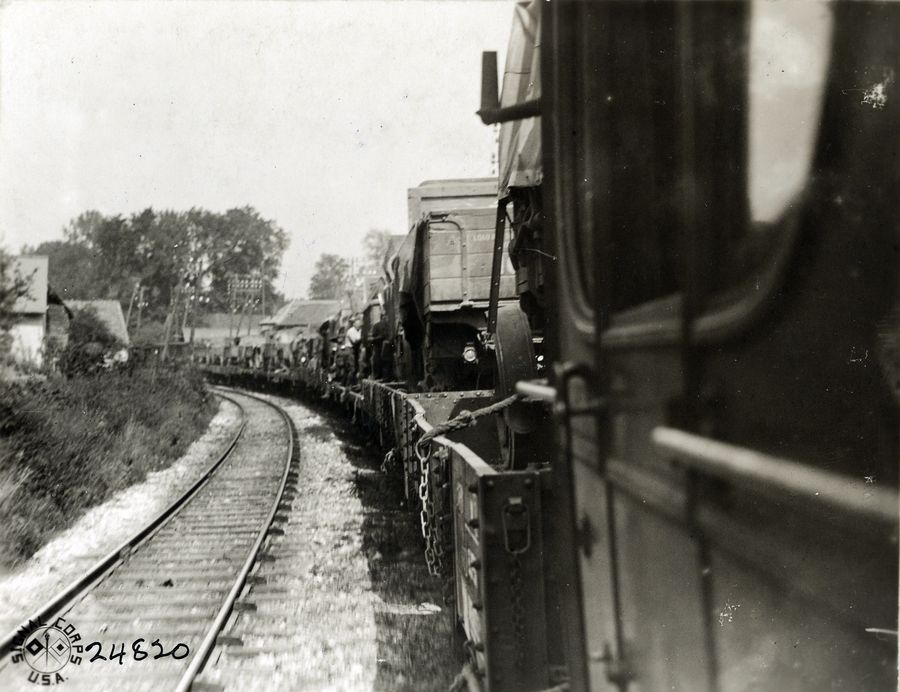
11 October 1918:
 The French 157th Division, including the 371st Infantry Regiment, moved from Saint Menehould 60 kilometers north of Belfort to the area of Corcieux. Meanwhile, the 372nd Infantry Regiment left Somme Bionne and entrained for Vignemont.
The French 157th Division, including the 371st Infantry Regiment, moved from Saint Menehould 60 kilometers north of Belfort to the area of Corcieux. Meanwhile, the 372nd Infantry Regiment left Somme Bionne and entrained for Vignemont.
12-13 October 1918:
At 0800 hours (8:00 A.M.) on 12 October 1918, the 372nd Infantry left Valmy, France to their destination of Vignemont, where they had arrived the following day. Upon arrival, the 372nd Infantry hiked an additional 15 kilometers to Saint Leonard and arrived later the same day (13 October 1918).
13 October to 11 November 1918:
From 13 October to 11 November 1918 (Armistice Day), the 371st Infantry Regiment participated in the occupation of the Anould Sector located northeast of Corcieux where it remained in relative peace until the war ended.
On 14 October 1918, the French 161st Division, including the 369th Infantry Regiment, moved just north to the city of Belfort where it participated in occupying the Thur Sector. The French 161st Division and the 369th Infantry Regiment would occupy this sector until the war was ended on 11 November 1918 at 1100 hours (11:00 A.M.).
On 15 October 1918, the 372nd Infantry Regiment left Saint Leonard and arrived at Ban de Laveline in the Department of the Bosges at 2215 hours (10:15 P.M.).
